Quick Answer
There are 9 primary face shapes for men, and you can identify yours according to the following measurements and facial characteristics:
-
- Oval face – your face is egg-shaped, longer than wide, with a gently curved jawline (like George Clooney)
- Round face – your face looks circular with full cheeks and no sharp angles (like Leonardo DiCaprio)
- Square face – your jawline has sharp angles, and your forehead, cheeks, and jaw are equally wide (like Tom Hardy)
- Rectangular face – you have a straight jawline with sharp corners and a long face (like Henry Cavill)
- Heart-shaped face – you have a broad forehead that narrows down to a small, pointed chin (like Bradley Cooper)
- Triangle face – your jawline is wider than your forehead (like Timothée Chalamet)
- Diamond-shaped face – your cheekbones are the widest part of your face, with a narrower forehead and jaw (like Robert Pattinson)
- Oblong face – your face is long with rounded jawline corners instead of sharp angles (like Shawn Mendes)
- Pear-shaped face – your face starts narrow at the top and gets wider at the bottom (like Jason Derulo).
Key Styling Points to Remember
- For oval faces, choose classic cuts with clean lines, and avoid styles that fall heavily to one side. Most beard styles work well, maintain clean lines following your jaw’s curve.
- For round faces, style hair with height at the crown and shorter sides. Avoid cuts ending at cheekbones. Choose a goatee or oval-shaped full beard that extends below the jaw.
- For oblong faces, opt for styles adding width rather than height, keep sides fuller. Choose rounded beard styles to complement softer facial angles.
- For square faces, opt for short sides with longer, messier tops. Select round or oval glasses to contrast your angular features.
- For rectangular faces, choose mid-length cuts with volume at the sides rather than height. For added width, select fuller, rounded beard styles.
- For triangle faces, add volume on top and at temples, and keep beard styles shorter and well-groomed to avoid adding extra jaw width.
- For heart faces, reduce forehead width while adding volume at the chin level. Choose fuller beard growth through the chin and jaw areas.
- For pear faces, add volume at the crown and temples while keeping the sides proportional. Keep beard styles shorter to avoid emphasising the wider jaw.
- For diamond faces, add width at the forehead with textured layers. Maintain a well-groomed beard that connects with your cheekbones.
Want to learn more? Continue reading the full article below ↓
Understanding your unique face shape is a cornerstone of personal style, grooming expertise, and self-presentation.
In modern society, where visual impressions carry unprecedented significance, mastering the nuances of facial structure can provide an invaluable advantage in personal and professional spheres.
In this comprehensive analysis, we’ll delve into the intricate world of men’s face shapes, providing a deeper understanding of how facial structure influences your hairstyle, eyewear, and accessory selection.
The 9 Face Shapes for Men
1. Oval Face Shape
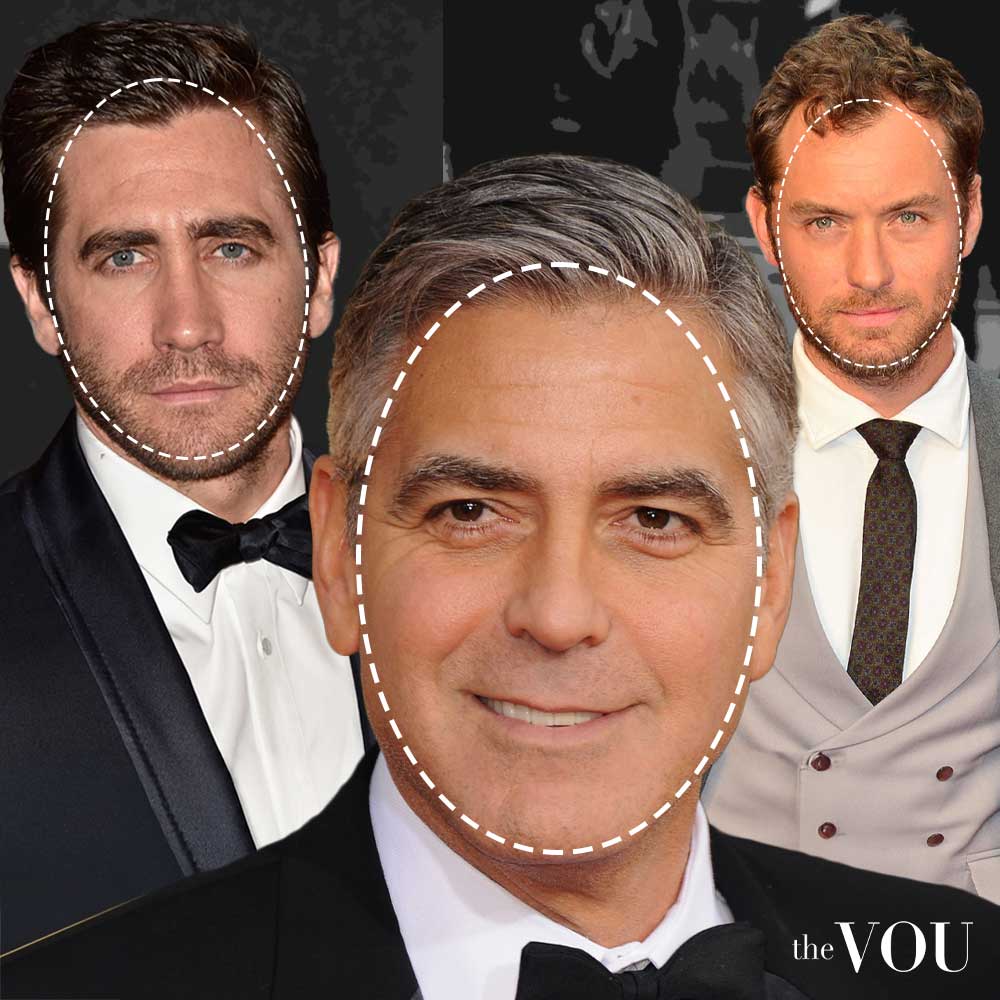
Imagine an egg standing upright—that’s essentially an oval face shape.
This face shape is described in various ways across different sources, such as the egg-shaped face, elliptical face shape, balanced face, medium-long face, proportional face shape, or classical face shape.
The length of an oval-shaped face is about one and a half times its width, and the forehead and jaw are slightly narrower than the cheekbones, but the differences aren’t dramatic.
The sides of the face curve gently rather than having sharp angles.
Think of celebrities with Oval face shape like Idris Elba, George Clooney, Jude Law, or Jake Gyllenhaal—they all have oval faces in various variations.
The oval face shape serves as a baseline for other shapes, as many face shapes are essentially variations of the oval – either stretched, widened, or angular.
That’s why you’ll sometimes hear people say oval is the “ideal” face shape, though this is more about its versatility than actual appearance.
Ideal Haircuts for Men with Oval Face Shape
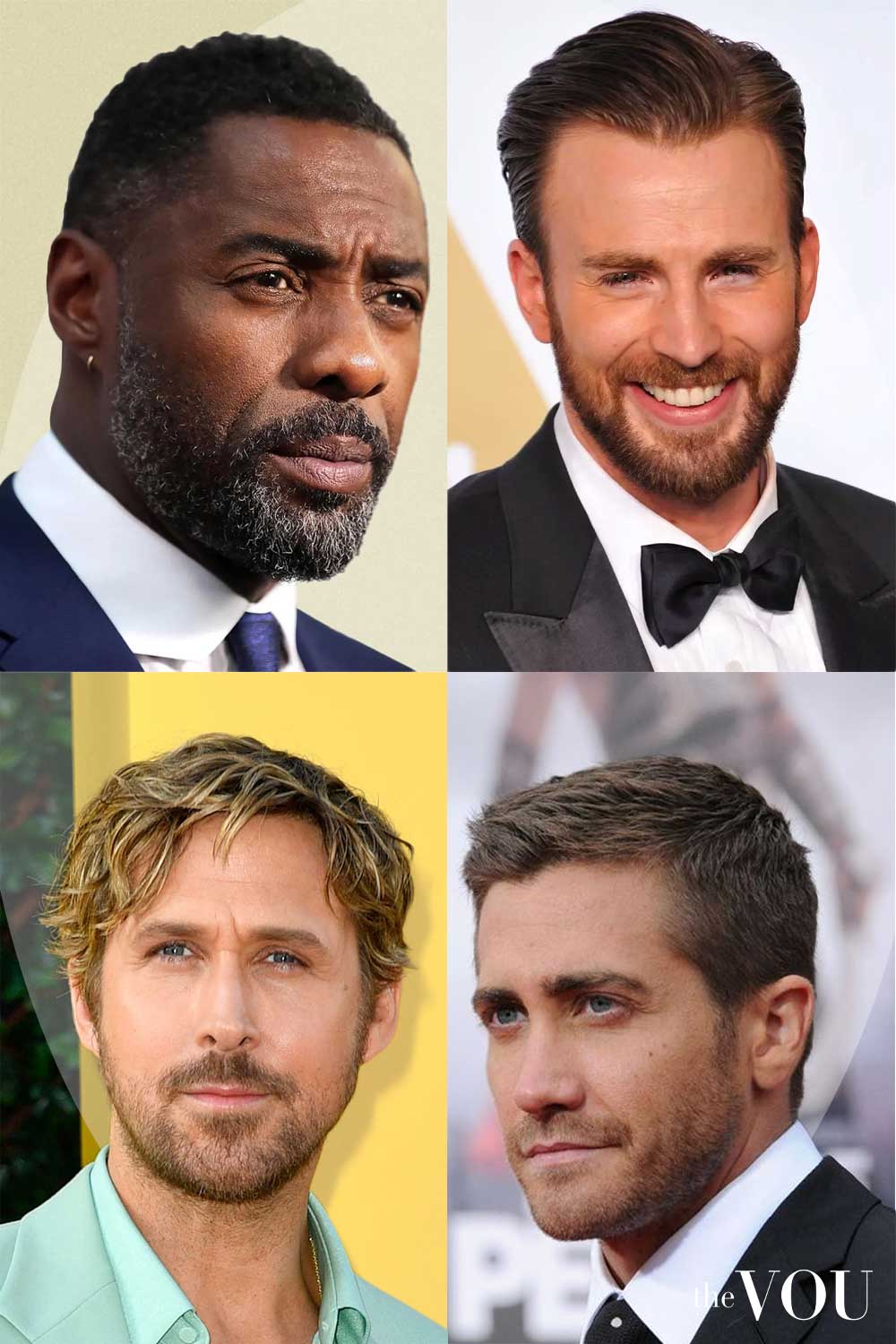
Men with oval faces enjoy the most versatility in haircut choices, thanks to their naturally balanced proportions.
Classic cuts with clean lines and proportionate length work exceptionally well, as George Clooney’s timeless side part demonstrates.
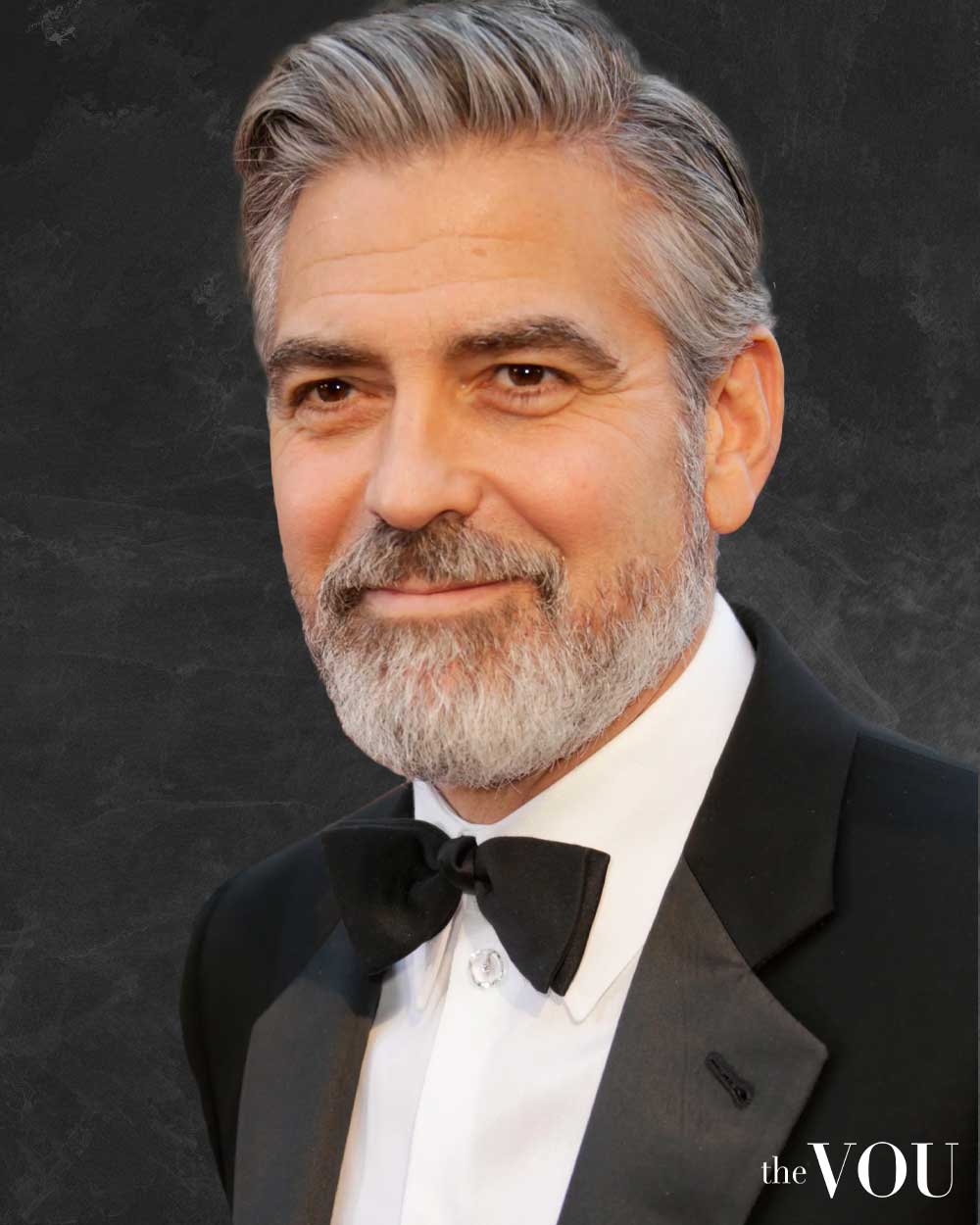
Your goal should be maintaining the harmony of your features while adding subtle definition where desired.
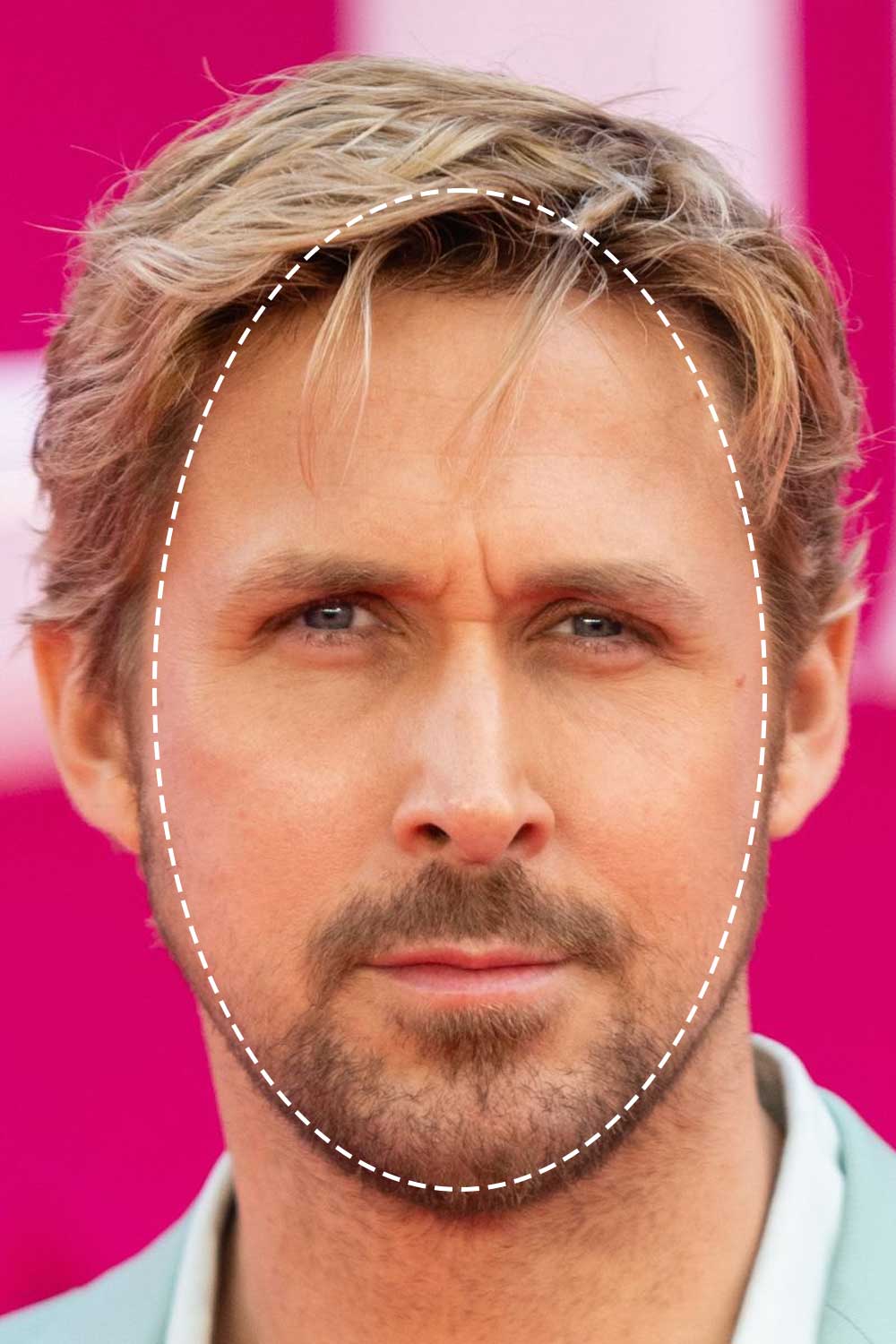
Focus on styles that preserve your natural balance without adding excessive volume at any point. Avoid anything that drastically alters your natural facial harmony.
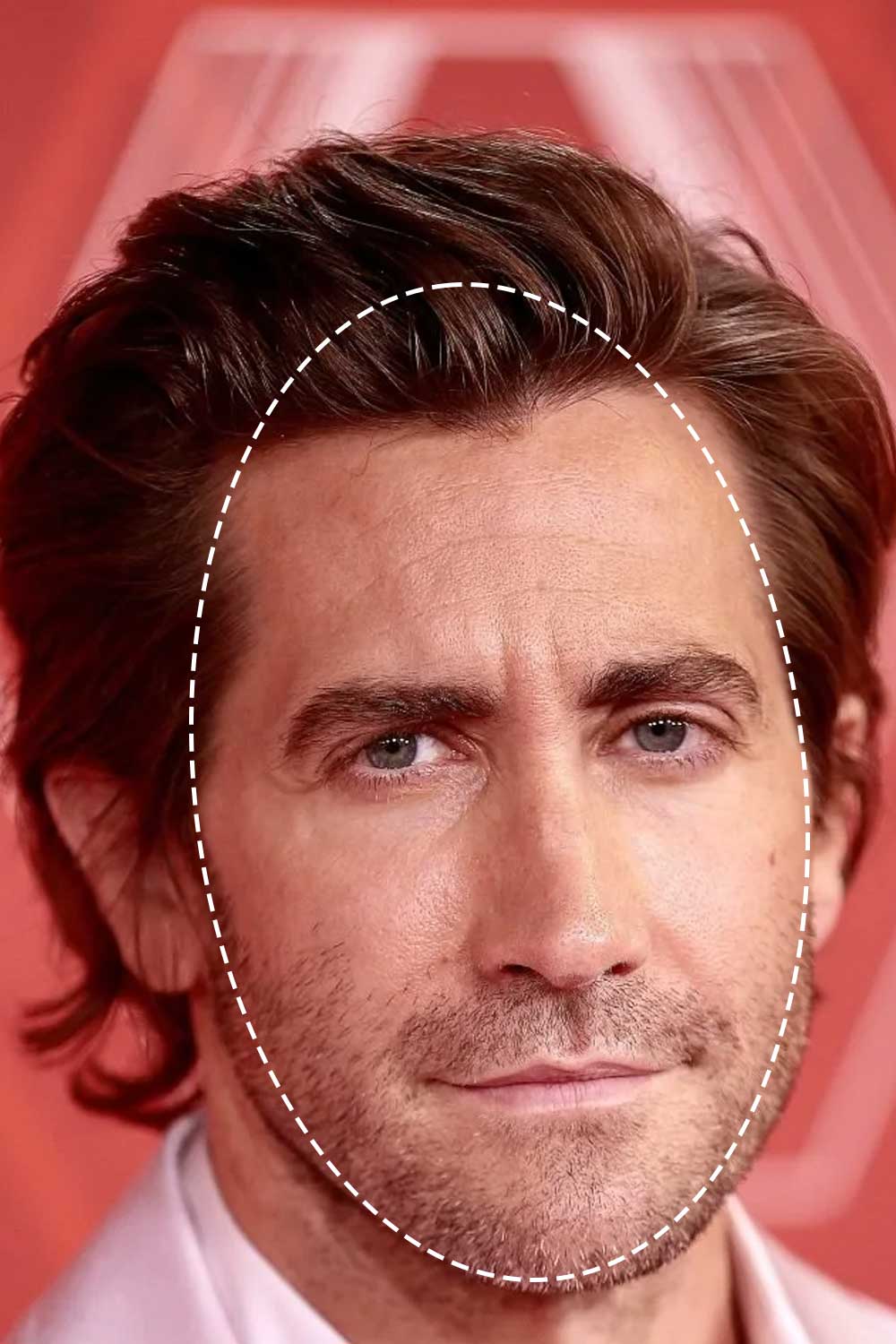
See more haircuts and hairstyles for Oval Face Shape
Ideal Beard Styles for Men with Oval Face Shape
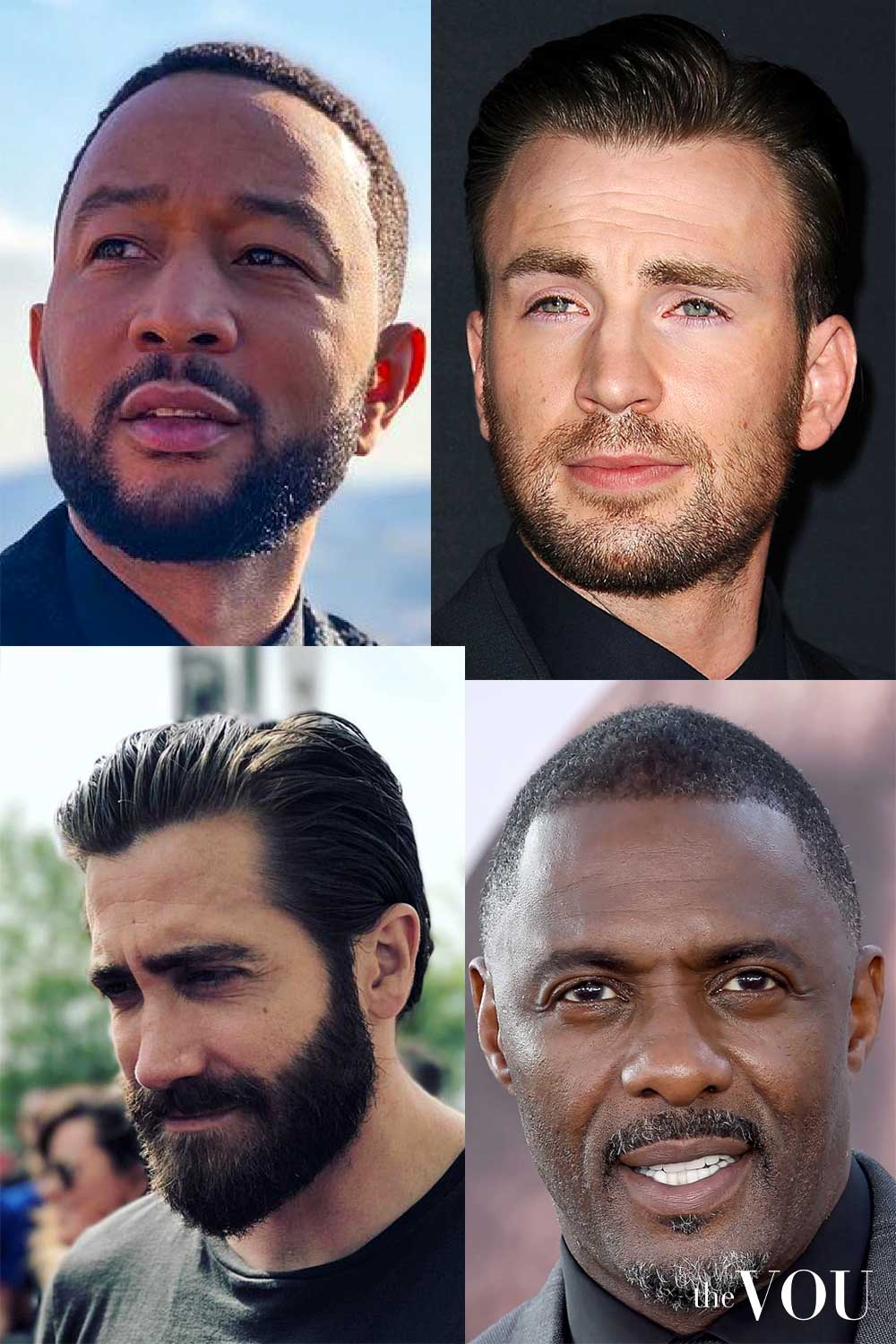
Men with oval faces also enjoy exceptional versatility in beard styling choices. Your balanced proportions allow you to experiment with various styles while maintaining your natural facial harmony.
The Classic Full Beard (12-15mm) offers excellent results, as demonstrated by Jake Gyllenhaal’s well-maintained approach.
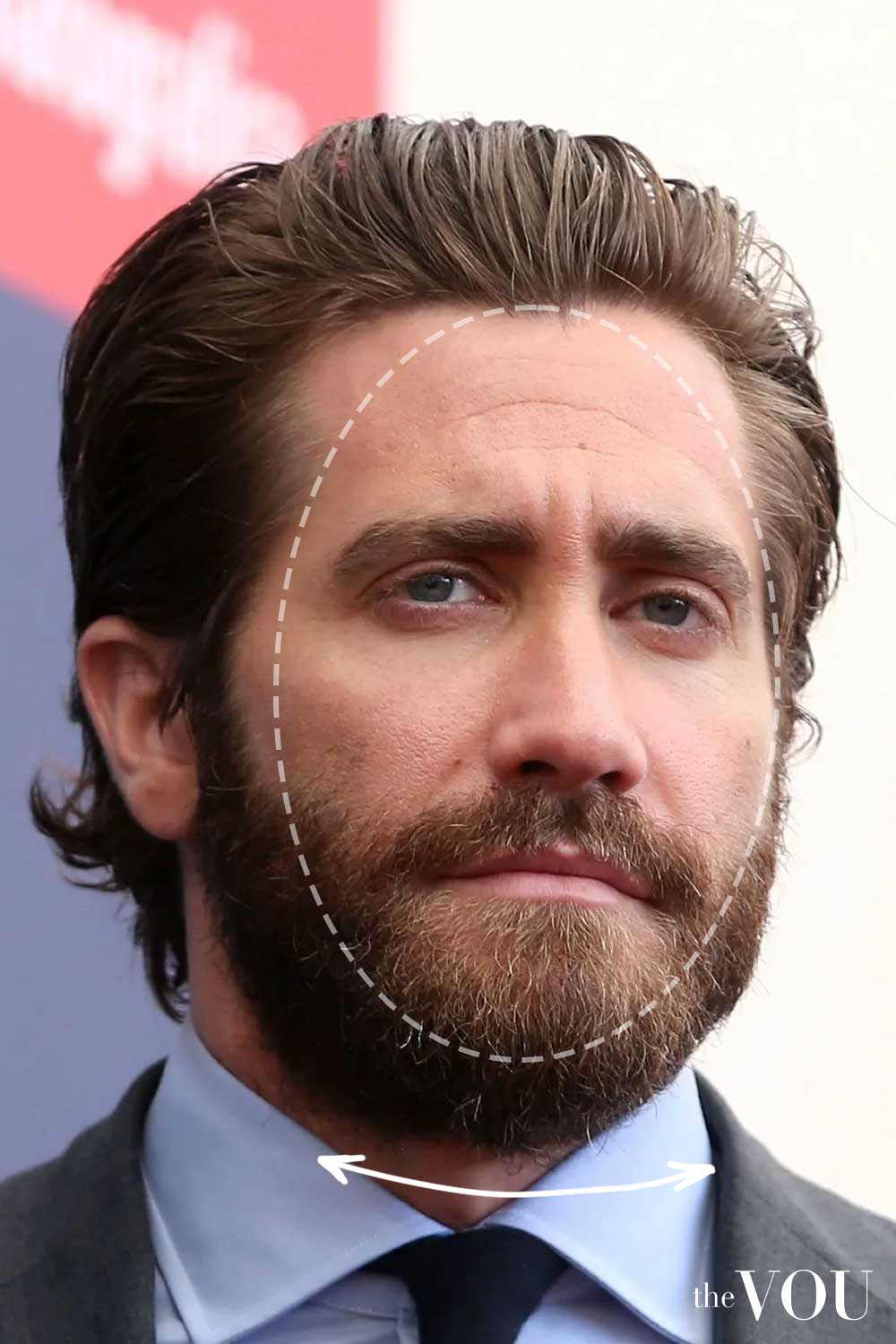
The Short Boxed Beard (6-8mm), like John Legend’s precise styling, provides a refined, professional appearance that enhances natural features.
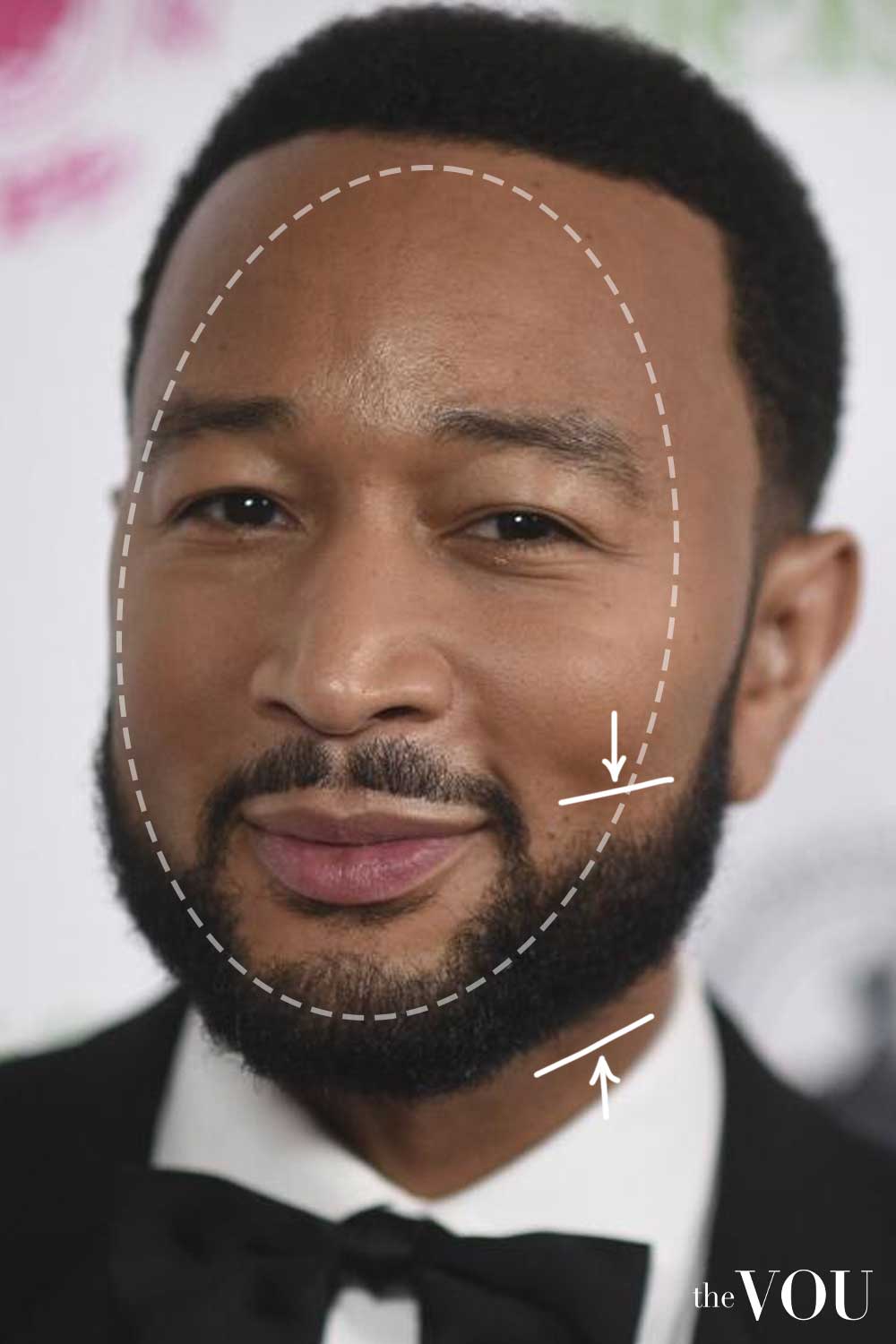
Heavy Stubble (4-5mm), Van Dyke, and Corporate Beard (8-10mm) are also excellent options.
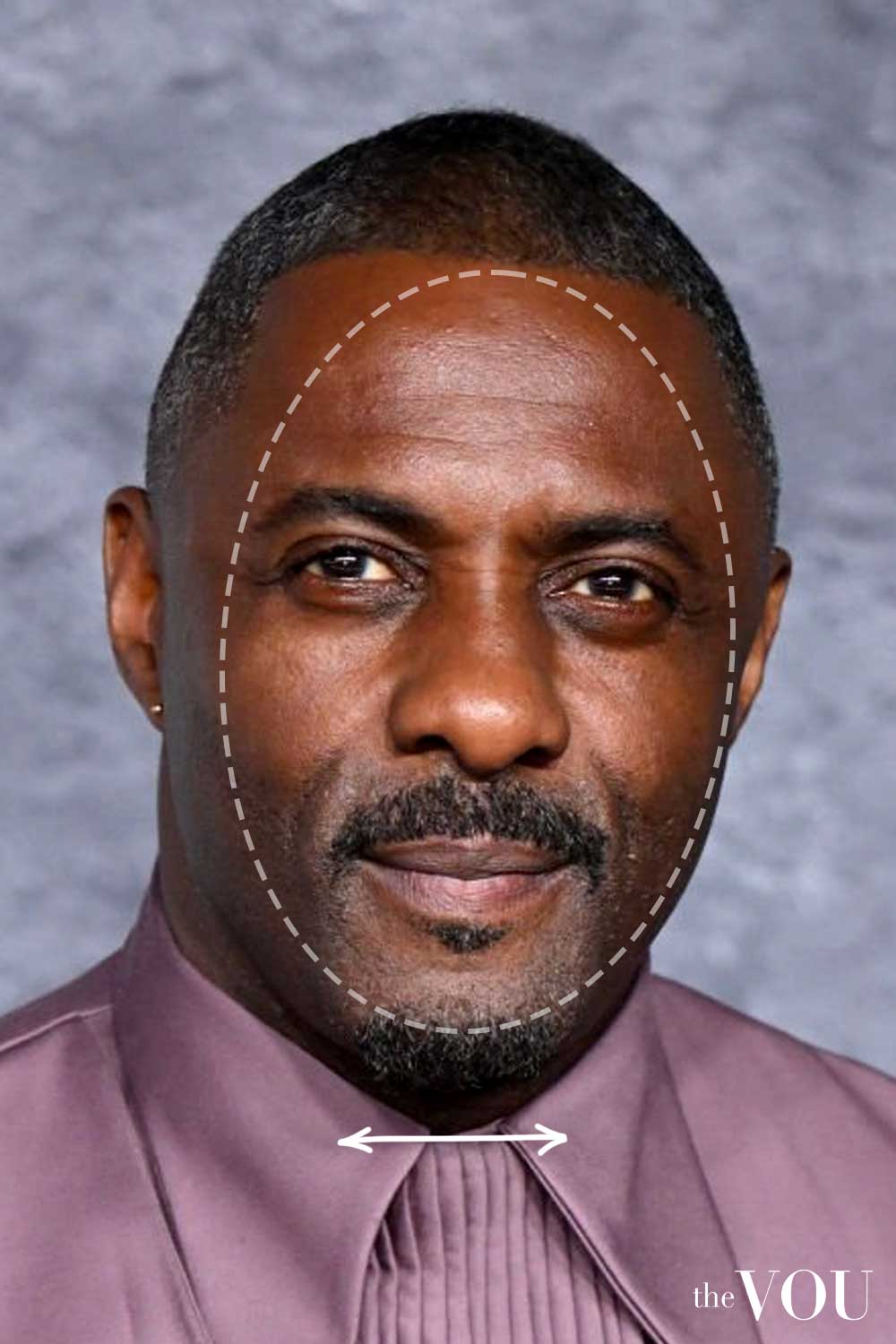
Focus on maintaining clean lines and balanced proportions whilst avoiding styles that dramatically alter your natural facial harmony.
See more beard styles for Oval Face Shape
2. Round Face Shape
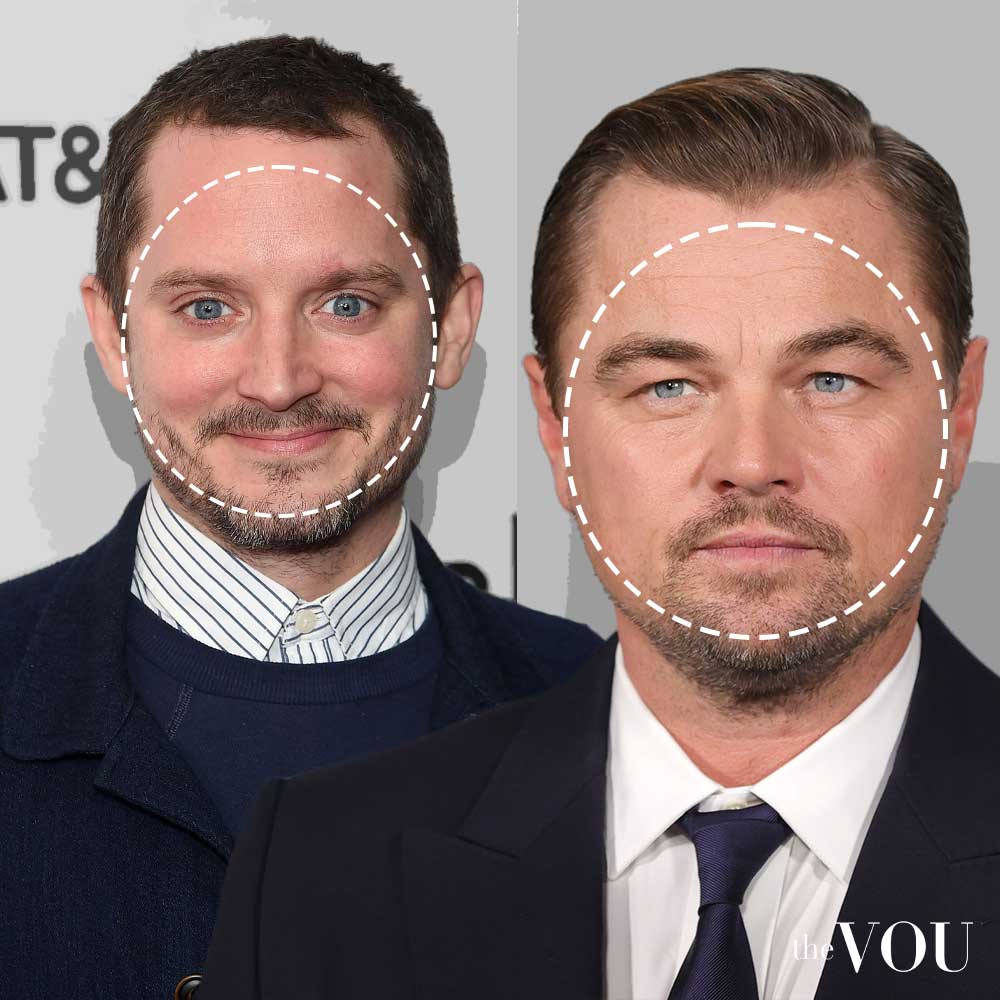
Picture a circle with softened edges—this represents the round face shape.
This shape is referred to as circular face, soft square, full face, curved face, cherubic face shape, moon face, or compact face shape.
A round face features similar width and length measurements, with soft curves rather than angles dominating the features.
The cheeks are typically the widest part of the face, with a gently curved jawline that lacks sharp angles.
Think of round face shape celebrities like Leonardo DiCaprio and Elijah Wood. Notice how their faces appear full without sharp angles.
The roundness doesn’t mean a lack of definition; it’s simply a different facial structure that can look equally masculine and appealing.
Many young men have round faces as this shape often appears more youthful, and the features might become more angular with age.
Ideal Haircuts for Men with Round Face Shape
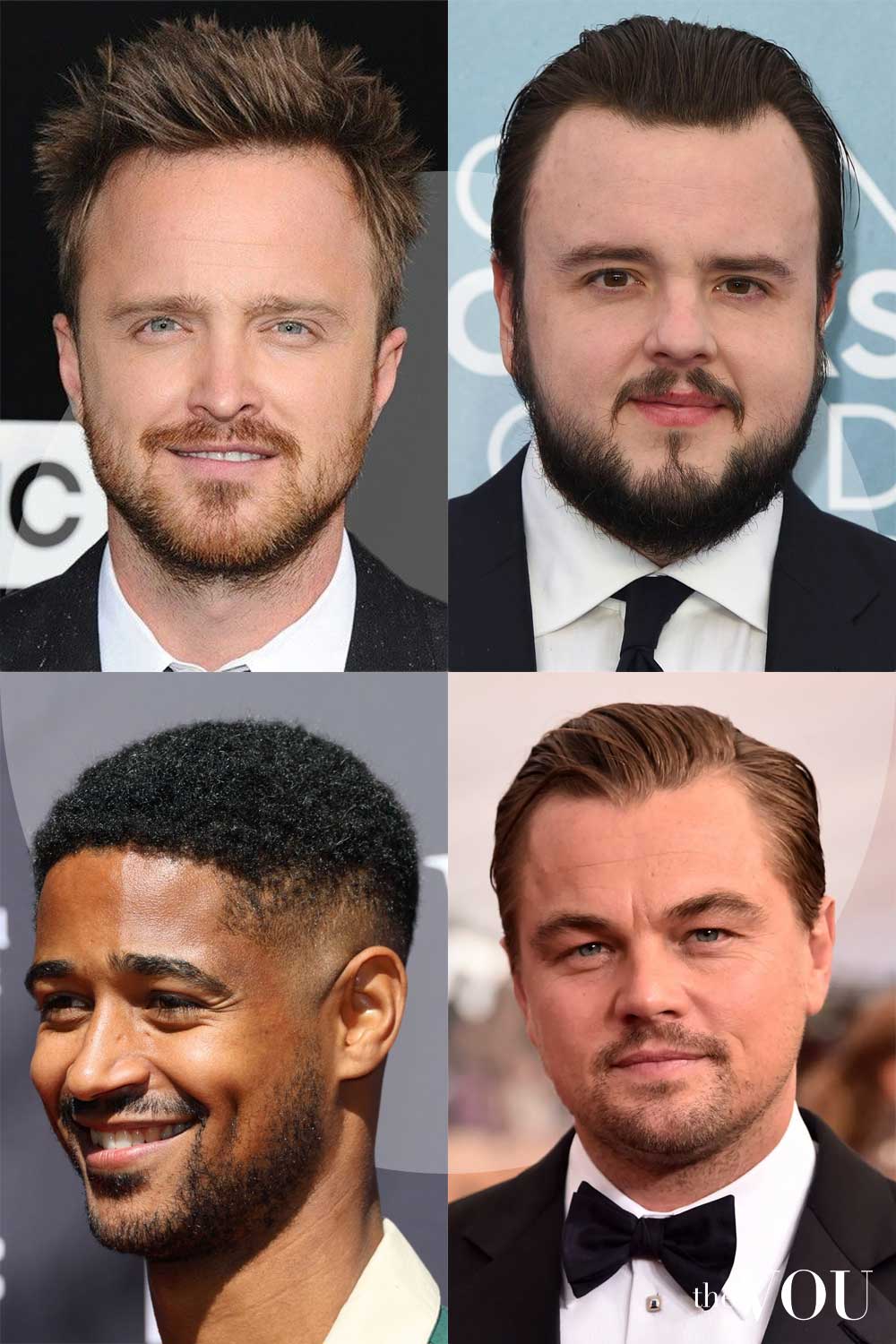
For round faces similar to Leonardo DiCaprio’s, the goal is creating definition and the illusion of length.
Styles that add height at the crown while keeping the sides shorter help elongate your face shape.
Consider following DiCaprio’s approach with a swept-back style that creates vertical lines, or take inspiration from Elijah Wood’s volume-focused cuts.

Your stylist should avoid cuts that end at your cheekbones, as these can emphasise facial roundness.
See more haircuts and hairstyles for Round Face Shape
Ideal Beard Styles for Men with Round Face Shape
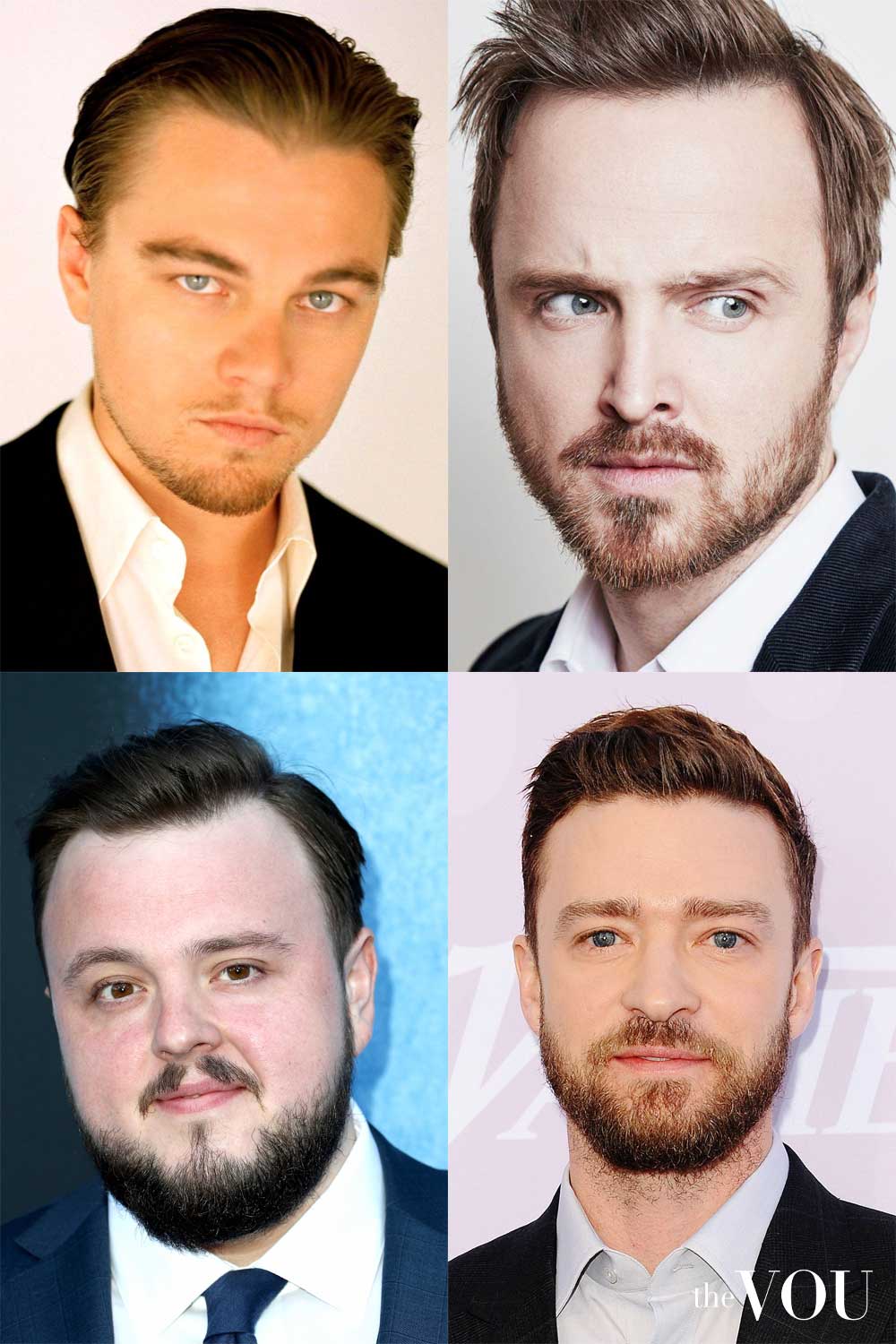
Men with round faces, like Leonardo DiCaprio and James Corden, benefit from beard styles that create definition and visual length to balance softer features.
The Extended Goatee with Length (14-16mm) creates excellent vertical emphasis, as Leonardo DiCaprio’s styling choices demonstrate.
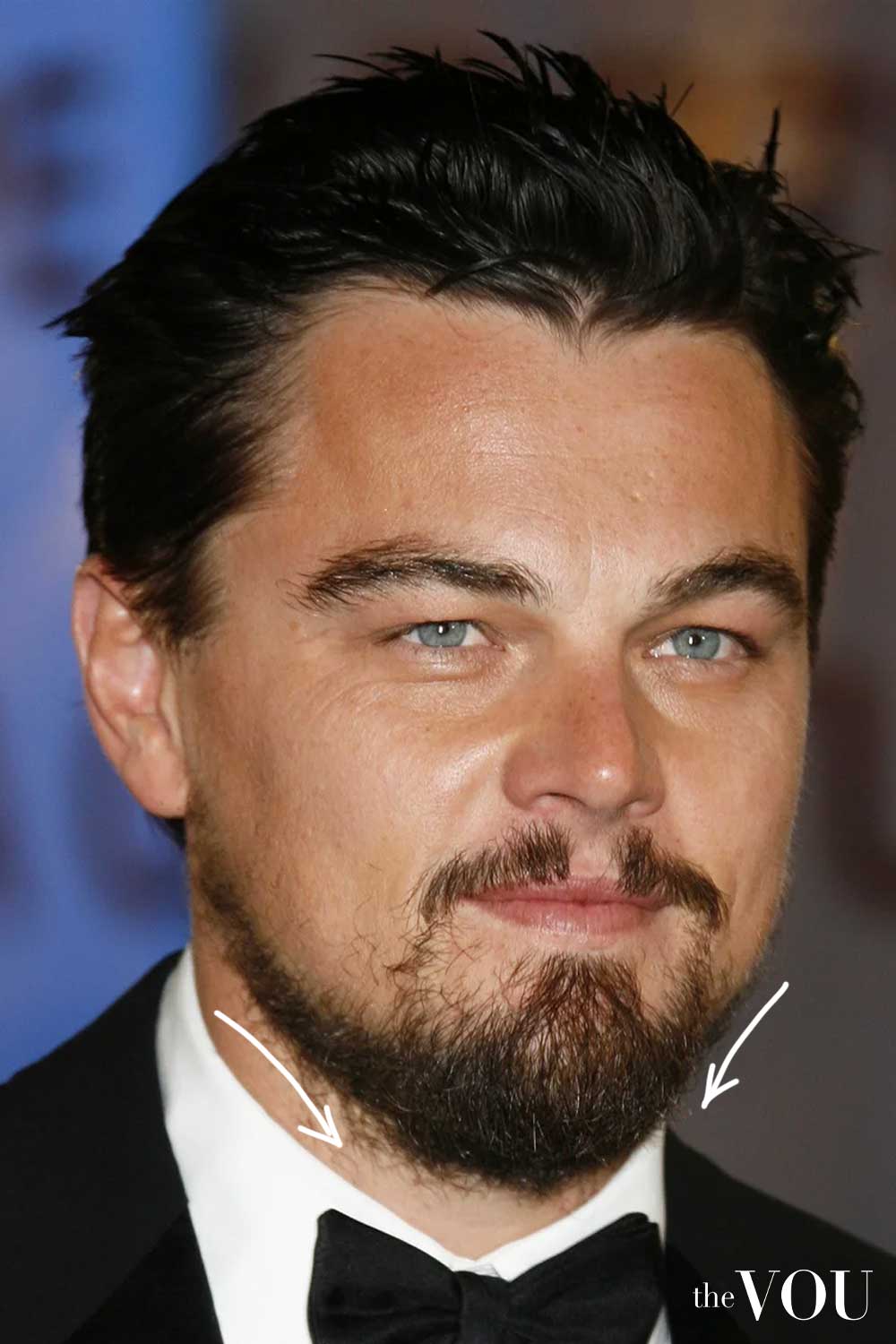
The Angular Full Beard, as worn by Aaron Paul, introduces beneficial definition to naturally curved features.

Your focus should be on styles that add structure and angles whilst avoiding those that emphasise facial roundness.
For optimal results, consider the Tapered Beard (6-14mm), Short Box Beard with Length (8-14mm), or Vertical Growth Pattern (10-12mm).
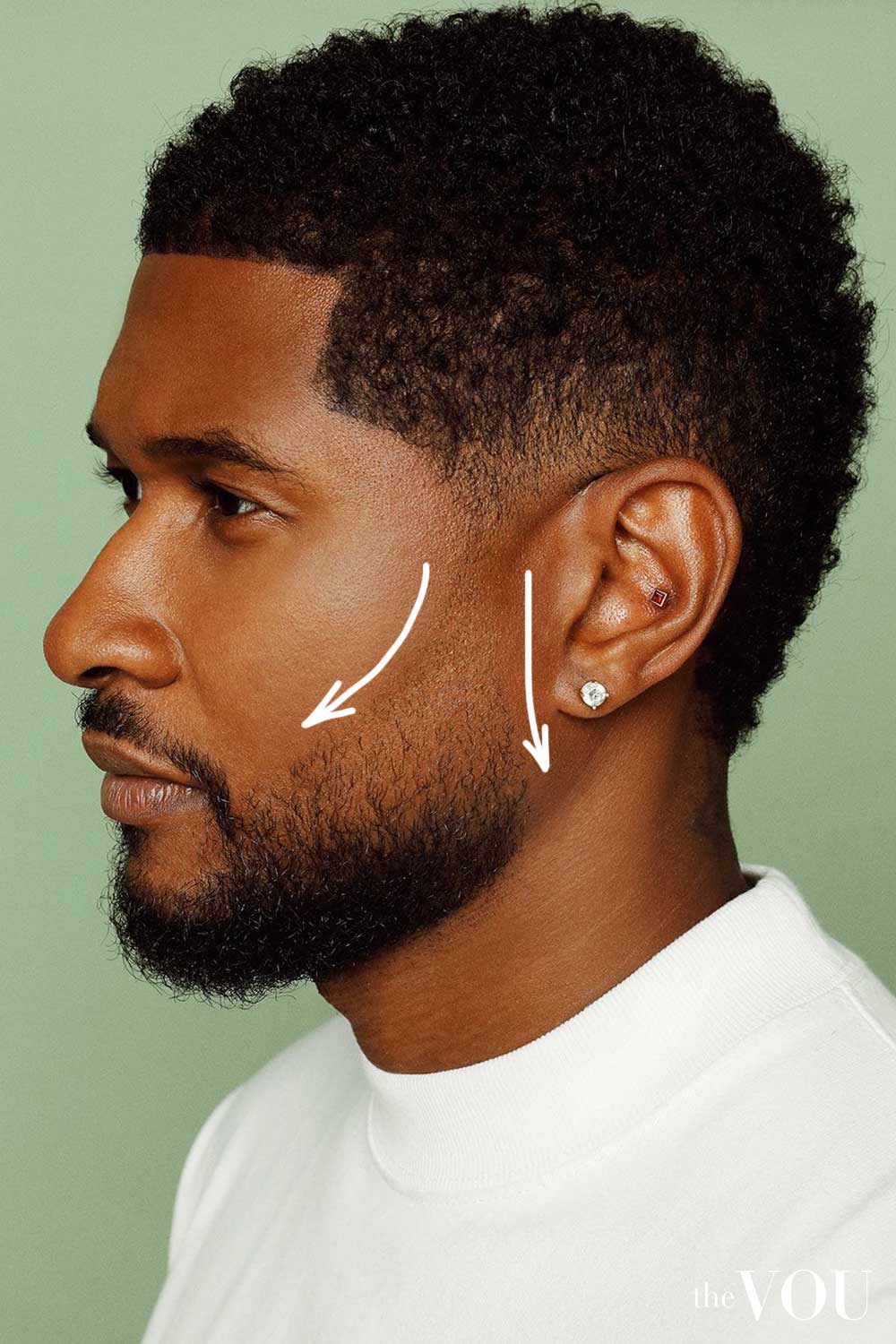
See more beard styles for Round Face Shape
3. Oblong Face Shape

Picture a rectangular face with softer edges – that’s the essence of the oblong face shape.
This shape is also known as elongated oval, soft rectangular, extended oval face shape, or lengthened face shape.
The key characteristic is sharing similar width measurements across the forehead, cheekbones, and jawline, but with significantly greater length than width and softly rounded corners instead of sharp angles.
The face appears longer and narrower overall, with a prominently round chin rather than an angular one.
Shawn Mendes and Benedict Cumberbatch are examples of public figures who demonstrate classic oblong face characteristics.
The main difference between oblong and rectangular faces lies in the edges – where rectangular faces have distinct angles; oblong faces feature softer, more rounded corners.
Many men with oblong faces find their proportions work particularly well with a wide range of styling options, though they often prefer choices that add width rather than height.
Ideal Haircuts for Men with Oblong Face Shape
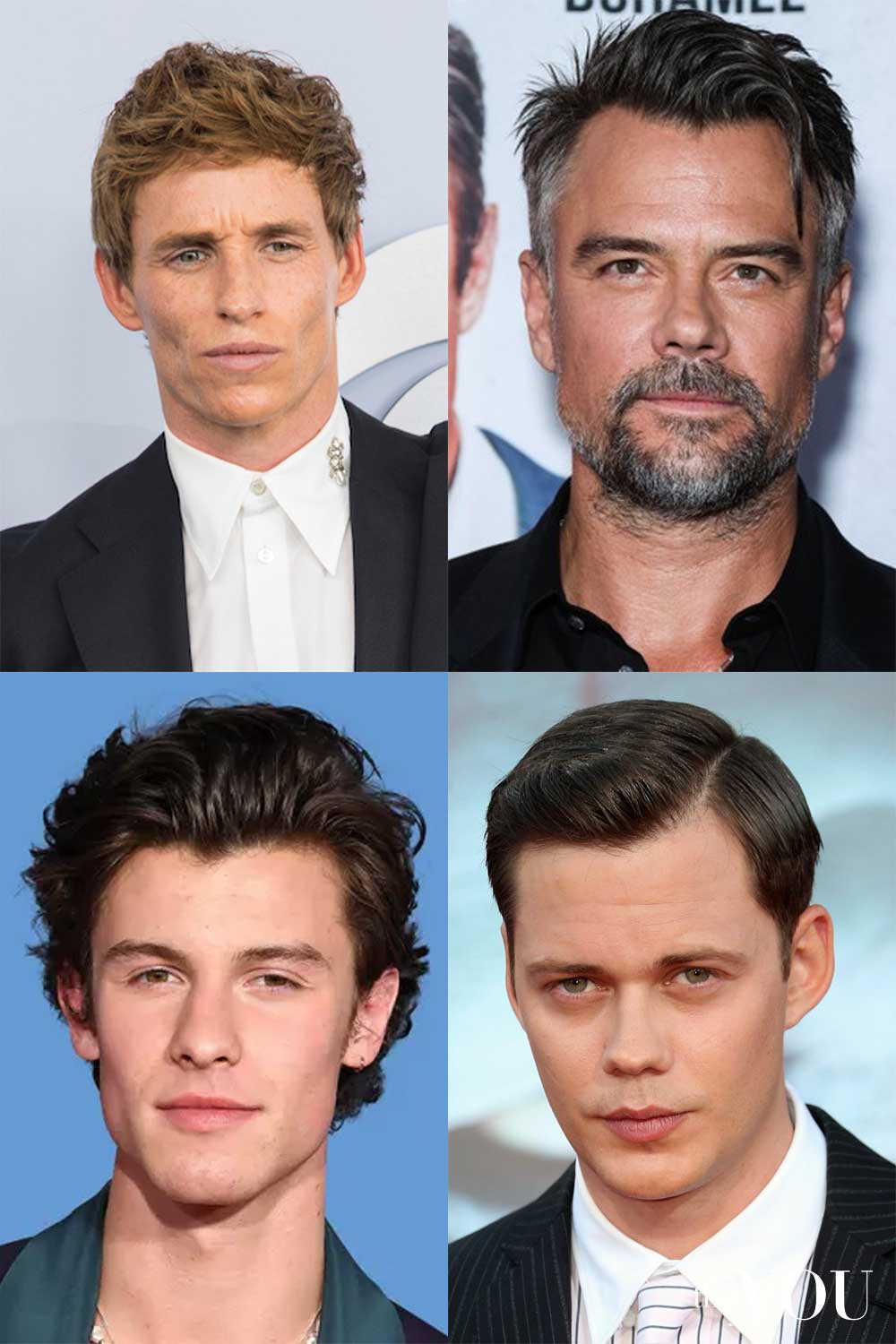
Men with oblong faces, like Shawn Mendes and Paul Rudd, benefit from styles that create width while reducing the appearance of length.
The key is adding volume at the sides while keeping height minimal, as shown by Shawn Mendes’s perfectly balanced styling choices.

Your stylist should prioritise cuts incorporating elements like fringes to reduce face length while maintaining sophisticated proportions.
Work with layering and texture to maximise width, following Paul Rudd’s expert approach to creating balanced facial proportions.

See more haircuts and hairstyles for Oblong Face Shape
Ideal Beard Styles for Men with Oblong Face Shape

For men with oblong faces, beard styles should focus on adding width rather than length.
Consider a Short Boxed Beard with fullness at the sides to create the illusion of a wider face.
Opt for styles that keep the length at the chin minimal while maintaining volume at the cheeks.
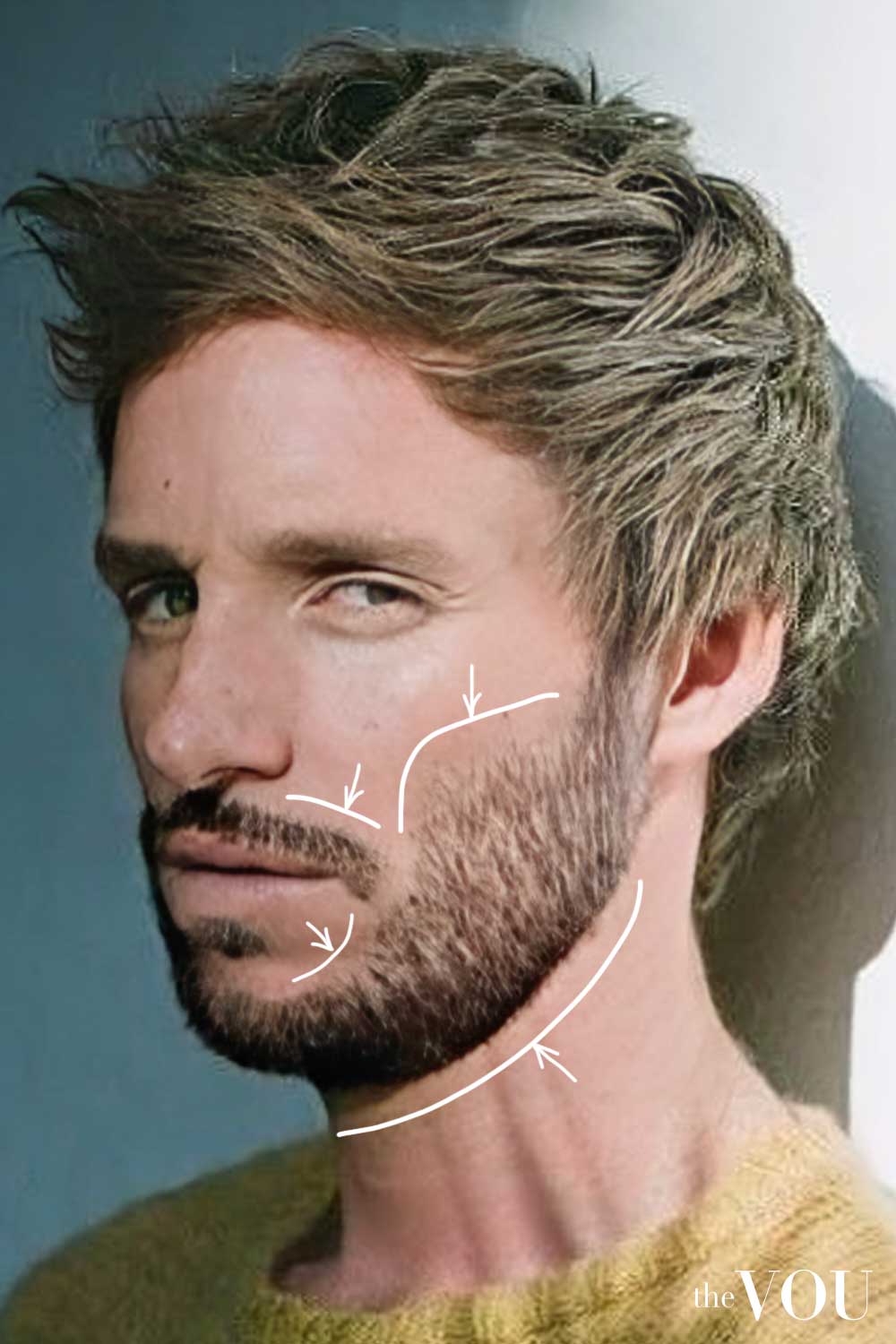
Stubble with defined lines along the cheeks can also help create the appearance of width.
Your beard should work to balance your face’s elongated proportions by visually shortening the face where possible.

See more styling tips for Oblong Face Shape
4. Square Face Shape

Think of a strong, evenly proportioned box – that’s the square face shape.
This shape goes by many names: angular face, strong jaw face, muscular face, boxed face, chiselled face, symmetrical square, or masculine face shape.
Square faces feature similar measurements across the forehead, cheekbones, and jawline, creating an even, powerful appearance.
The essential characteristic is the presence of sharp angles, particularly at the jaw, distinguishing it from the round face shape.
Look at square face shape celebrities like Pedro Pascal, Daniel Radcliffe, Michael B. Jordan, and Simu Liu – their faces showcase clear angles and similar width-to-length proportions.
The square face shape is often considered traditionally masculine due to its strong lines and defined features.
Many men with square faces find that their strong bone structure effectively allows them to carry both clean-shaven and bearded looks.
Ideal Haircuts for Men with Square Face Shape
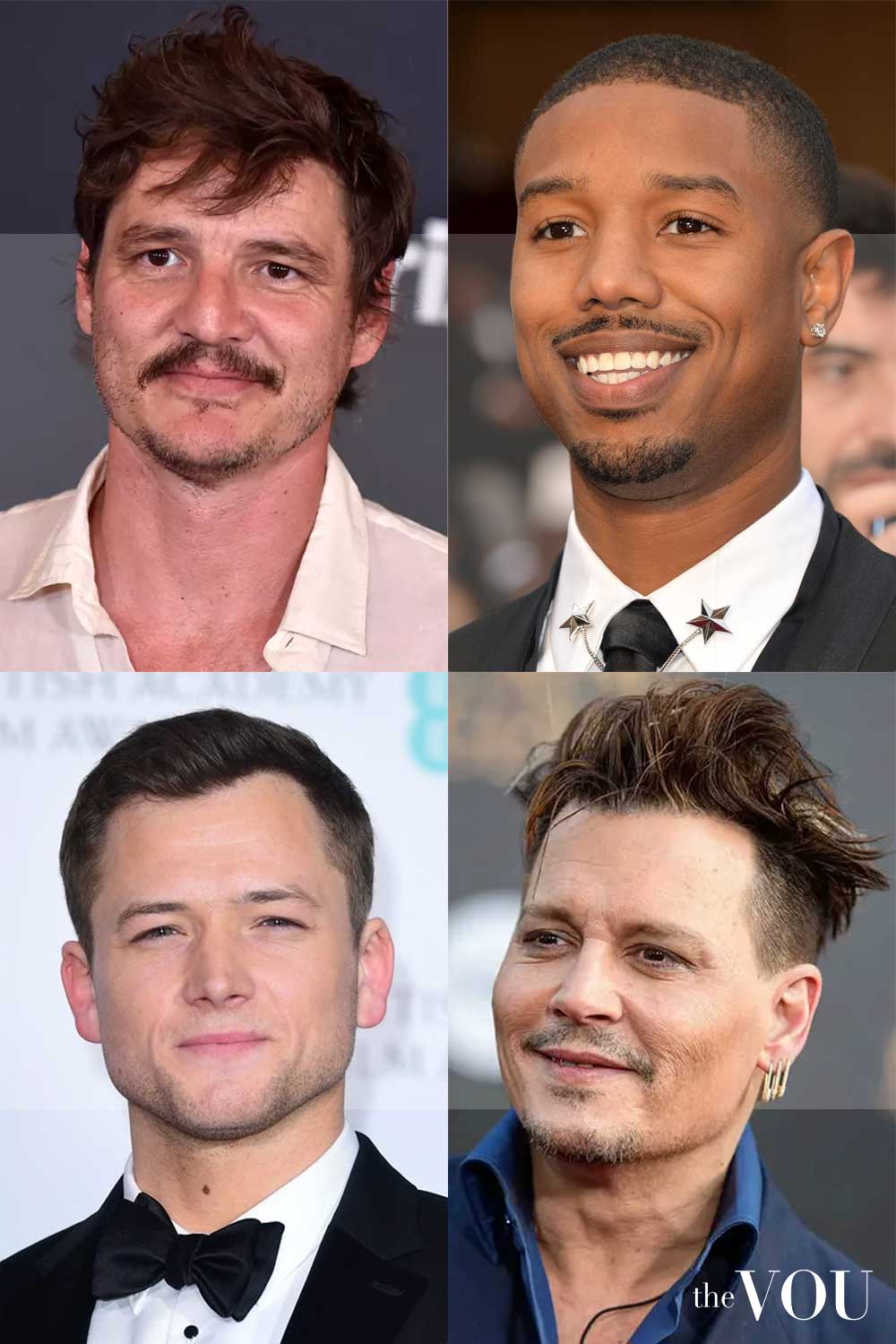
Those with square faces, like Pedro Pascal, can embrace their strong angles for a distinctly masculine appearance.
Clean, sharp cuts enhance your natural geometry, while textured styles can softly complement your features.
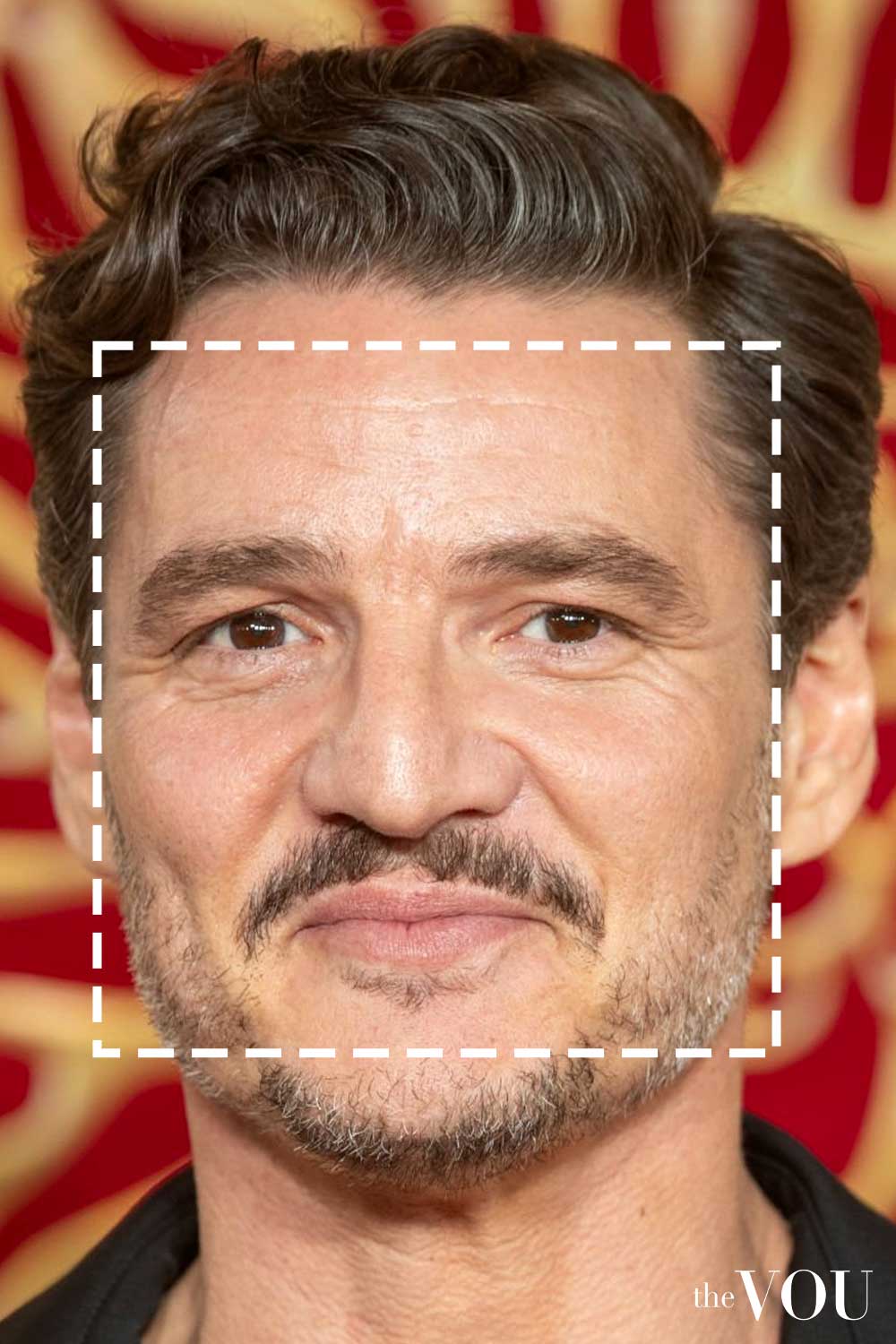
Tom Hardy demonstrates how short sides with a longer, messier top can maintain masculinity while introducing movement and softness to sharp angles.
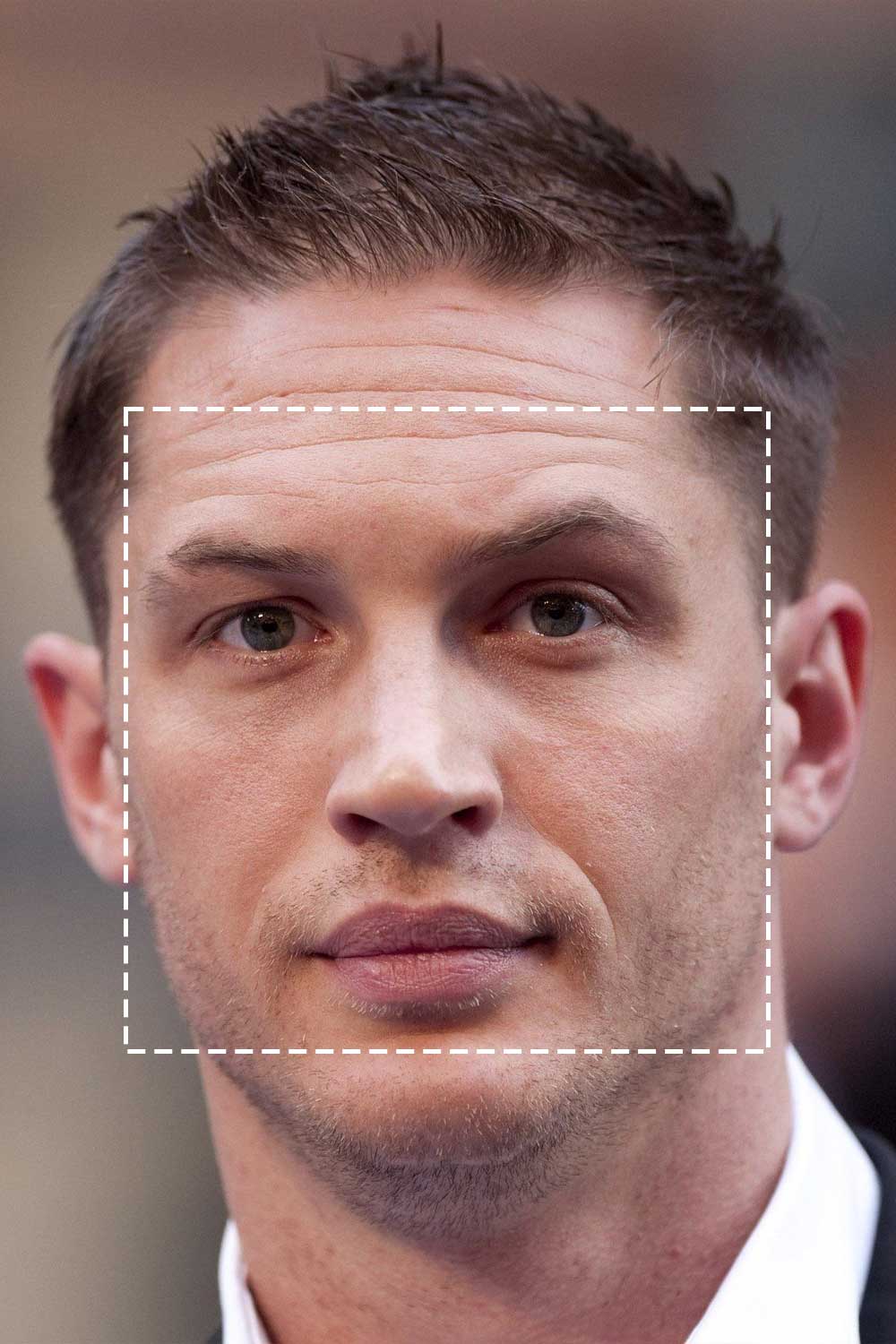
Your stylist should work with your natural structure while creating balanced proportions, highlighting your strong features.
See more haircuts and hairstyles for Square Face Shape
Ideal Beard Styles for Men with Square Face Shape
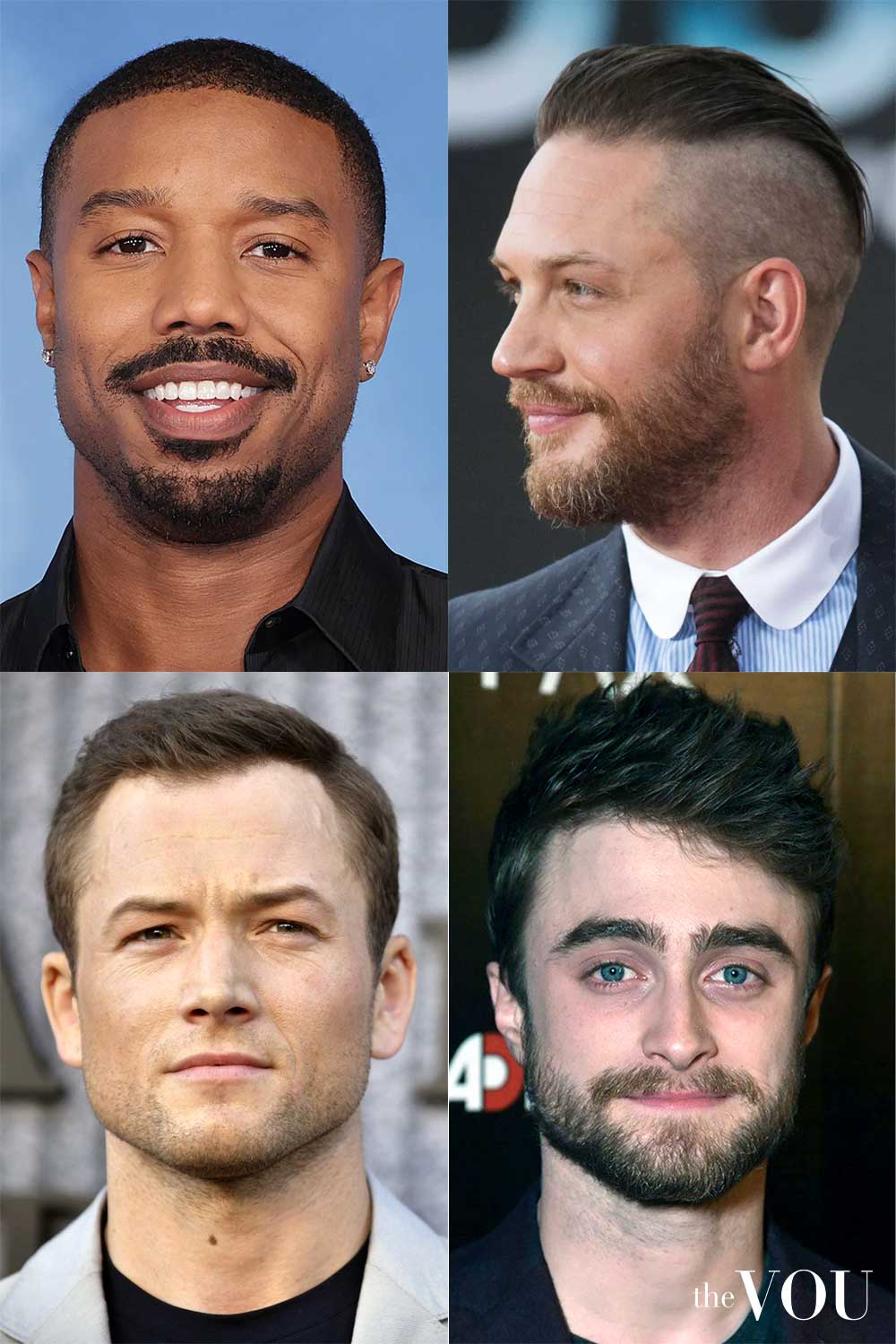
Men with square faces, like Daniel Radcliffe and Tom Hardy, benefit from beard styles that complement their strong, angular features whilst adding sophistication to their look.
The Rounded Full Beard (12-14mm) helps soften sharp angles while maintaining masculinity, as Daniel Radcliffe perfectly shows.
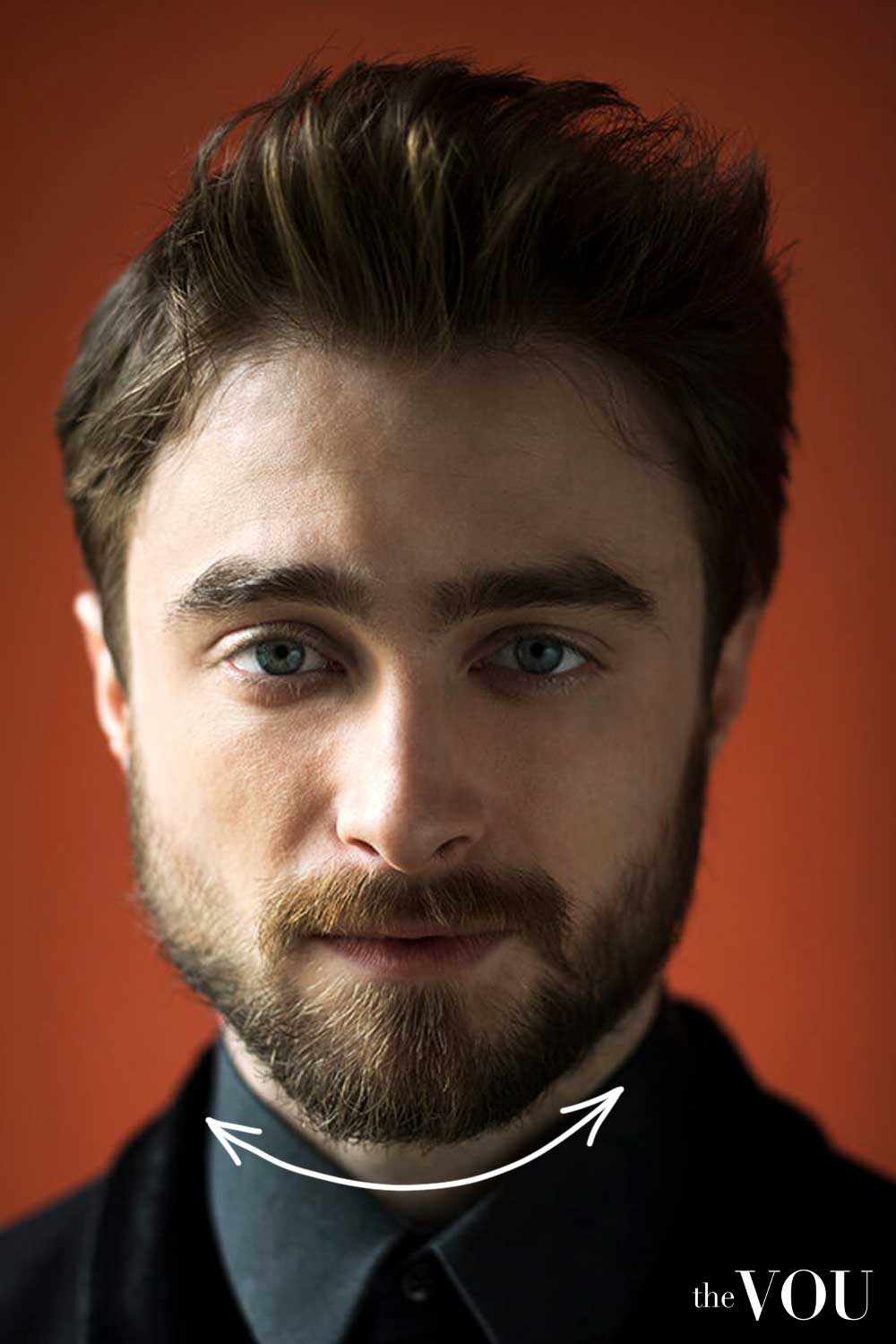
The Faded Beard, exemplified by Tom Hardy, provides a sophisticated graduation that works particularly well with square features.
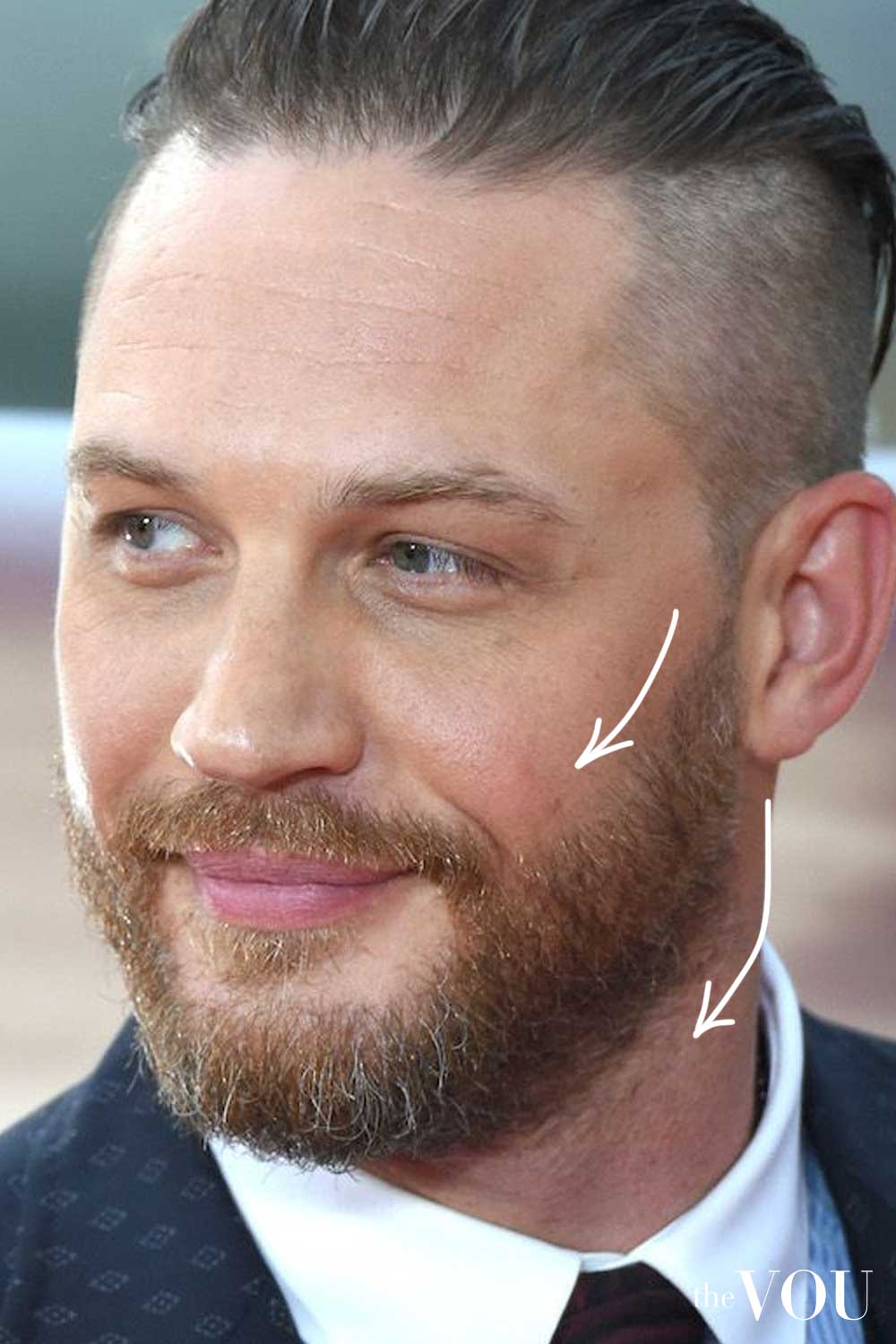
Focus on styles that maintain your natural strength whilst introducing subtle curves to offset angular features.
For optimal results, consider a Moustache with an Extended Goatee (10-12mm), Textured Medium Beard (8-12mm), Subtle Stubble (3-4mm), or Faded Beard (2-12mm graduation).
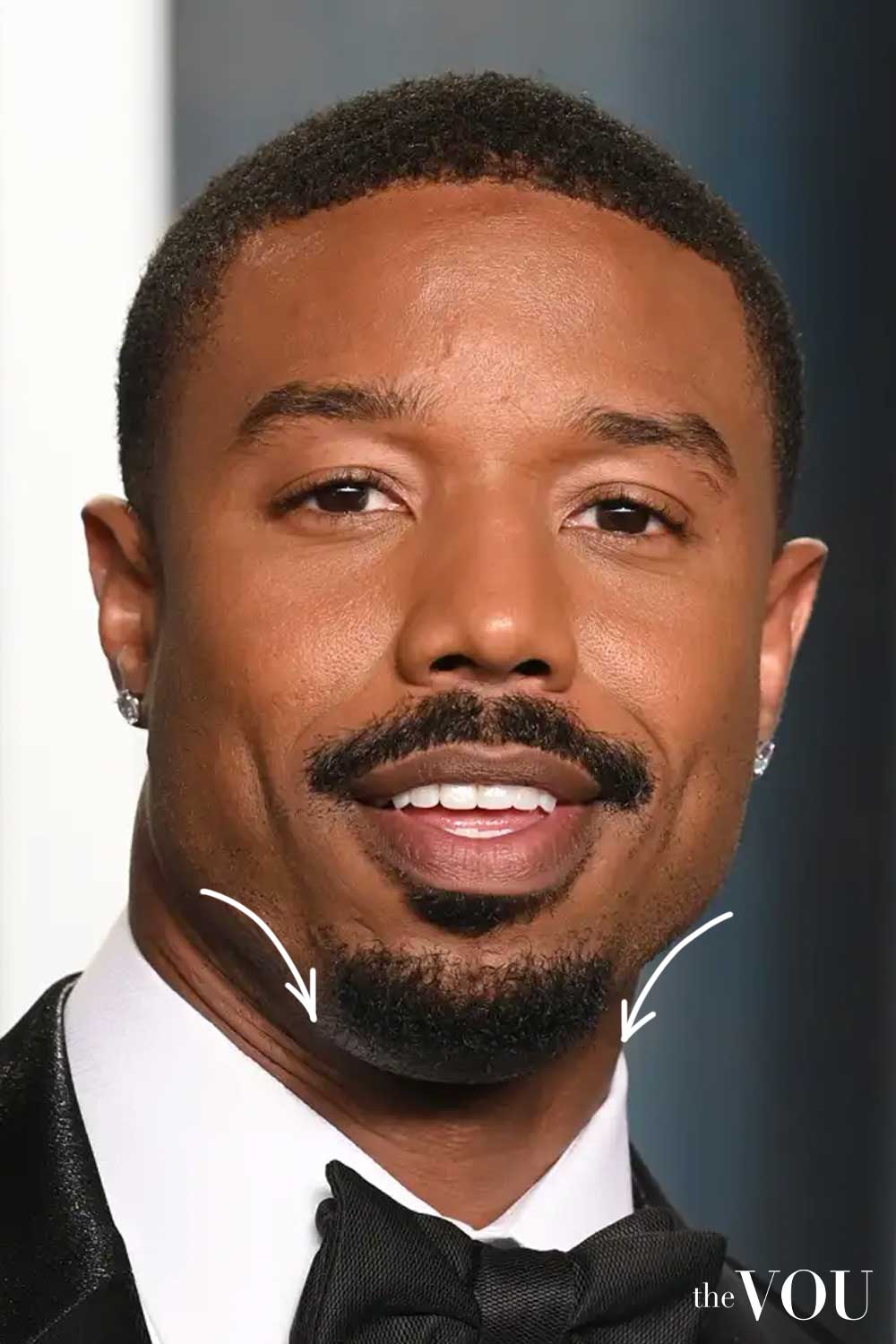
See more beard styles for Square Face Shape
5. Rectangle Face Shape
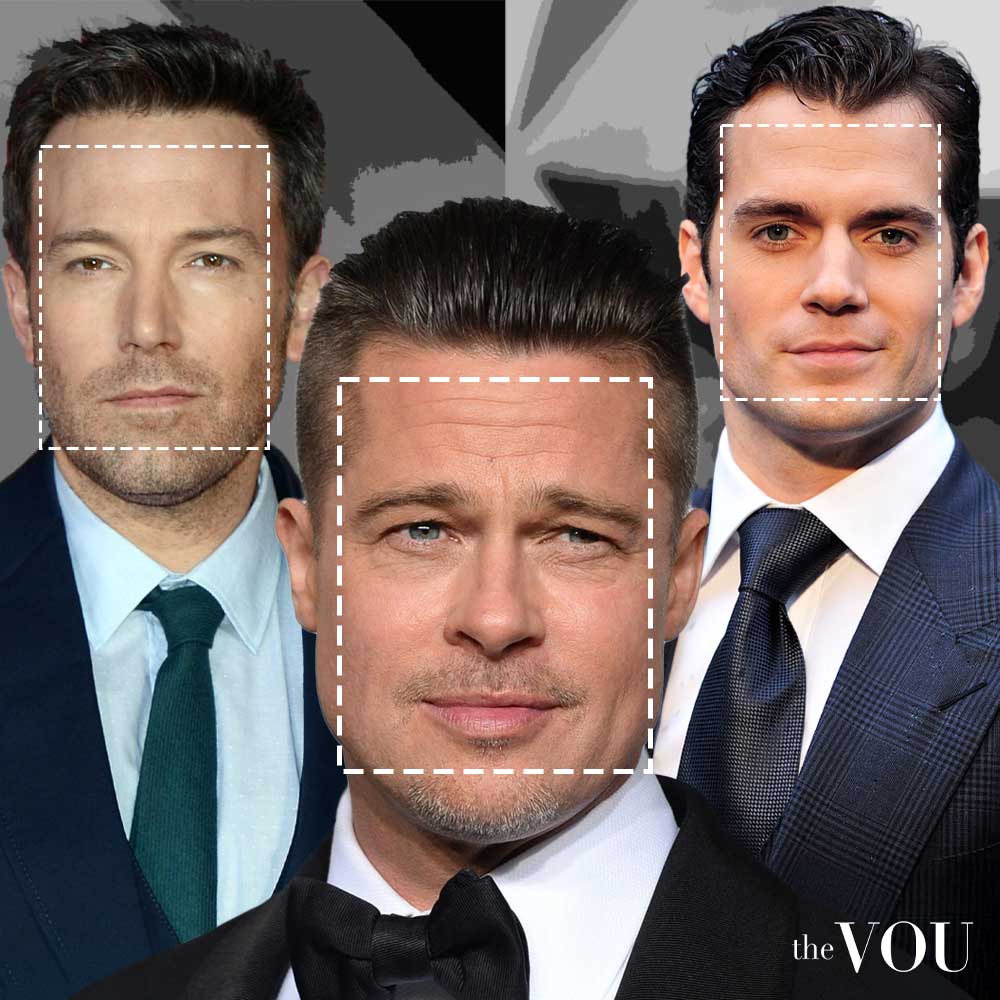
Envision a square face stretched vertically—welcome to the rectangle face shape.
You might hear it called oblong face, extended square, long face, linear face shape, stretched face, elongated face, or narrow face shape.
Rectangle faces maintain the angular features of a square shape but with notably greater length than width.
The forehead, cheekbones, and jawline typically share similar width measurements, creating straight, parallel sides.
Henry Cavill, Brad Pitt, Ben Affleck, Brad Pitt, and Russell Crowe are prime examples of celebrities with rectangular face shape.
Some sources use “oblong” and “rectangular” interchangeably, though oblong faces might feature slightly softer corners.
This shape benefits from styles that add width rather than height, helping to create more balanced proportions.
Ideal Haircuts for Men with Rectangle Face Shape
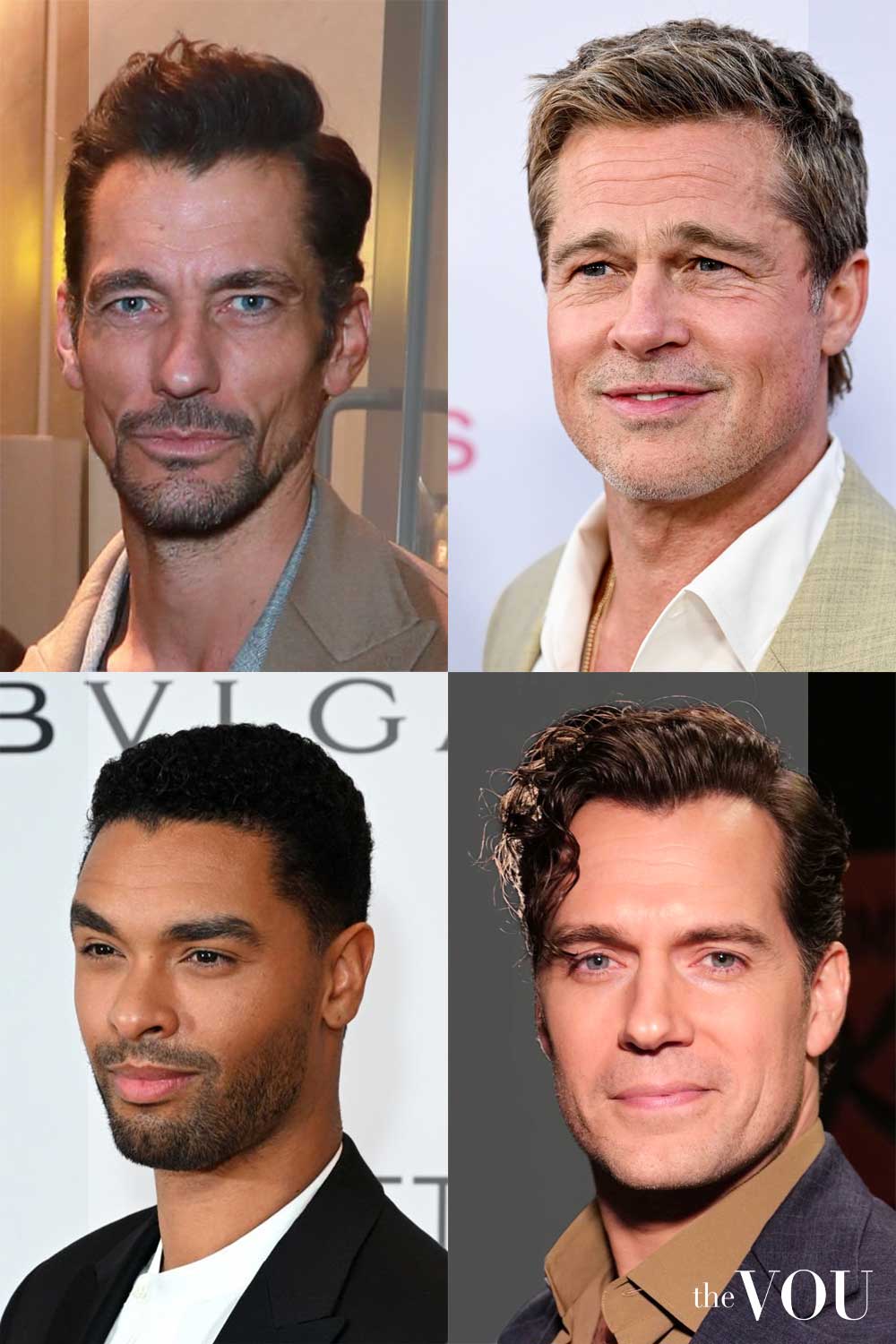
Henry Cavill exemplifies how rectangular face shapes can balance their length through strategic styling.
Focus on cuts that add width rather than height, with mid-length styles that can be swept to the side rather than straight up.
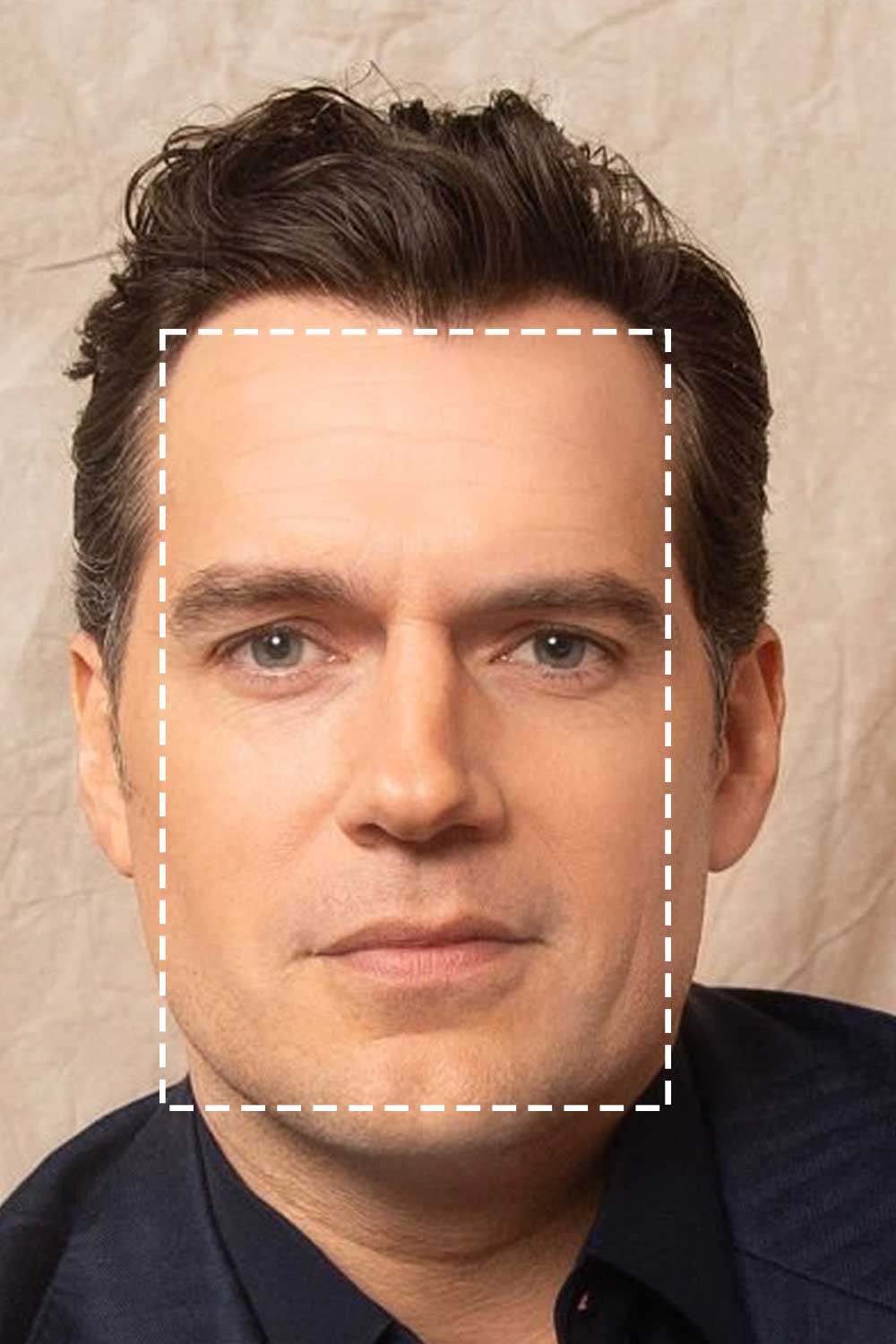
Brad Pitt’s signature look is the perfect example of how layered cuts can break up length while maintaining sophistication.
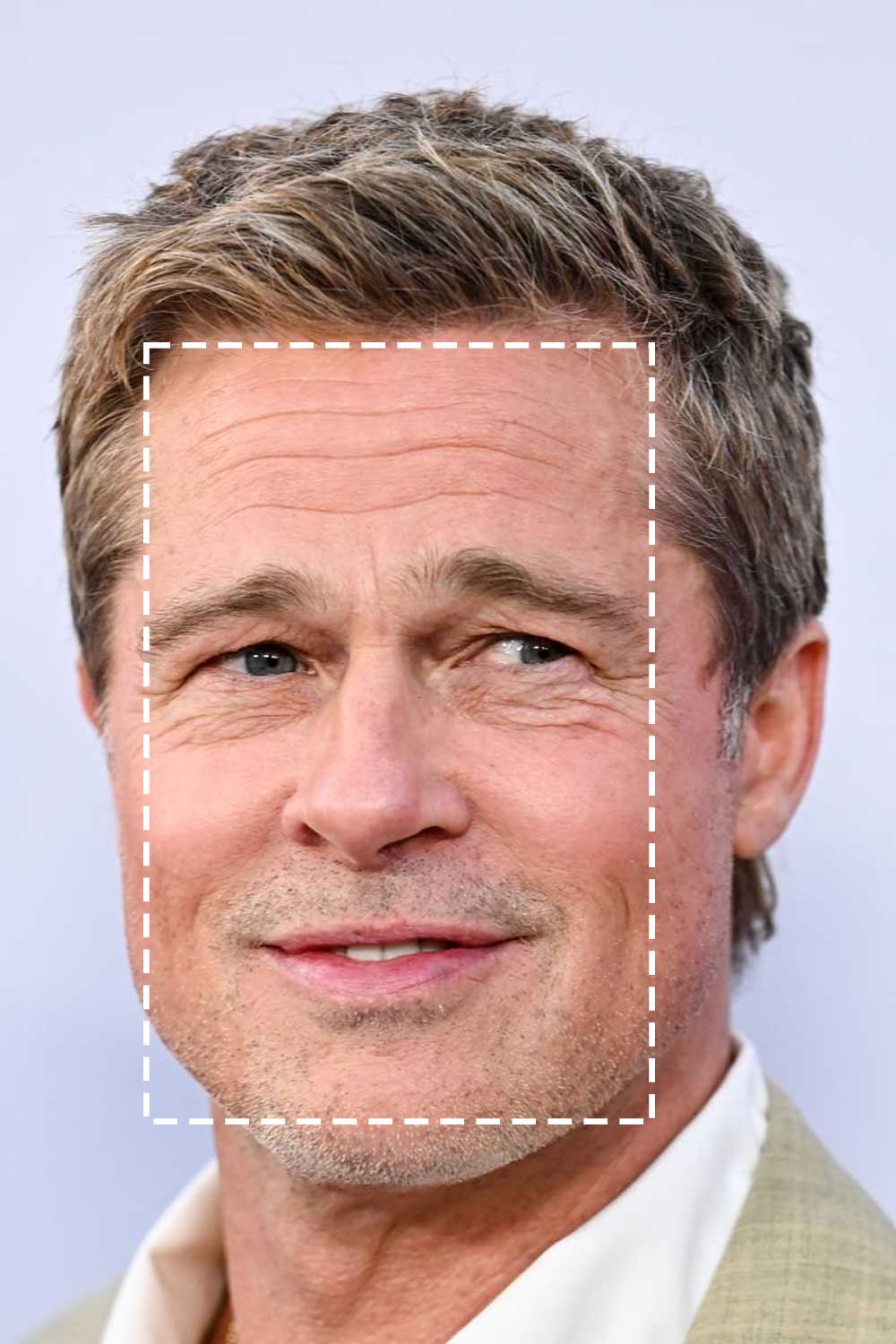
Your stylist should avoid styles that elongate your face further and instead focus on creating balanced proportions that complement your natural features.
See more haircuts and hairstyles for Rectangle Face Shape
Ideal Beard Styles for Men with Rectangle Face Shape
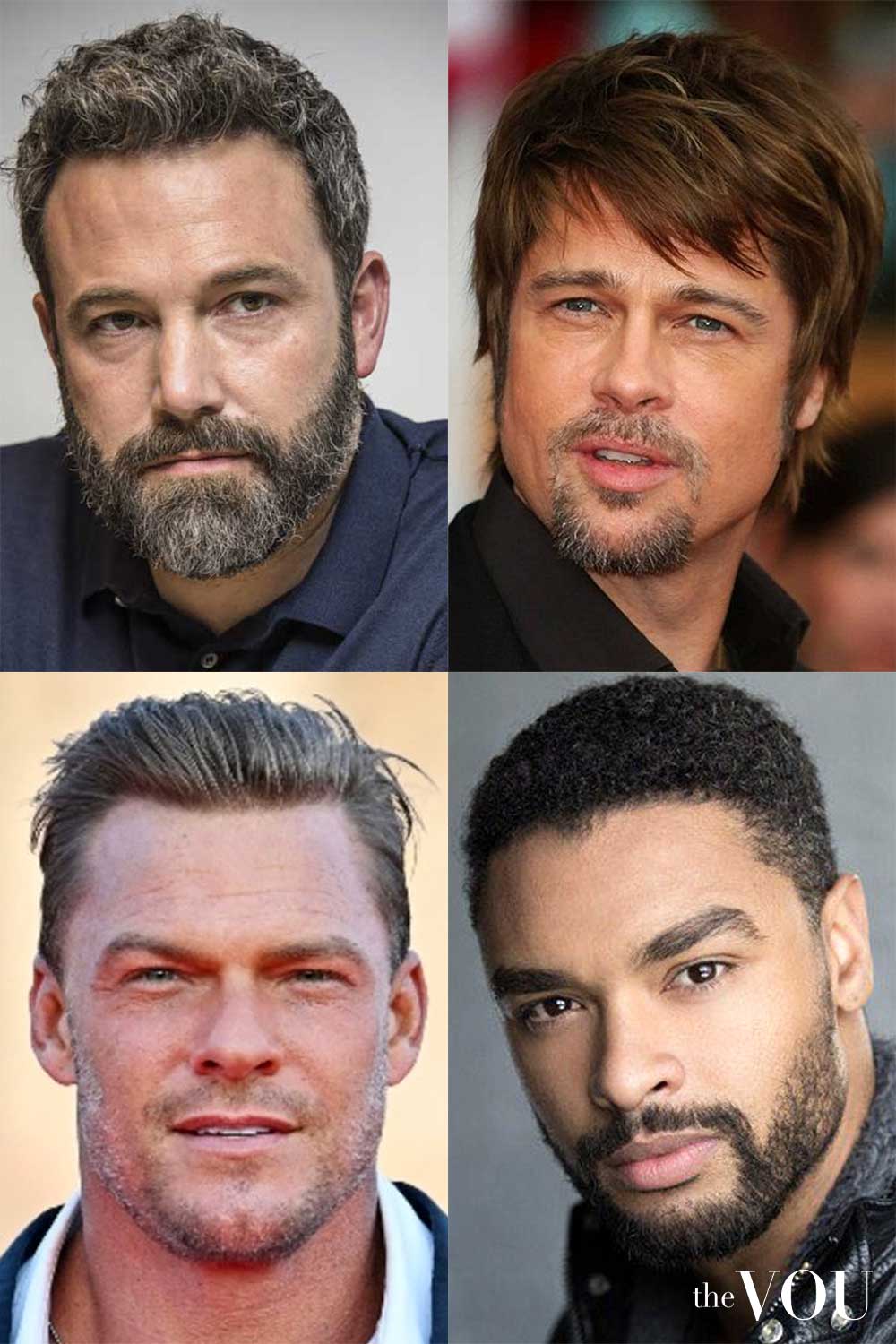
Men with rectangular faces, like Ben Affleck and Henry Cavill, need styles that add width whilst controlling length to create balanced proportions.
The Rounded Full Beard (12-15mm) offers excellent balance, as demonstrated by Ben Affleck’s approach.
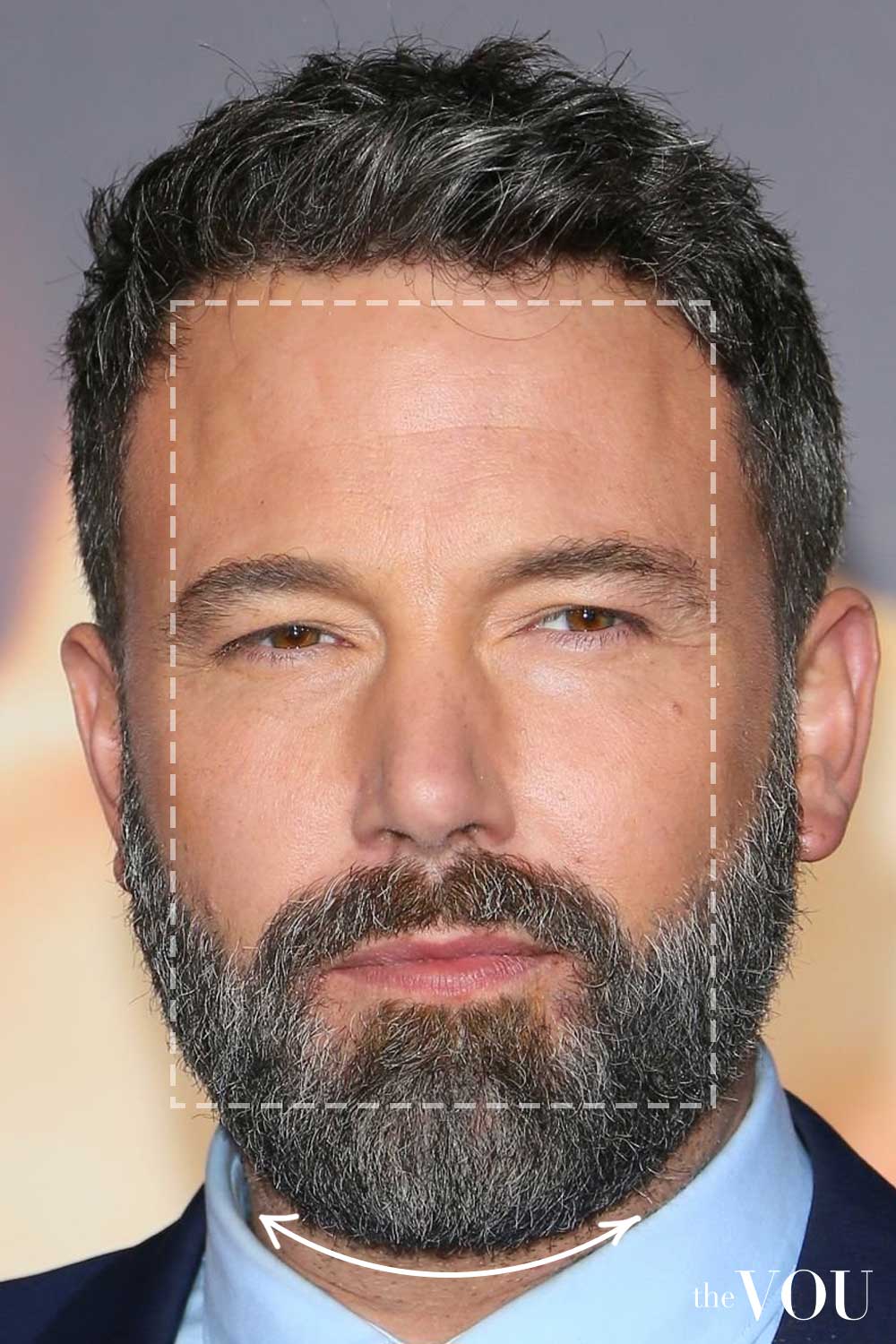
The Full Beard with Angled Bottom, worn masterfully by Henry Cavill, creates beneficial width without emphasising facial length.
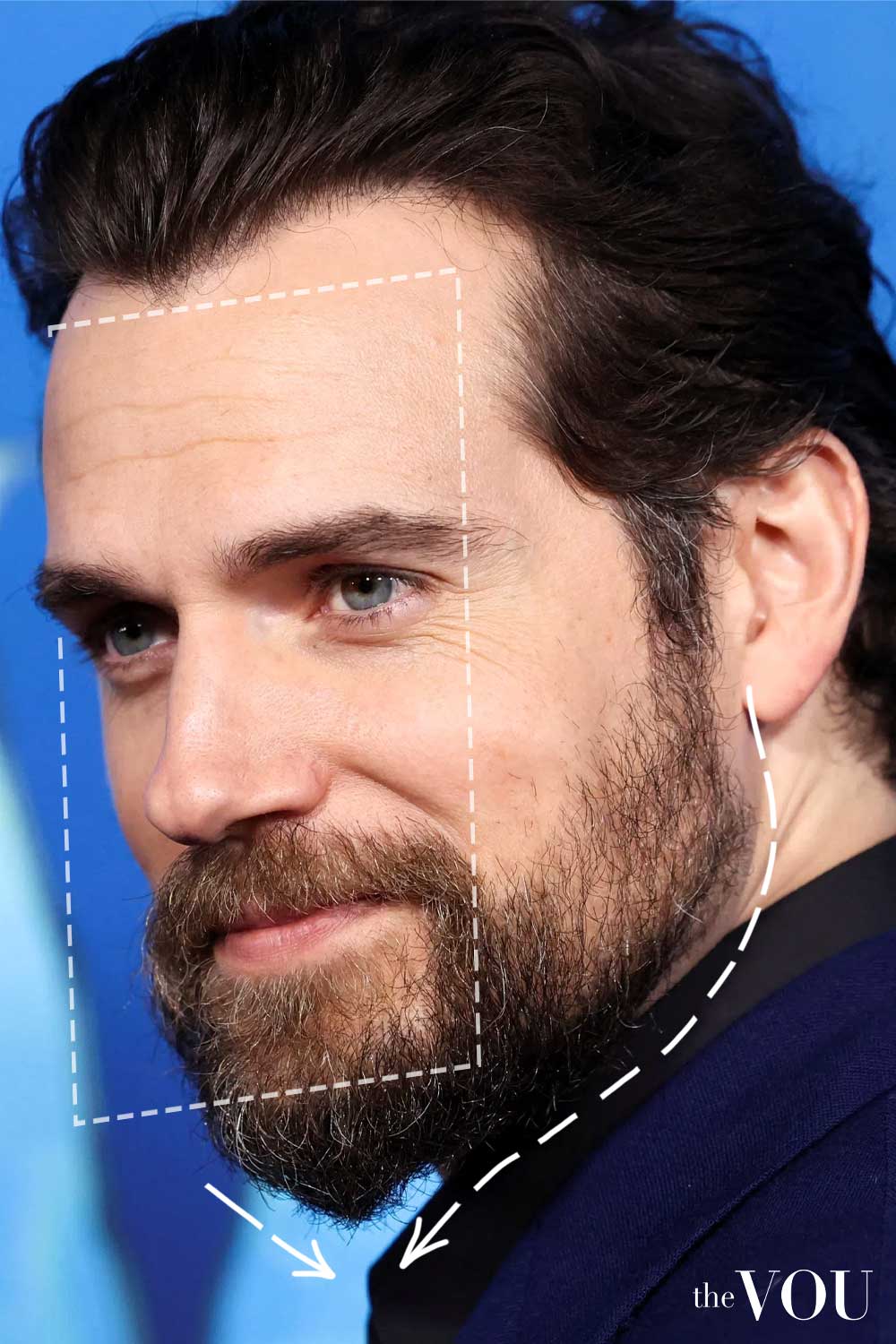
Focus on styles that broaden facial appearance whilst tempering angular features.
Consider a Circle Beard (4-6mm), Short Boxed Beard with Fade (2-8mm), or Designer Stubble (1-3mm) for sophisticated results that complement your face shape perfectly.
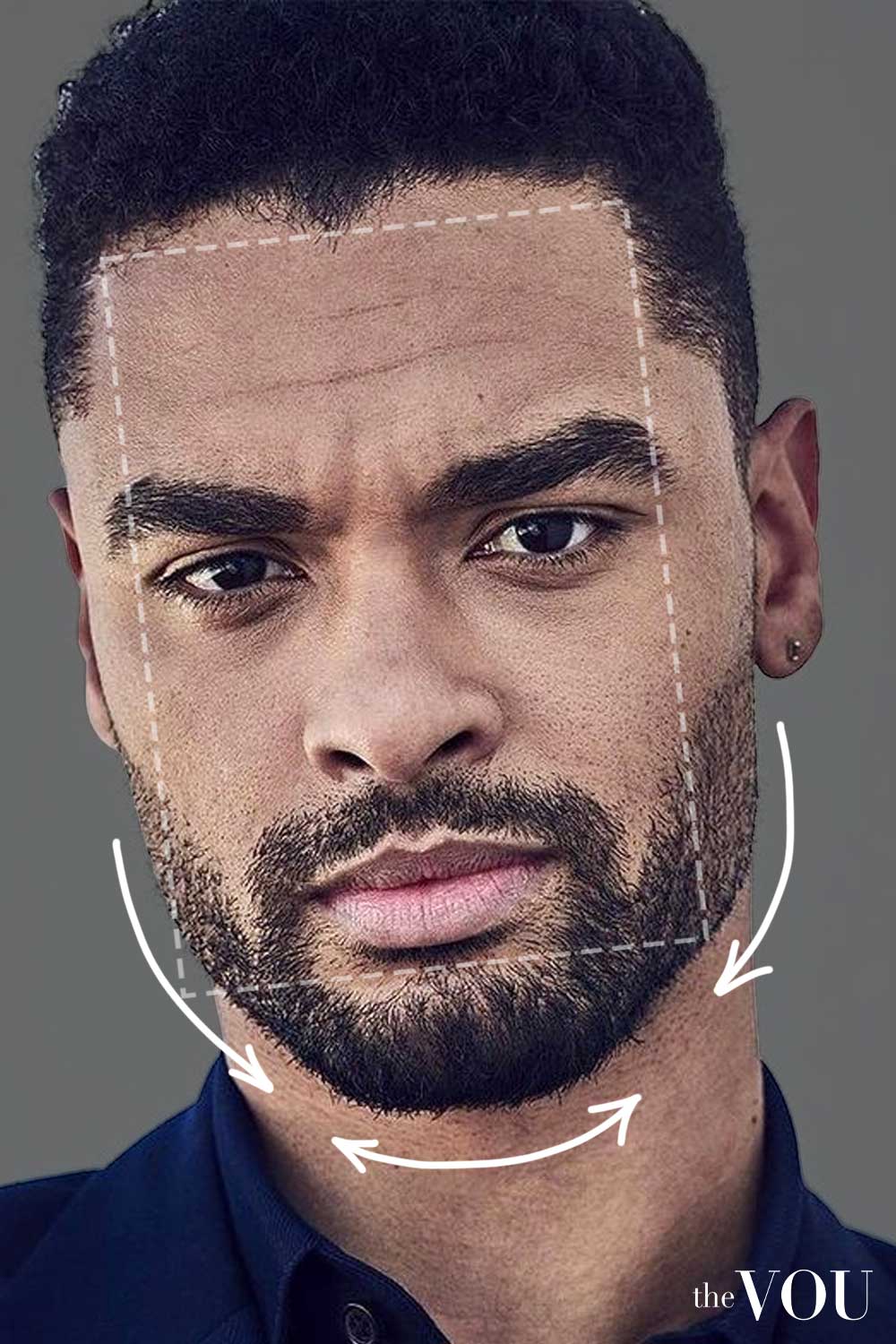
See more beard styles for Rectangle Face Shape
6. Triangle Face Shape
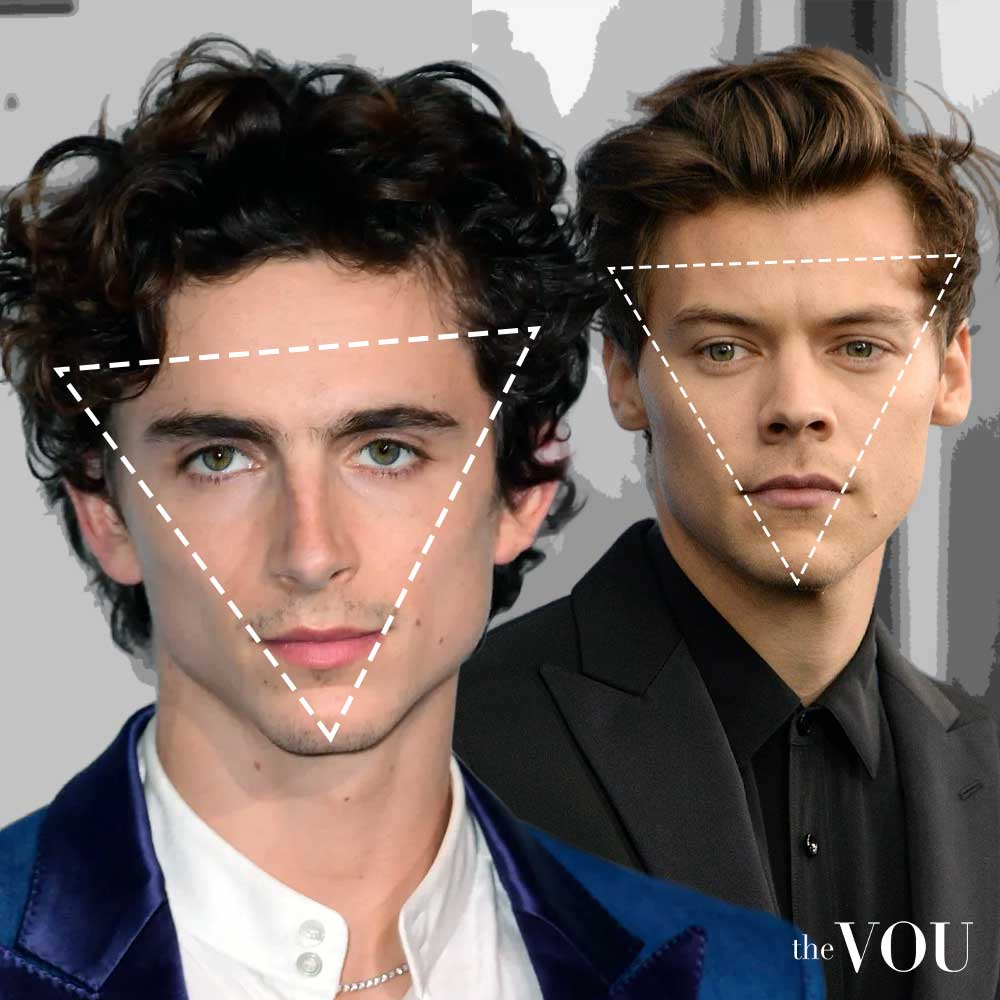
Visualise an upside-down triangle – that’s the essence of the Triangle face shape.
Alternative names include pear face shape, pyramidal face shape, wide jaw face shape, narrow forehead face shape, inverted pyramid face shape, or base-heavy face shape.
The defining feature is a jaw wider than the forehead, with the face gradually narrowing from bottom to top.
Unlike the diamond or heart shape, the widest point sits at the jawline rather than the cheekbones or forehead.
Timothée Chalamet and Harry Styles are good example of public figures who display triangular face characteristics.
While some guides might combine this with other categories, its distinct features and styling needs warrant separate classification.
Triangle faces can appear particularly masculine due to their strong jaw structure, though many men prefer to balance this feature through styling choices.
Ideal Haircuts for Men with Triangle Face Shape
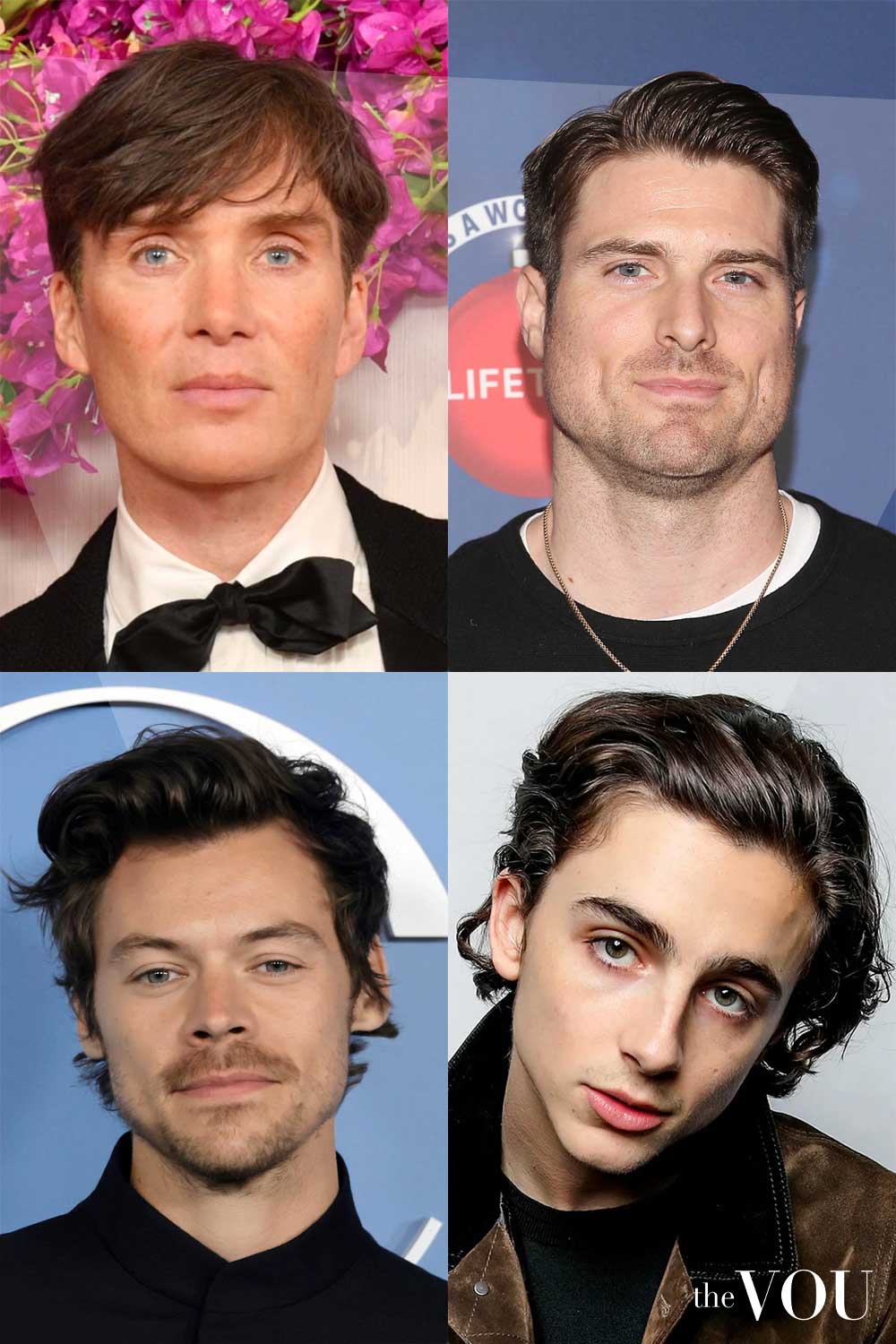
For triangle faces like Timothée Chalamet’s, the focus should be on balancing your stronger jaw with your narrower forehead.
Styles that add volume on top and at the temples create harmonious proportions.

Your stylist should avoid very short sides that might emphasise your jaw’s width, instead opting for cuts that create balance through strategic length distribution.
Consider textured styles with volume on top to create a more balanced appearance.
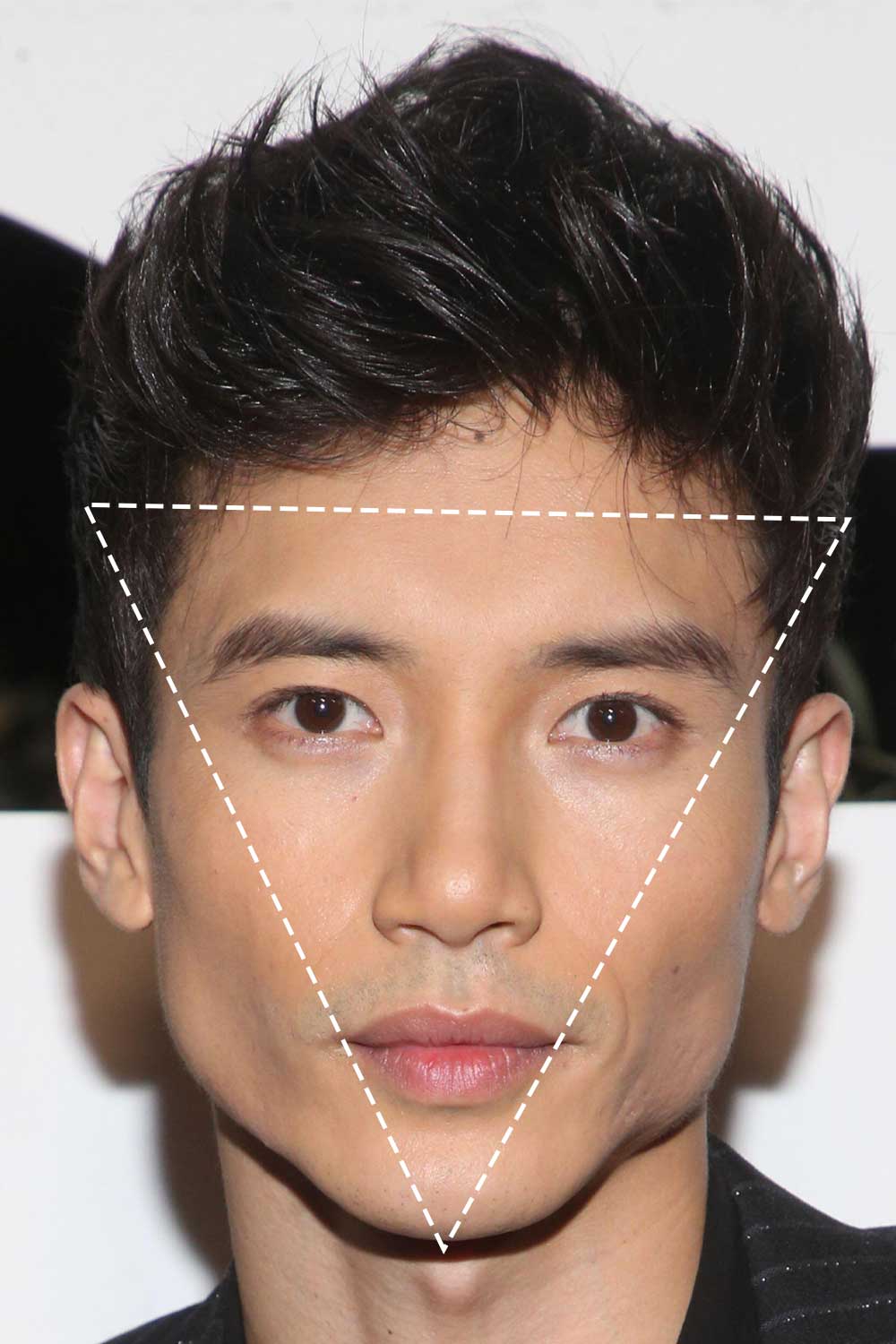
See more haircuts and hairstyles for Triangle Face Shape
Beard Style Recommendations for Triangle Face Shape

For men with triangle faces, like Tom Cruise and Tom Holland, the goal is to avoid adding bulk at the wider jaw area whilst creating balance in the upper face.
The Minimal Stubble with Defined Lines (2-4mm) creates excellent definition without adding width, as shown by Tom Cruise’s precise approach.
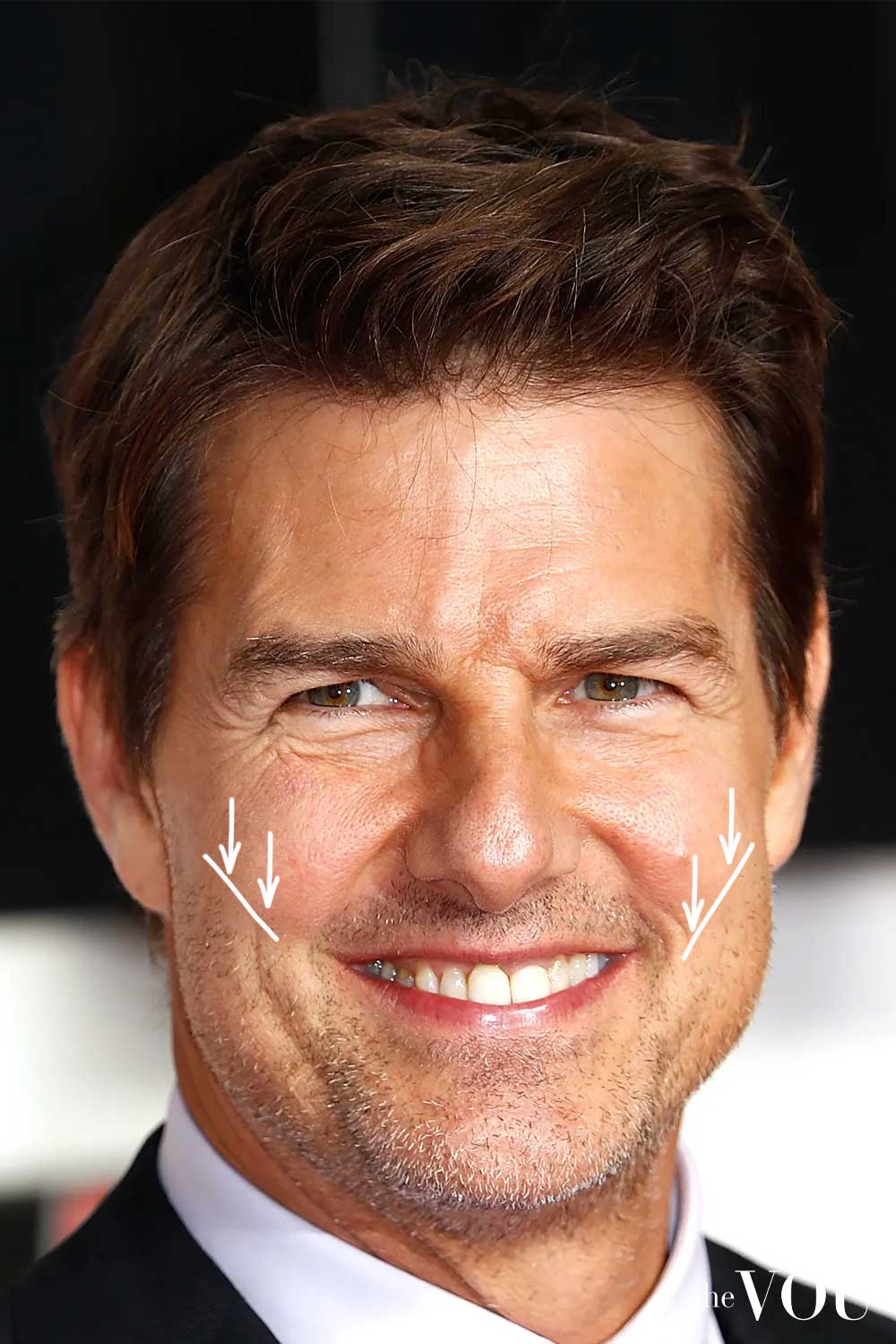
The Graduated Short Beard, demonstrated by Taylor Zakhar Perez, helps create visual balance through strategic length variation.

Your focus should be on creating definition without adding unnecessary width to the jaw.
Consider a Chin-Focused Goatee (8-10mm), Temple-Focused Growth (6-8mm), or Defined Stubble with Height (4-5mm) for sophisticated results.

See more beard styles for Triangle Face Shape
7. Heart Face Shape
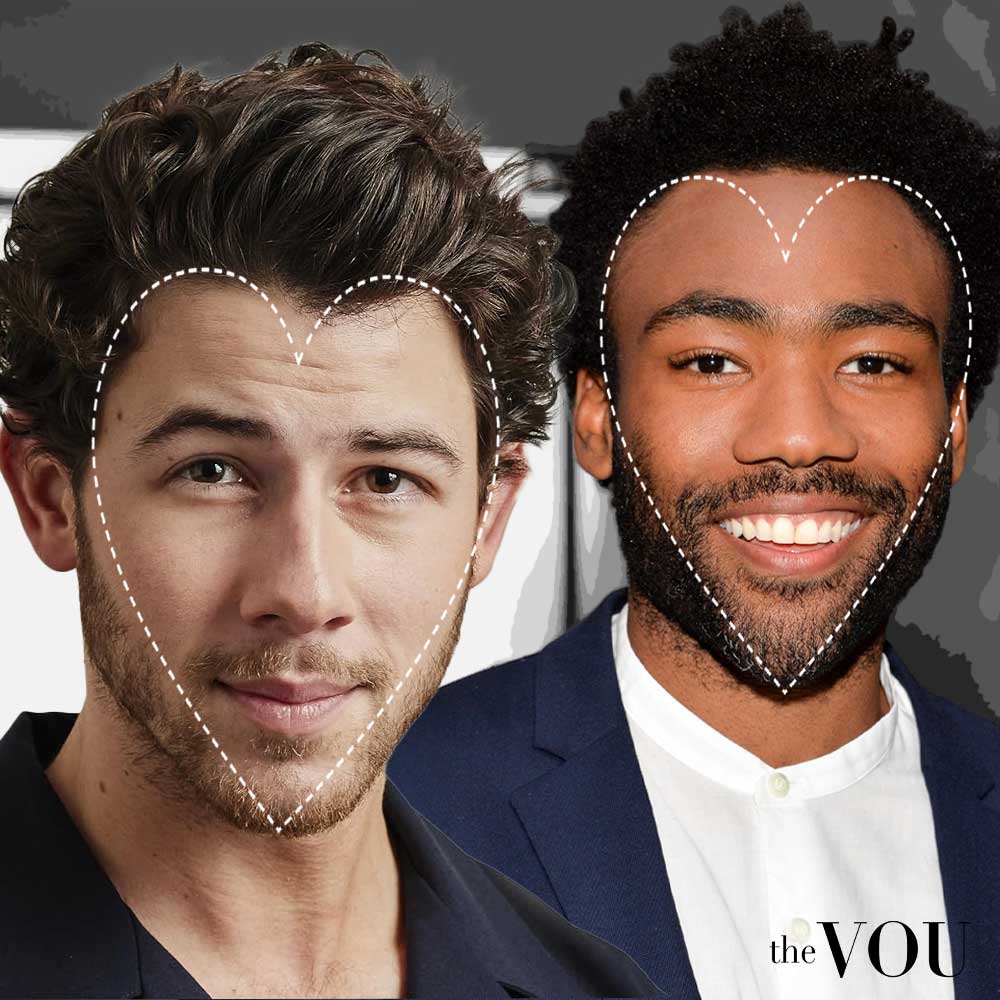
Visualise an inverted triangle – that’s the essence of the heart-shaped face.
Also known as Valentine face shape, inverted triangle shape, wide forehead shape, or tapering jaw shape.
The defining feature is a forehead wider than the cheekbones, with the face gradually narrowing down to a more pointed chin.
Unlike the diamond shape, where cheekbones dominate, heart shapes show their greatest width at the forehead line.
Bradley Cooper, Nick Jonas, Donald Glover, and Chris Hemsworth are a few example of celebrities heart-shaped face characteristics.
A widow’s peak hairline is common with heart shapes, though it’s not a required feature.
Due to their soft tapering features, men with heart-shaped faces project a youthful appearance.
Ideal Haircuts for Men with Heart Face Shape
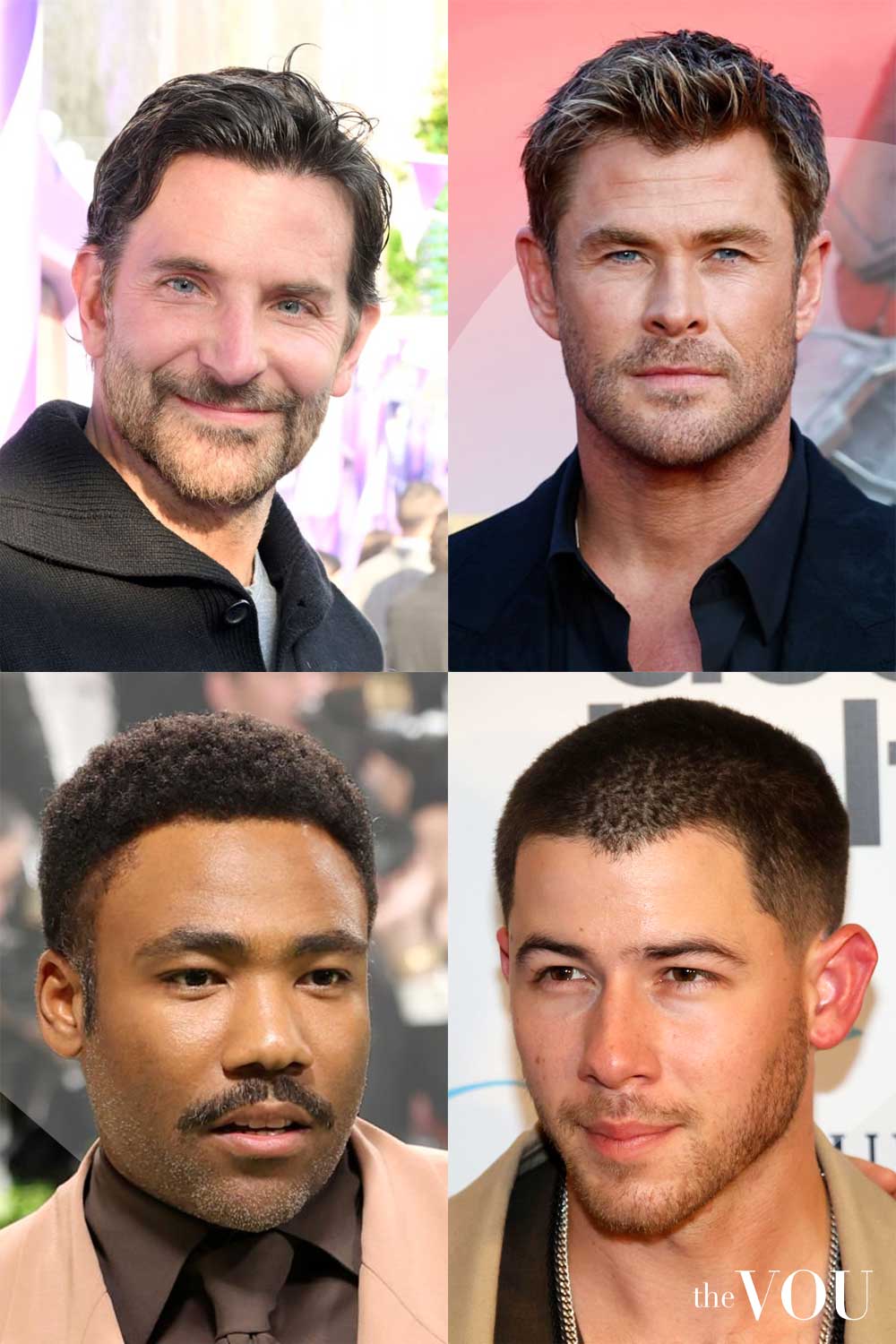
Bradley Cooper shows how heart-shaped faces can achieve perfect balance through strategic styling.
Your haircut should work to reduce width at the forehead while adding volume at the chin level.

Henry Golding’s precisely cut styles demonstrate how to maintain sophistication while creating optimal proportions.
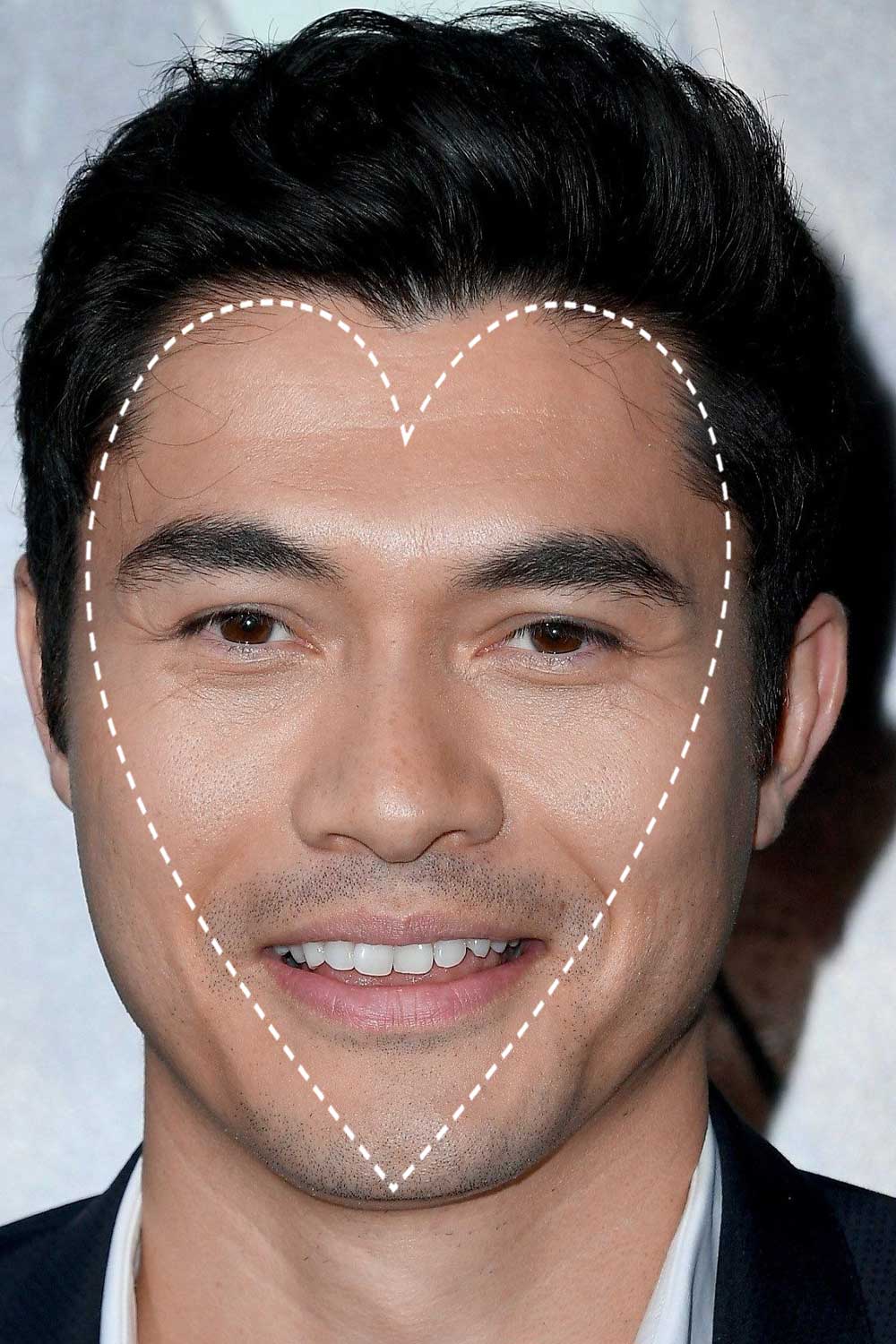
Your stylist should focus on cuts that soften your wider forehead while adding structure to the lower face.
Consider styles with longer sides and textured tops to balance your natural features.
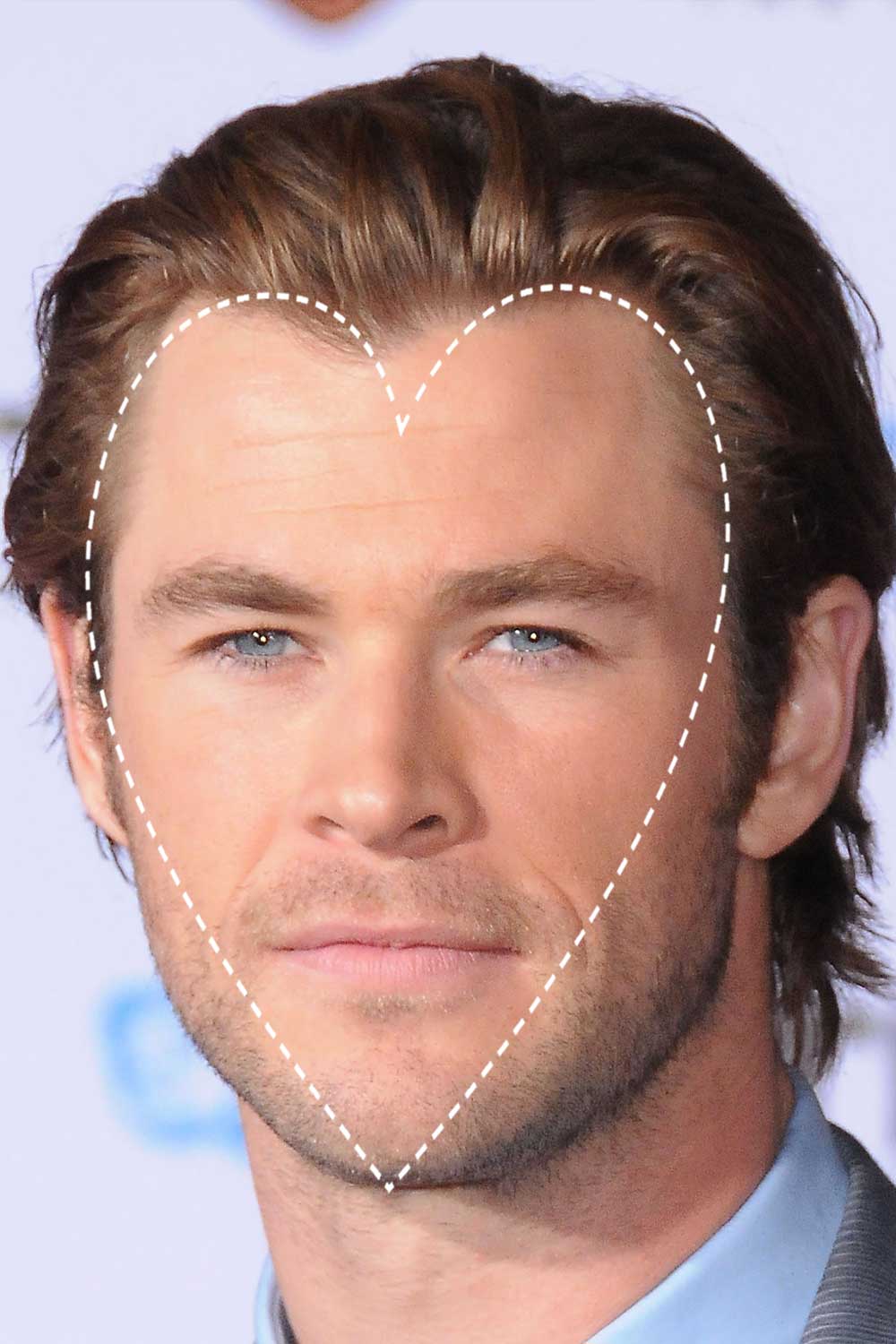
See more haircuts and hairstyles for Heart Face Shape
Ideal Beard Styles for Men with Heart Face Shape
Men with heart-shaped faces, like Chris Pine and Chris Hemsworth, benefit from styles that add volume to the lower face whilst maintaining balance with the wider forehead.
The Full Chin Beard (12-14mm) demonstrates excellent proportion creation, as shown by Chris Pine’s styling.
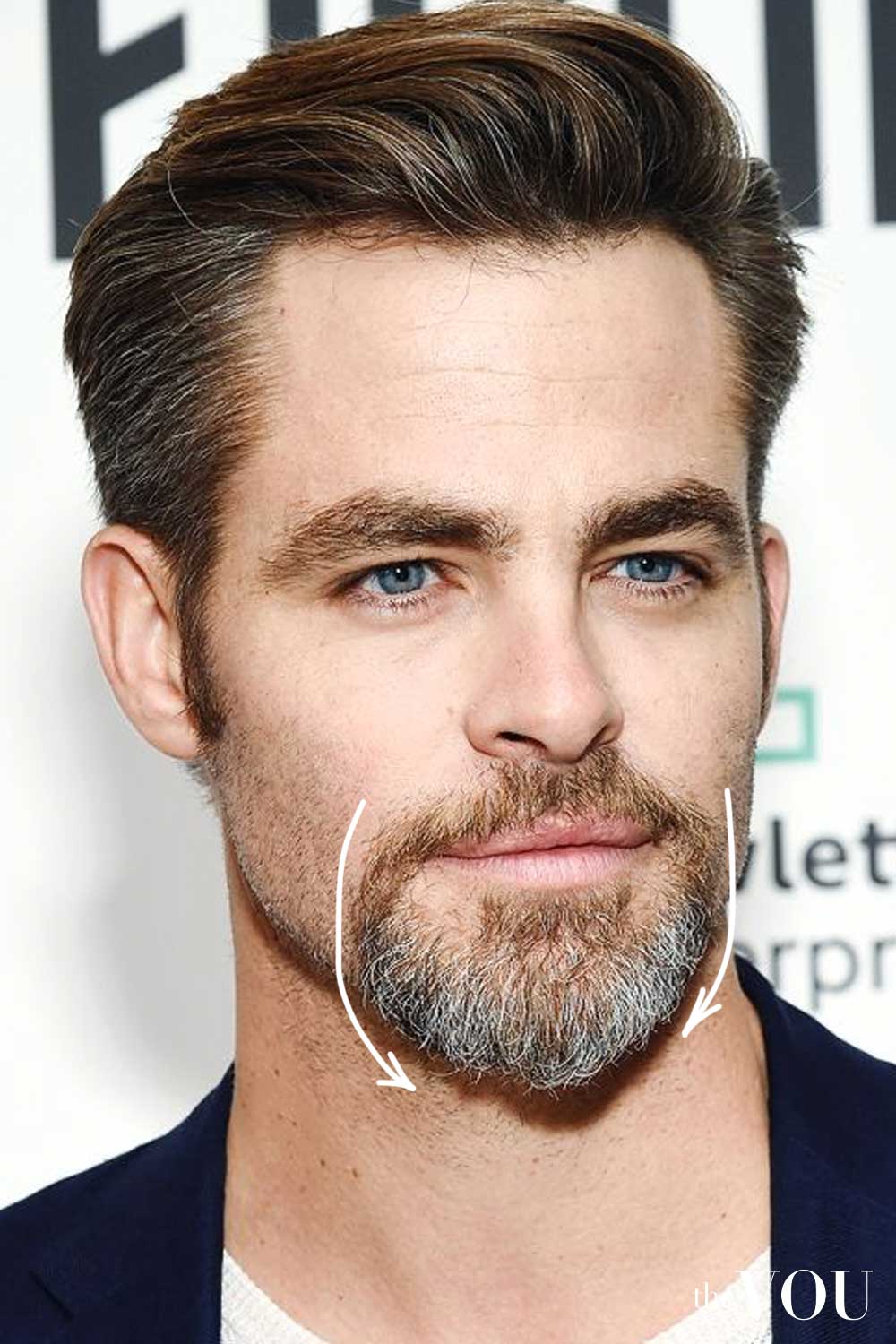
The Balbo Beard, worn expertly by Ethan Hawke, adds crucial width to the narrower chin area.
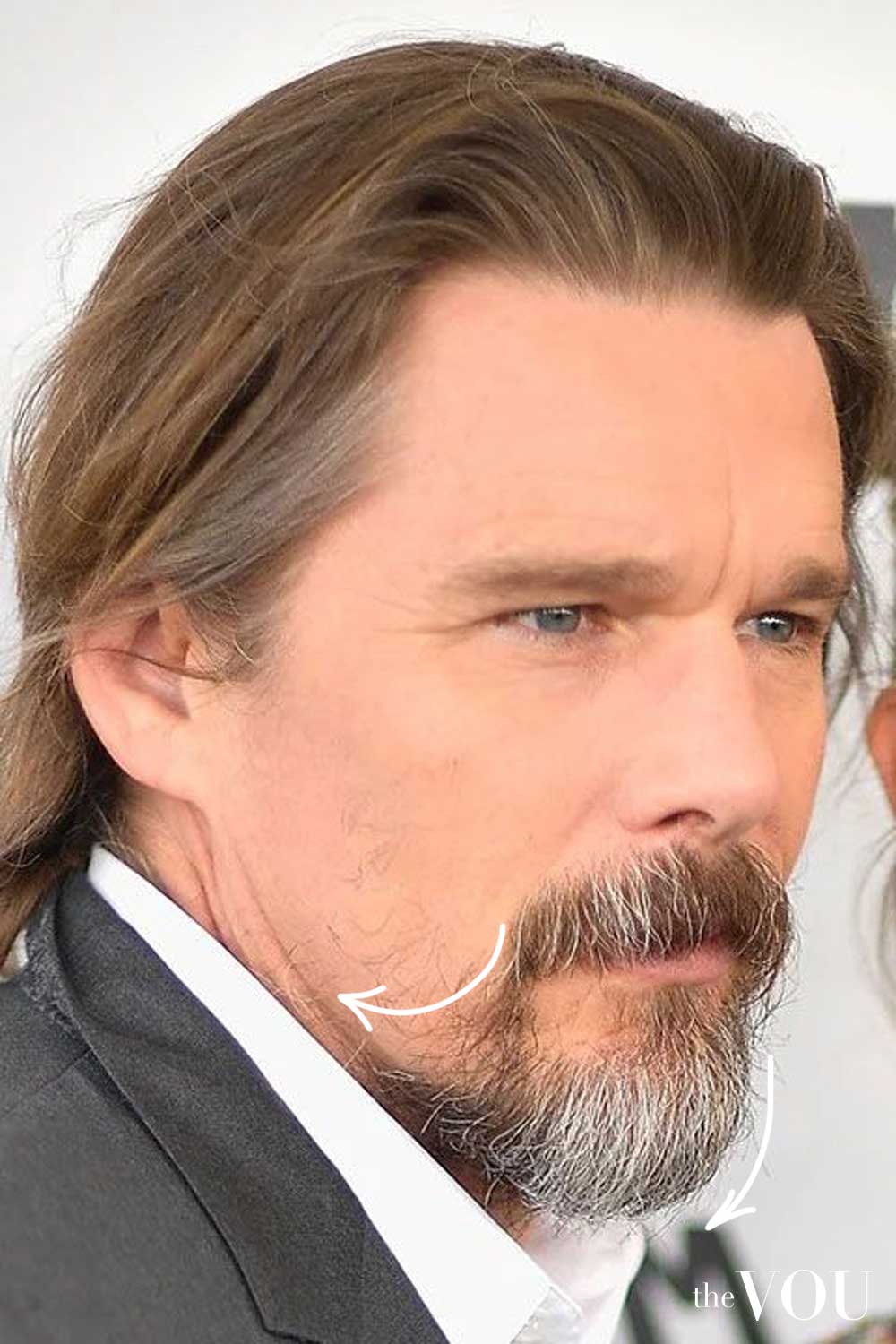
Your focus should be on adding strategic volume to the lower face whilst maintaining sophisticated proportions.
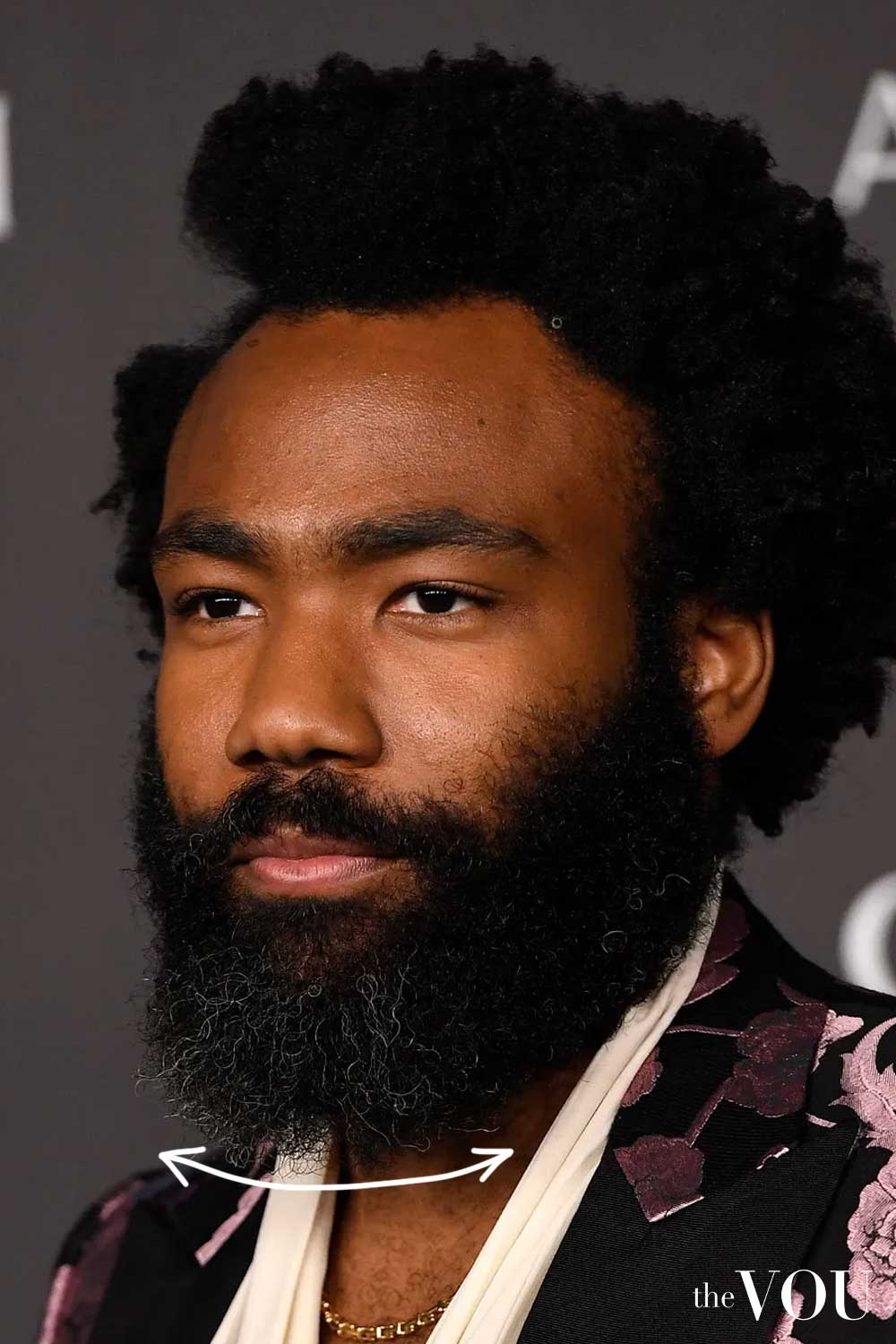
Consider a Full Beard with Tapered Sides (6-14mm), Defined Stubble with Fuller Chin (4-7mm), or Shaped Full Beard (12-14mm) for optimal results.
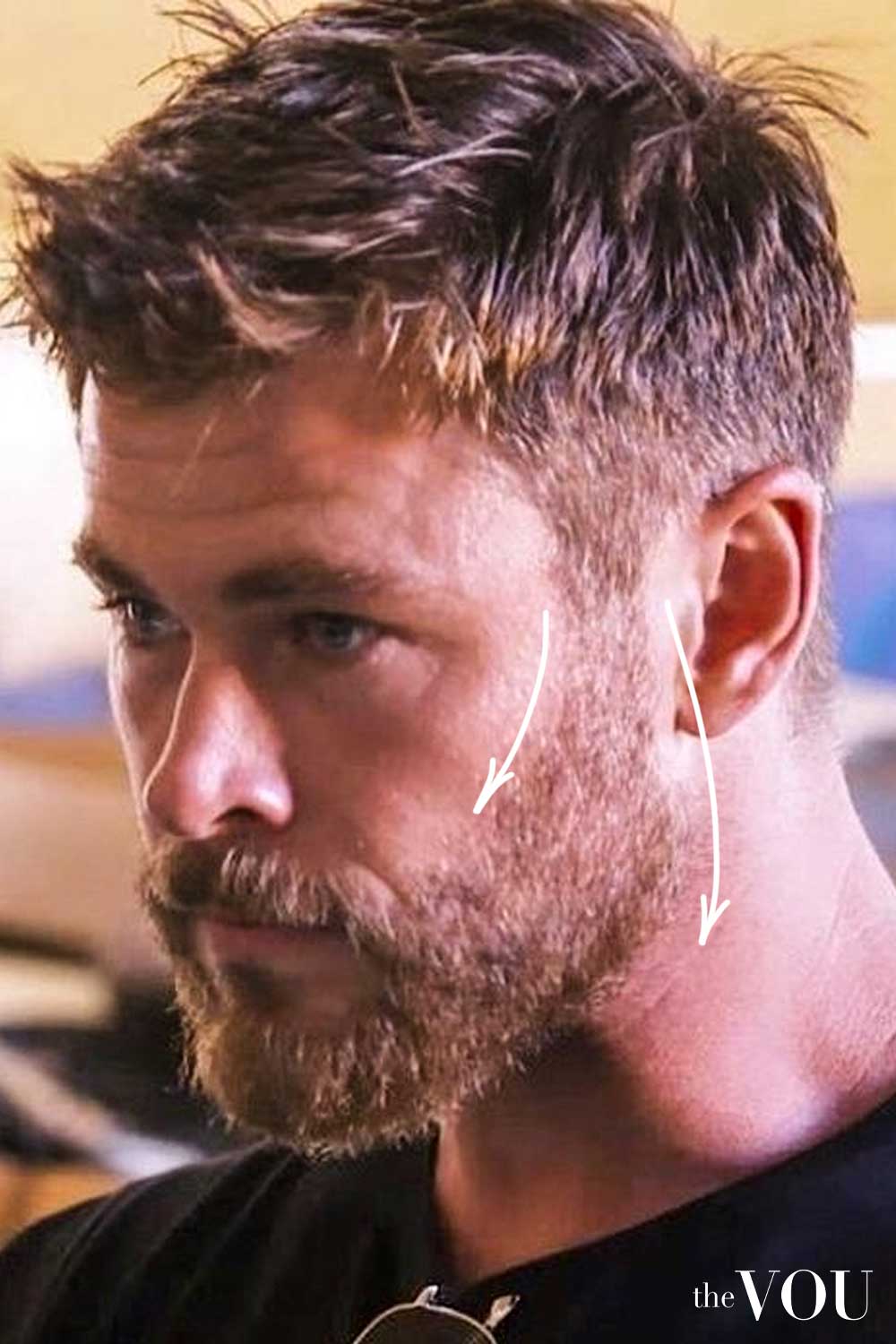
See more beard styles for Heart Face Shape
8. Pear Face Shape

Think of an inverted heart – that’s the essence of the pear face shape.
Also known as trapezoid face shape, reverse triangle, wide-base face shape, or gradual-width face shape.
The defining feature is a narrow upper forehead that gradually widens through the cheeks to a broader jawline, creating a smooth transition from top to bottom.
Unlike the triangle shape, where the widening can be more dramatic, pear faces show a more gradual progression from the narrower forehead to the wider jaw.
Jason Derulo, Matt Bomer, and Édgar Ramírez are a few example of celebrities with pear-shaped faces.
This shape differs from other angular faces in its smooth transitions rather than dramatic angles, offering unique opportunities for balanced styling approaches.
Many men with pear faces find success in styles that add volume at the crown while keeping the sides proportional to balance their natural features.
Ideal Haircuts for Men with Pear Face Shape

Men with pear-shaped faces like Édgar Ramírez and Jason Derulo excel with styles that add volume at the crown and temples whilst maintaining balanced sides.
The goal is to add subtle width to the upper face to complement the broader jawline, as demonstrated perfectly through Édgar Ramírez’s expertly styled looks.

Your stylist should focus on cuts that create strategic volume at the crown while keeping the sides proportional to avoid emphasising jaw width.

Consider textured styles that add width where needed most, following Matt Bomer’s refined approach to balancing facial proportions.

See more haircuts and hairstyles for Pear Face Shape
Ideal Beard Styles for Men with Pear Face Shape
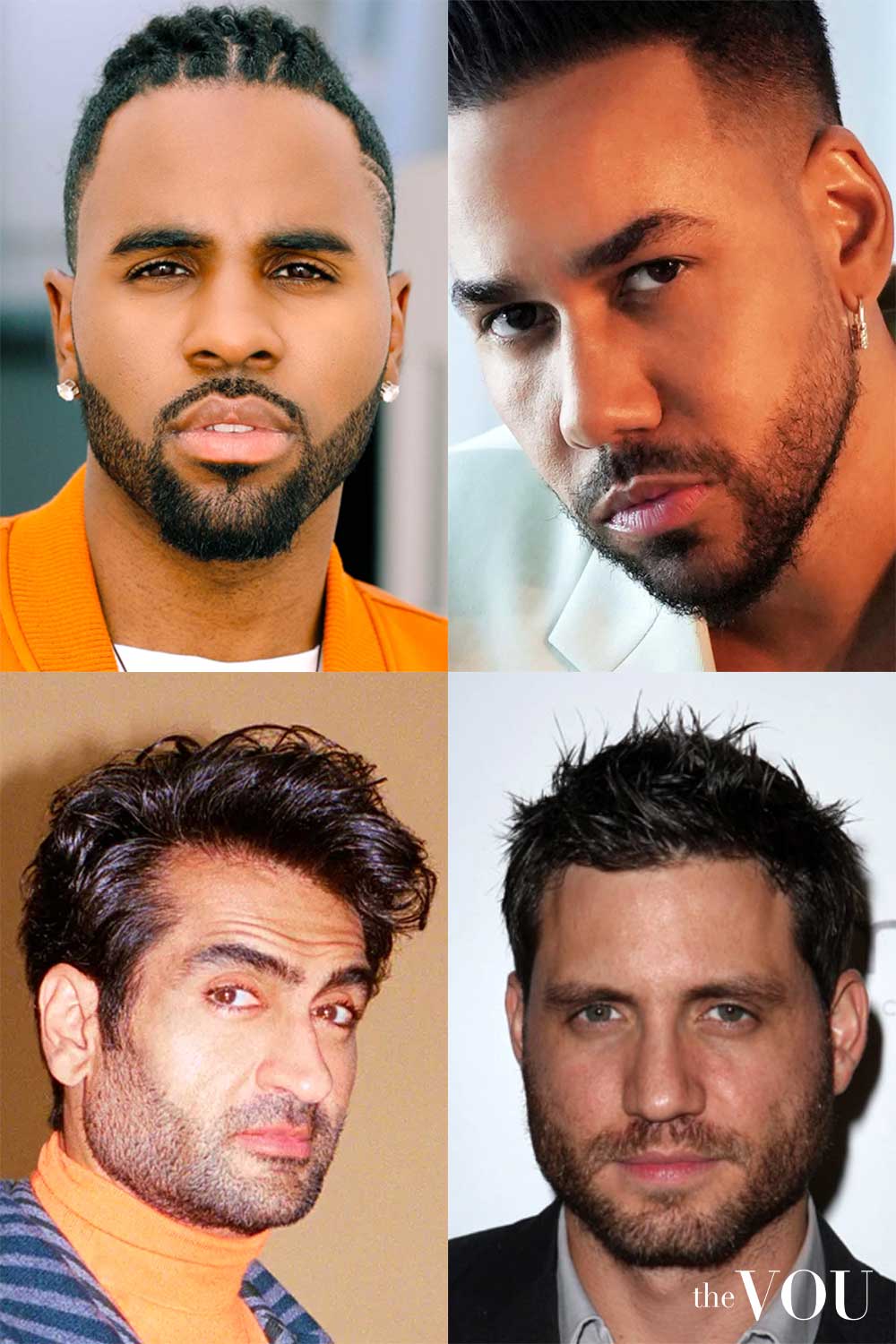
Men with pear-shaped faces, like Édgar Ramírez and Jason Derulo, require styles that create balanced proportions without emphasising the naturally wider jaw area.
The Short Boxed Beard (5-6mm) offers refined definition, as demonstrated by Édgar Ramírez’s precise maintenance.
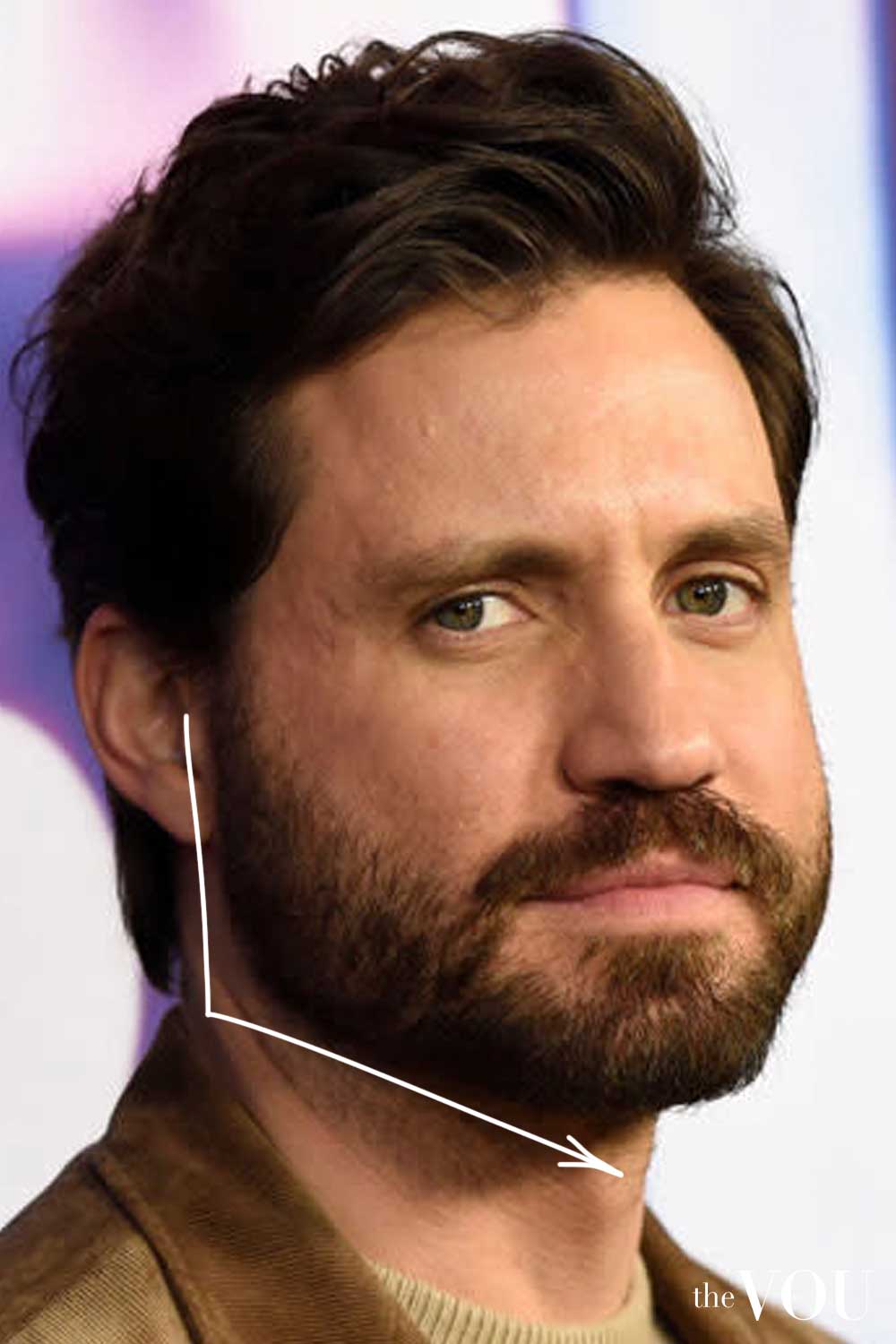
The Three-Day Stubble, worn expertly by Matt Bomer, creates subtle texture without adding bulk. Focus on styles that add definition without increasing jaw width.
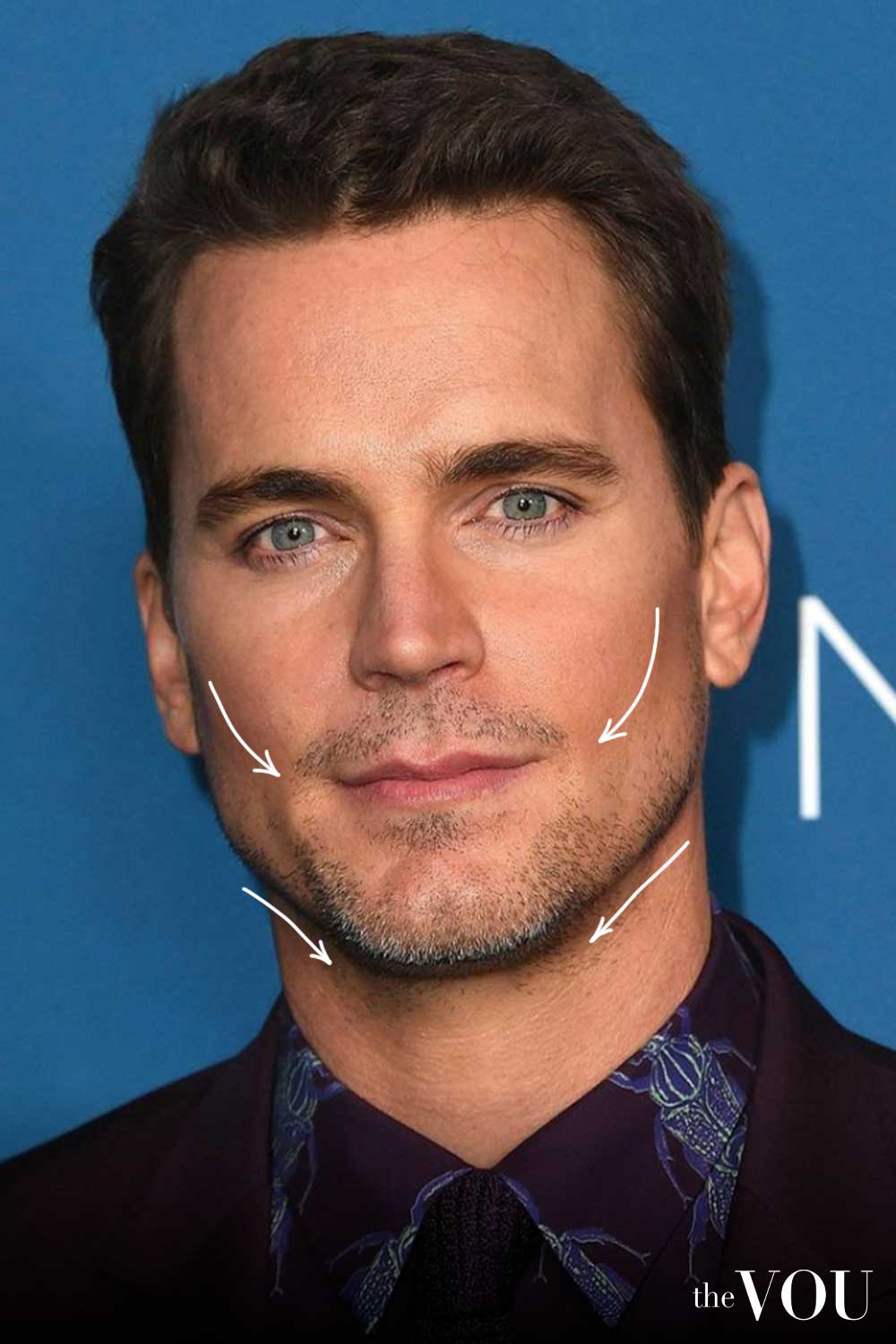
Consider a Tapered Short Beard (5-8mm), Chin-Focused Growth (4-10mm), or Minimal Line Beard (4-5mm) for sophisticated results that create balanced proportions.
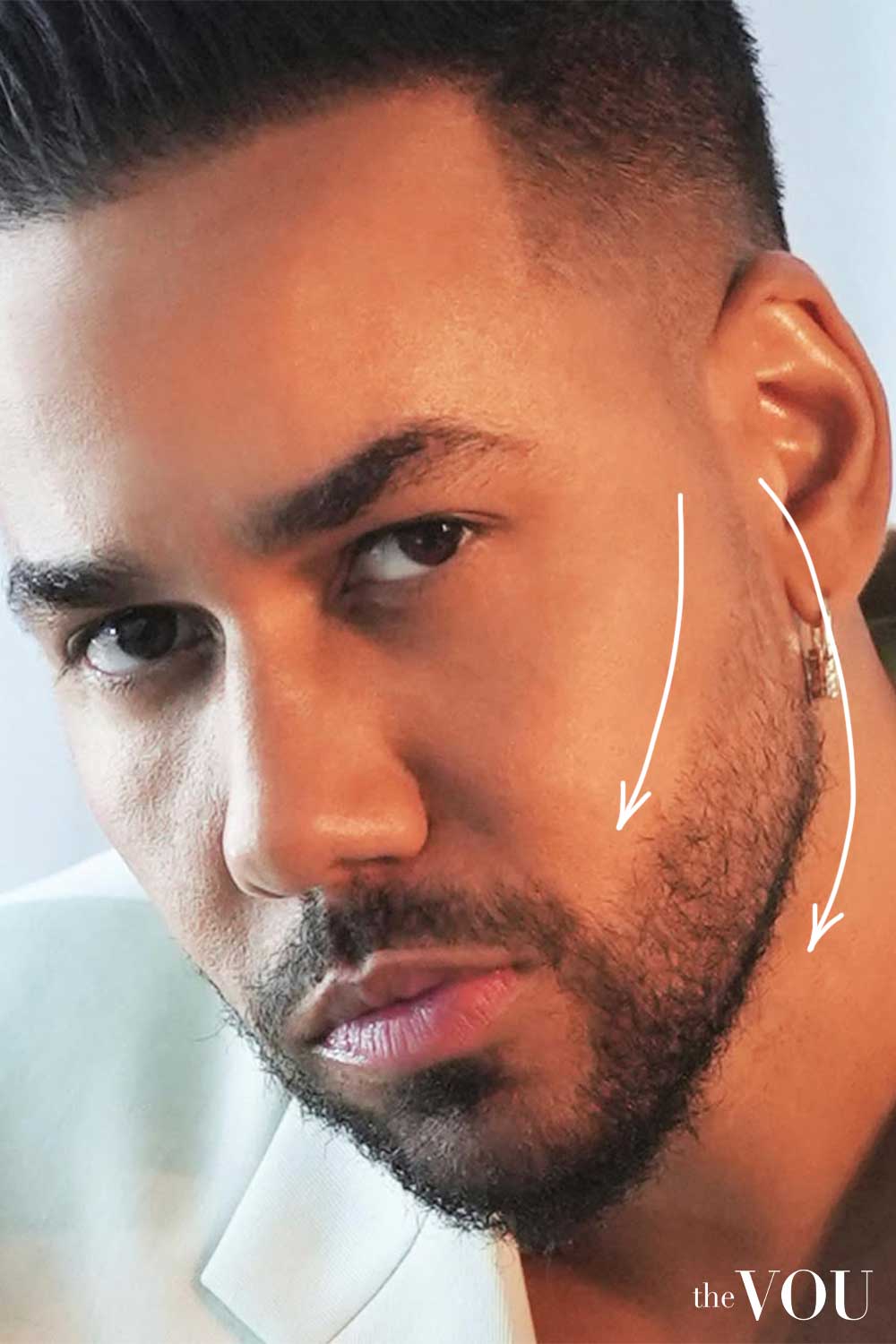
See more beard styles for Pear Face Shape
9. Diamond Face Shape

Picture a traditional diamond – this shape captures the essence of faces defined by prominent cheekbones.
Diamond faces are also known as angular pointed faces, cheekbone-dominant faces, narrow forehead shapes, or model faces.
The key characteristic lies in the cheekbones being the widest point of the face, with both the forehead and jawline tapering to create narrower points.
The most striking feature is the dramatic angle at the cheekbones, creating clear definition and sculptural quality to the face.
Robert Pattinson, Ezra Miller, Jared Leto, and Zayn Malik are the best example of public figures who demonstrate classic diamond face characteristics.
Diamond faces often appear most angular when viewed from the front, with striking bone structure that’s prized in the modelling industry.
A diamond face shape can appear particularly sophisticated, though many men prefer to soften their angular features through styling choices.
Ideal Haircuts for Men with Diamond Face Shape
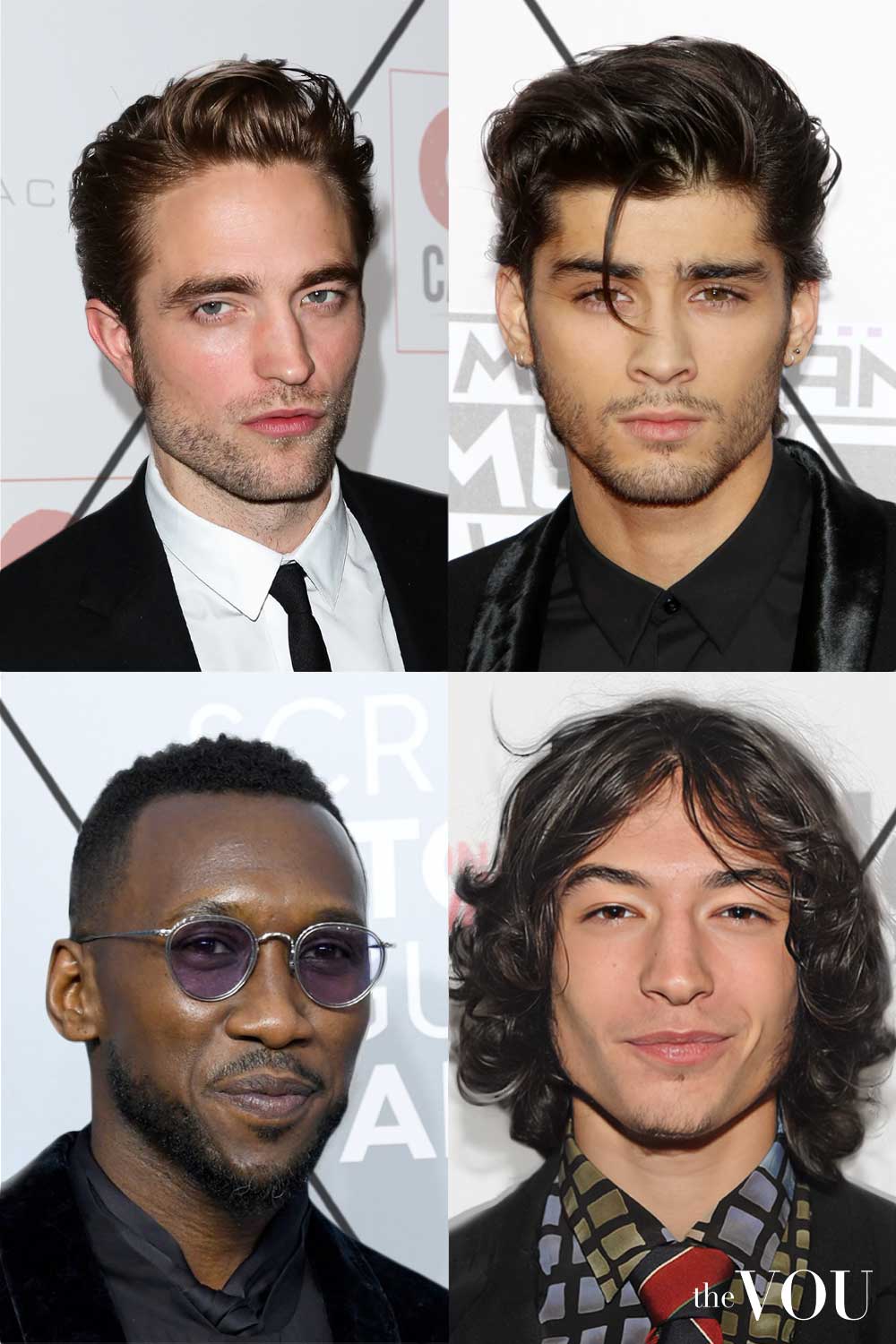
Diamond faces like Robert Pattinson’s benefit from styles that complement their striking cheekbones.
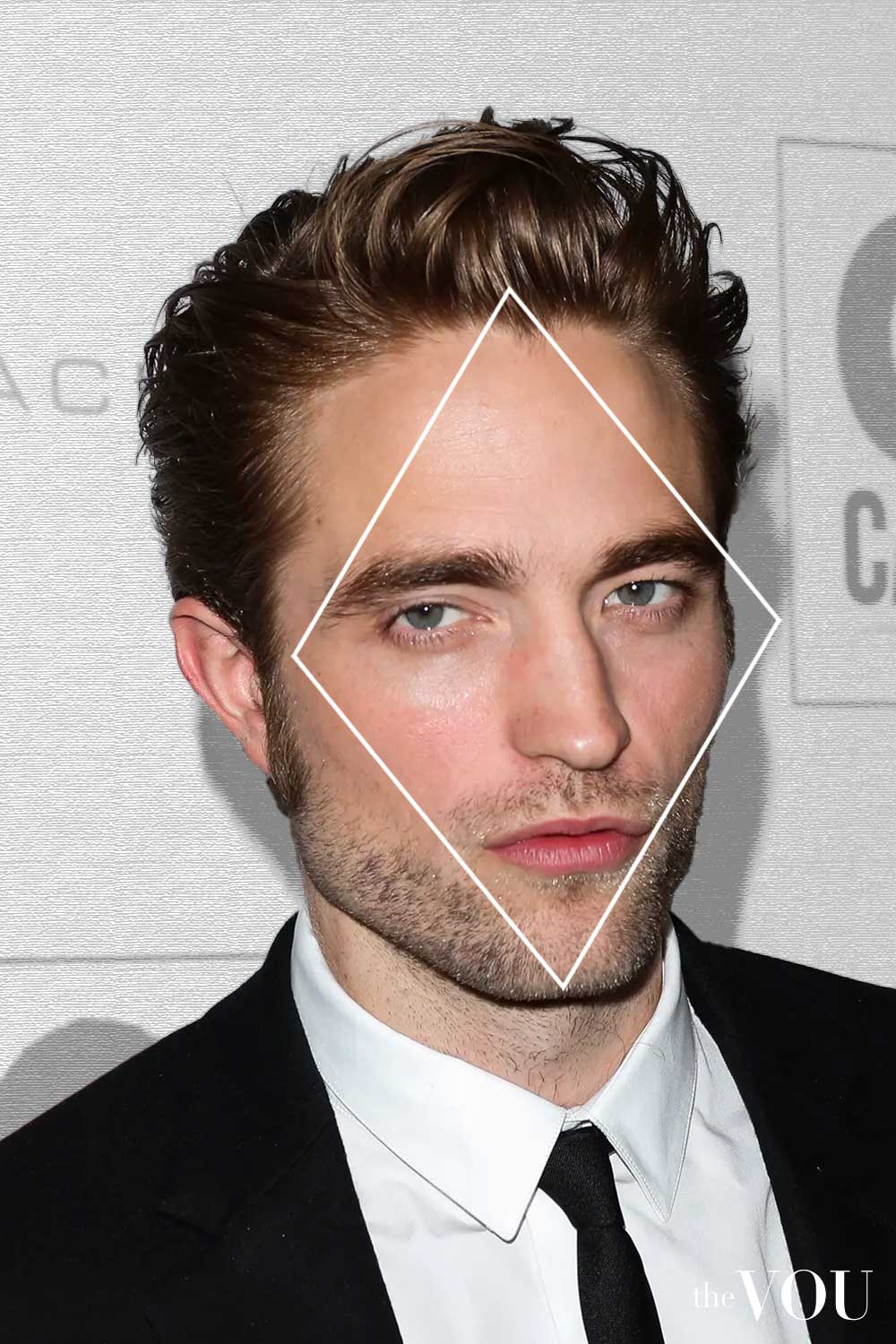
Cuts that add width at the forehead and temples create balance, while textured layers enhance your natural bone structure.
Zayn Malik’s approach to hair styling perfectly demonstrates how to work with this distinctive face shape, adding volume where needed while maintaining an elegant profile.
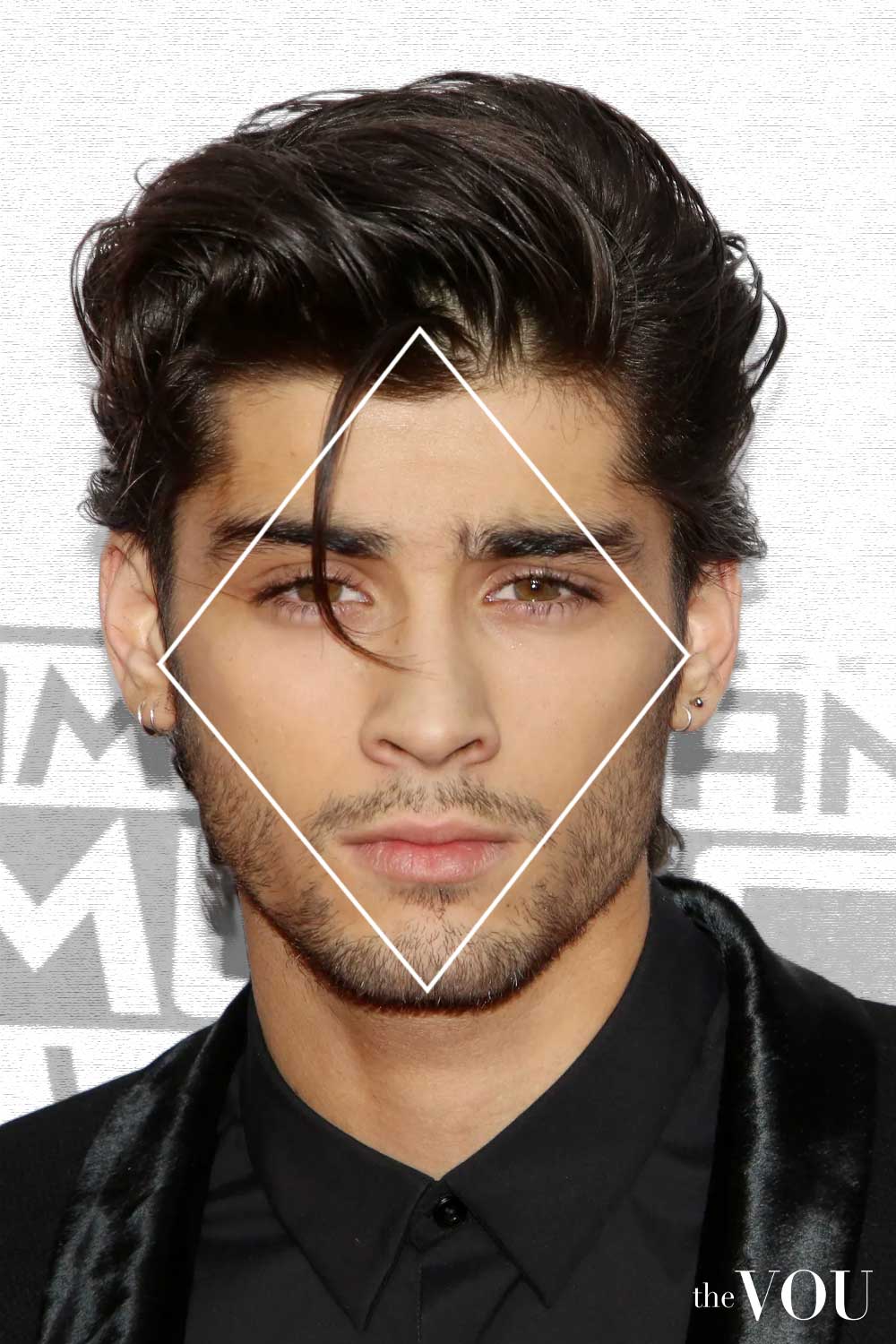
Consider styles that soften your angular features while highlighting your distinctive cheekbones.
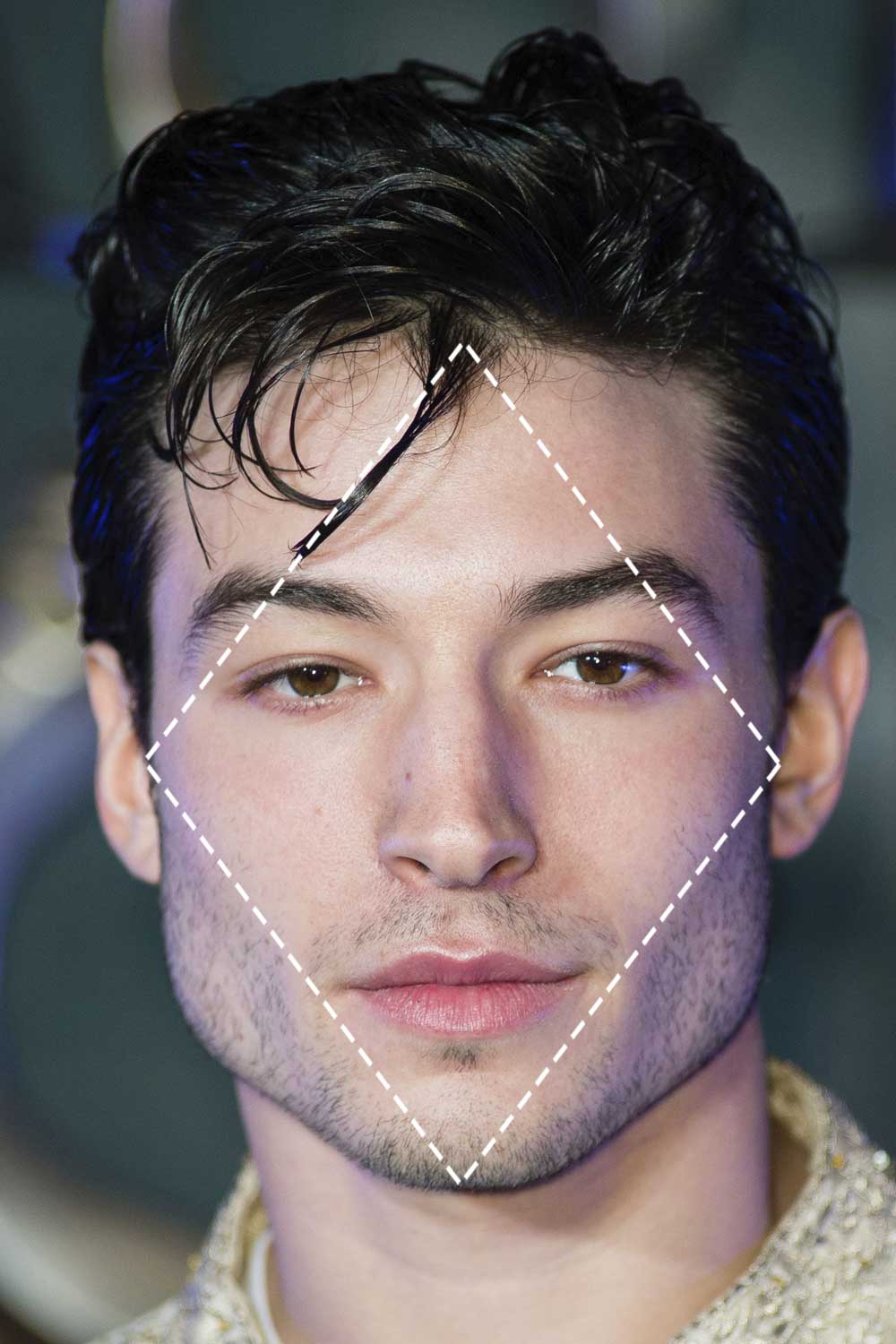
See more haircuts and hairstyles for Diamond Face Shape
Ideal Beard Styles for Men with MHairsDiamond Face Shape
Men with diamond faces, characterised by prominent cheekbones and narrower forehead and chin areas, require thoughtful beard styling to create balanced proportions.
The Full Square Beard (12-14mm) offers excellent width at the lower face, as shown by Zayn Malik’s approach.

The Graduated Full Beard, demonstrated by Robert Pattinson, creates harmony through strategic length variation.

Focus on styles that add width to the lower face to balance prominent cheekbones.
Consider a Extended Chin Beard (14-16mm), Structured Stubble (4-5mm), or Wide Box Beard (10-12mm) for sophisticated results that complement your distinctive features.

See more beard styles for Diamond Face Shape
Understanding Your Face Shape
Finding your face shape doesn’t require complex measurements or professional analysis.
While we’ve created a comprehensive quiz to help you determine your face shape accurately (link to our free face shape quiz for men here), understanding some basics can help you get started.
Your face shape might not perfectly match any category—this is normal and quite common.
Think of face shapes as guidelines rather than rigid categories, helping you make better styling choices rather than limiting them.
Face Shape Analysis Scientific Foundation
The study of facial proportions dates to ancient civilisations, where Greek sculptors employed the golden ratio to create representations of ideal beauty.
During the Renaissance, Leonardo da Vinci’s Vitruvian Man further explored the mathematics of human proportion, establishing principles that continue to influence the modern understanding of facial harmony.
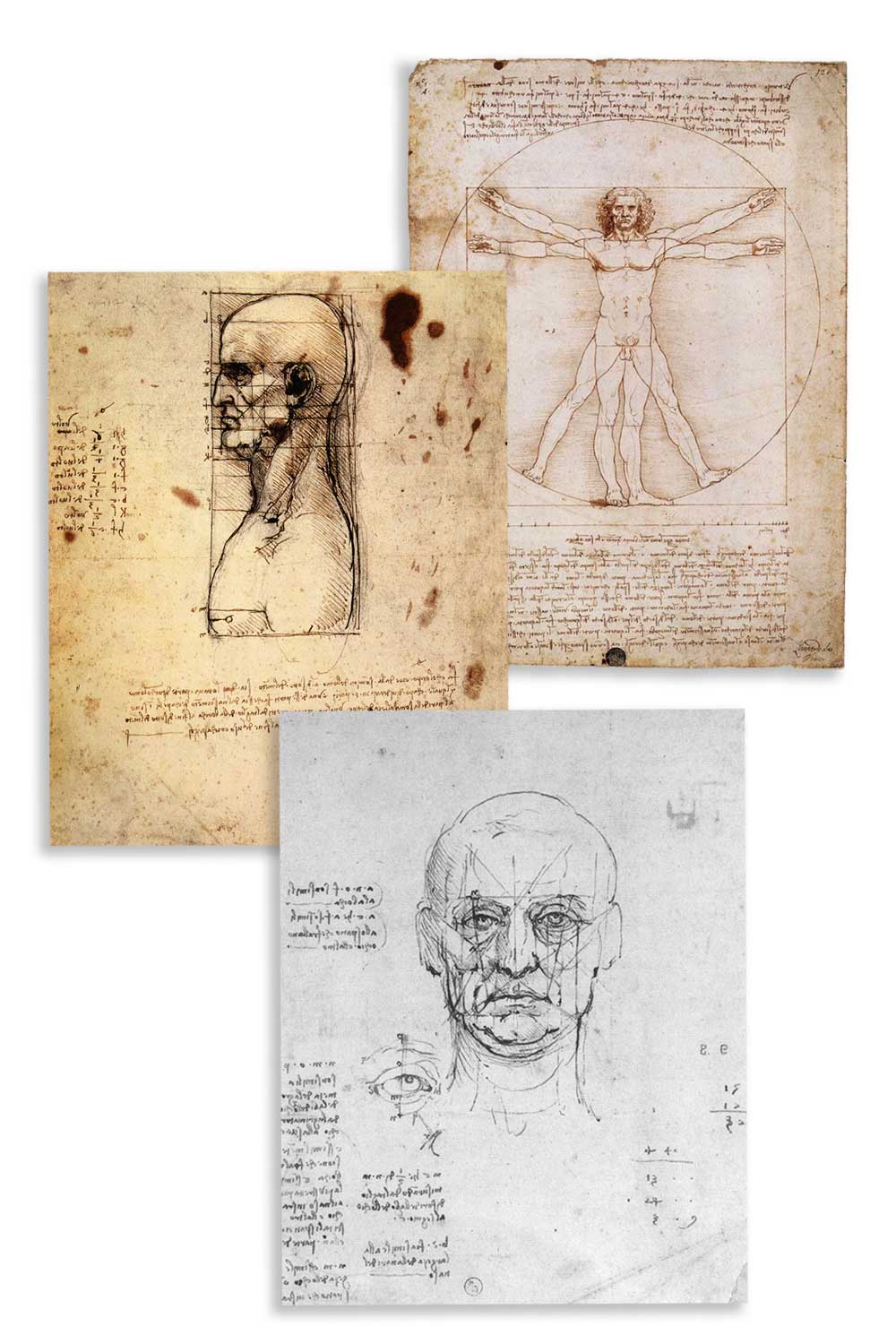
In the Victorian era, physiognomy – an approach that’s nowadays largely discredited – brought facial analysis into mainstream consciousness.
The early 20th century saw the emergence of more scientific approaches, with anthropologists and aesthetic specialists developing systematic methods for categorising facial structures.
This evolution culminated in the modern understanding of face shapes, which combines classical principles with contemporary styling expertise.
Modern facial analysis relies upon anthropometric measurements—the scientific study of human body measurements.
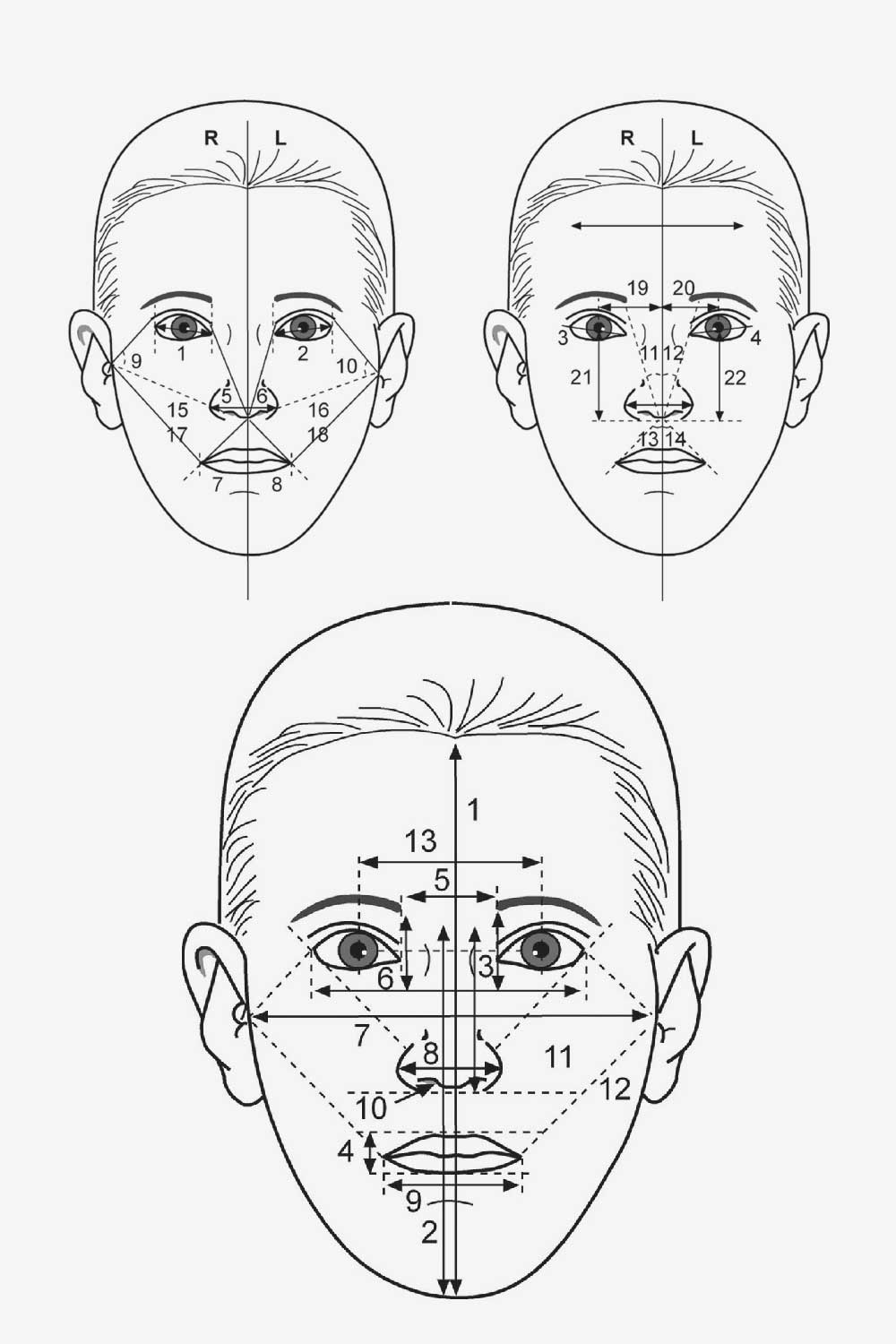
The discipline identifies key facial landmarks and proportions that determine individual face shapes.
Understanding these measurements is essential for medical professionals, aesthetic specialists, and style consultants.
The trichion (hairline) and gnathion (bottom of chin) establish facial length, whilst the zygoma (cheekbones) and gonion (jawline angles) define facial width.
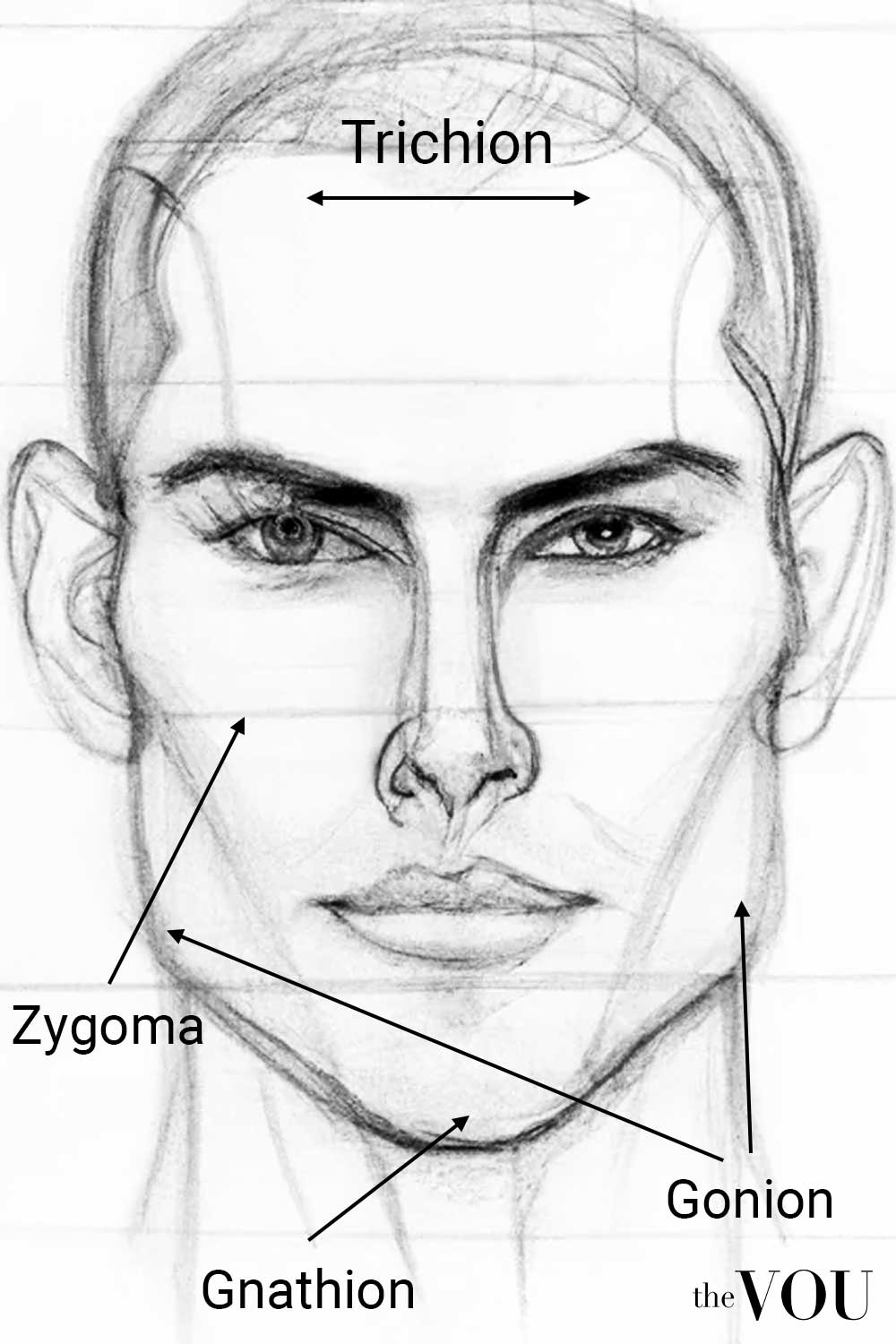
These points are critical in creating the framework for identifying distinct face shapes.
Classical facial analysis divides the face into thirds vertically: forehead to brow, brow to nose base, and nose base to chin.
Horizontally, the ideal proportion suggests the face width should measure approximately two-thirds of its length.
However, these proportions vary naturally, creating the distinctive characteristics of different face shapes.
Importance of Face Shape Analysis
Understanding one’s face shape extends beyond academic interest—it provides practical advantages in numerous aspects of personal grooming and style.
This knowledge influences decisions regarding hairstyles, facial hair, eyewear selection, and clothing choices, particularly necklines and collars.
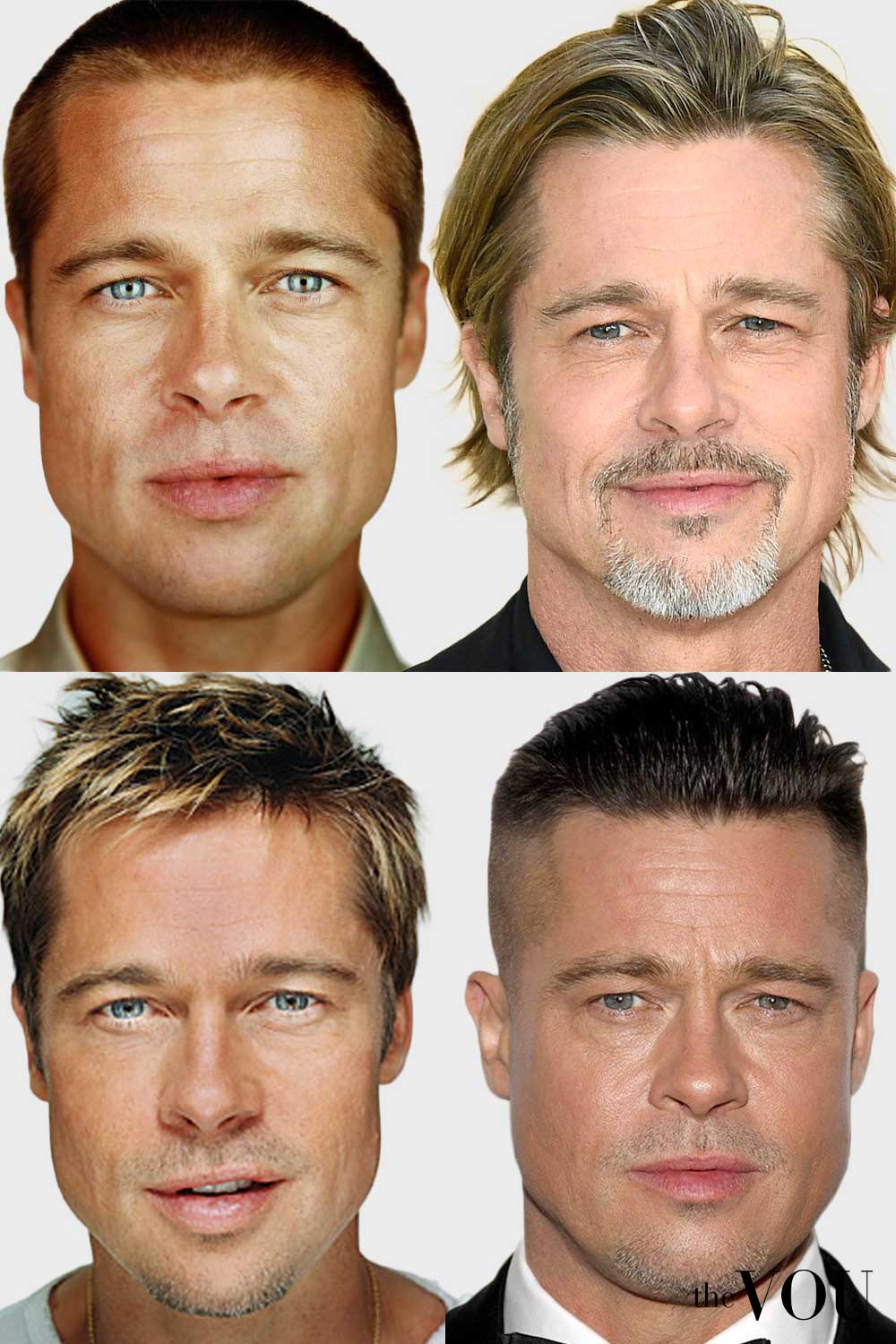
Professional image consultants and stylists consider face shape analysis fundamental to their craft.
This understanding enables them to make recommendations that enhance their clients’ natural features whilst minimising less desirable characteristics.
In the modern professional landscape, where personal presentation carries significant weight, such knowledge proves invaluable.
Despite its significance, face shape analysis suffers from several persistent misconceptions.
Many gentlemen incorrectly believe they must conform strictly to one category when in reality, combination shapes prove common.
Others mistakenly think face shapes remain static throughout life, overlooking the influence of age, weight fluctuation, and other factors on facial structure.
Perhaps the most pervasive misconception suggests that specific face shapes prove inherently more desirable than others.
Each shape presents unique advantages and styling opportunities, so the aim is not to attempt to alter your natural shape but to understand how to enhance it through informed styling choices.
How Face Shapes Change
Your face shape isn’t permanently fixed—it can change throughout your life for several reasons.
Weight fluctuations often affect face shape first; gaining weight typically makes features rounder, while weight loss can reveal more angular structures.
Age naturally impacts face shape as we lose facial volume over time—this is why some men find their round faces become more angular as they mature.
Facial hair can dramatically alter how your face shape appears to others—a well-groomed beard can reshape a pointed chin, balance a wide forehead, or add width to a narrow jaw.
Even muscle development through activities like chewing, mewing, or facial exercises can subtly alter your face shape over time.
Working with Combination Face Shapes
Many men discover they have characteristics of multiple face shapes—for example, a face might be oval with slightly diamond-like cheekbones.
The most common combinations include oval-diamond, square-rectangle, and round-oval variations.
Instead of trying to fit strictly into one category, identify your strongest characteristics and use these as your primary styling guide.
Consider which features you’d like to enhance or balance rather than worrying about fitting perfectly into one face shape category.
The Role of Proportion
Understanding your face’s proportions matters more than fitting into a specific category.
Consider the relationship between your forehead, cheekbones, and jawline—these proportions guide your styling choices more than any face shape label.
Think about your face’s width-to-length ratio, as this helps determine which styling approaches will work best for you.
Remember that your hairstyle, beard, and accessories can adjust your face proportions and help you create a desired effect.
Styling Recommendations by Face Feature (Pro Tip)
Rather than following strict face shape rules, consider your specific features:
Strong jaw? You might benefit from styling tips for square and triangle face shapes, regardless of your overall face shape.
High cheekbones? Look at recommendations for diamond face shapes, even if that’s not your primary shape.
Wide forehead? Heart shape styling tips might work well for you, even if the rest of your face follows a different pattern.
Long face? Incorporate advice for rectangle shapes while still considering your other features.
Truly sophisticated styling goes beyond just understanding your face shape. At The VOU, we recognise that face shape analysis is just one component of a complete image transformation.
Our Professional Face Shape Analysis package provides you with a scientific analysis of your exact face shape, personalised hairstyle recommendations, customised facial hair styling guide, expert eyewear selection guidance, and detailed grooming recommendations tailored to your unique features.
However, for the most comprehensive transformation, consider our Complete Image Transformation Package.
This premium service includes our Professional Face Shape Analysis, Seasonal Colour Analysis, Body Shape Analysis, Fashion Style Analysis, Wardrobe Curation Guide, and Personal Brand Development.
Through this complete package, you’ll develop a cohesive style that communicates success and sophistication across all aspects of your appearance.
Hailing from Miami Beach, Sean Flynn is a NY-based celebrity professional hairstylist specializing in classic haircuts for men but in custom colors. Drawing on a lifetime of hair salon moments of combining fashion, art, and style, Sean is often featured in prestigious styling magazines, including GQ, Forbes, New York Times, and of course, The VOU.
With years of expertise in high-end fashion collabs and a PhD in Sustainable Fashion, Ru specialises in eco-luxe wardrobes for the modern gentleman seeking understated refinement.
With over twenty years of front-row fashion and styling events, collabs with haute-couture houses, and a PhD in Luxury Fashion, Laurenti is an expert in crafting personalised looks that depict old-money sophistication.


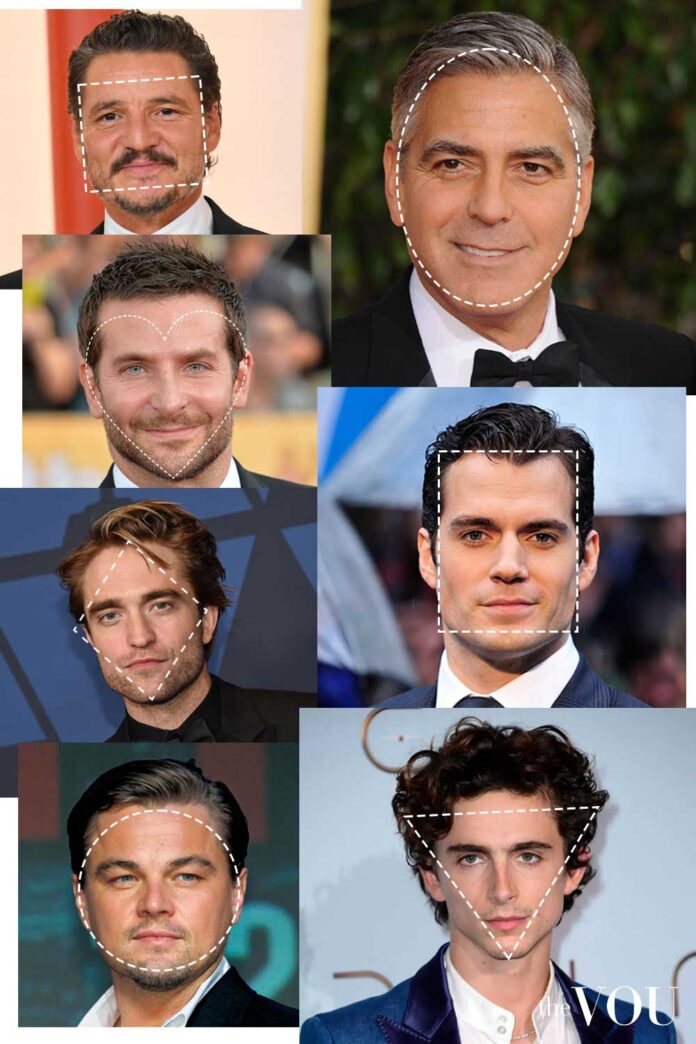
Cool